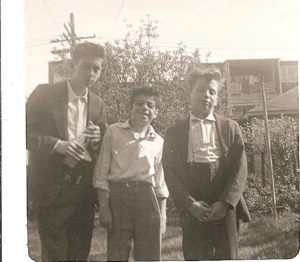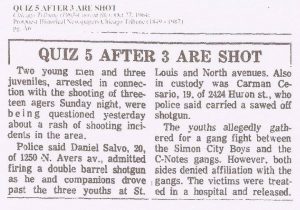Ah, the white gangbanger, something people often talk about with a smug grin. The vision of the white gangbanger is usually that of a young man or young woman trying to be something they aren’t while living in a fairly safe community far from the real action on the streets of the major city. We think of goofy white boys similar to the movie Malibu’s Most Wanted or White Boyz and often paint our mental image of the white boy gangster after these wannabe toughs. We envision him or her to talk with slang that sounds not matching of who they really are sounding goofy as they act real tough and unpredictable. Those in the community they live in know where they live and the home life usually isn’t that bad with a two income household behind a picketed fence, some would call that “privilege.” Yet when you talk to this white gangbanger he or she will make their life sound dangerous and crazy and like they have no choice but to be in a gang. The vast majority, if not nearly 100% of white gangbangers in the Chicago area reside in the suburbs or at least in very affluent neighborhoods in the city that border the suburbs. The white gangbanger of today doesn’t come from the hardened ghettos or the roughest communities in the city where the murder rates are high. The white gangbanger doesn’t even come from hardened suburban areas either like Harvey, Robbins, Ford Heights or even the rougher east side sections of Joliet. There are of course exceptions to this but very few indeed. For the most part, the white man doesn’t need to be in a gang at all as of the very late 20th century and 21st century. Now imagine a time where the white man found much more necessity to be in a gang. This was a time before he needed to put on an act trying to mock another culture feverishly. This was a time when the white gangbanger lived hard and rough, perhaps even lived in the slums. This was a time where he had to fight his way across the neighborhood just to get to the store or had to join a gang in order to hang out with several people. This was a time when the white gangbanger would kill and commit several savage crimes instead of just talking about it. The white gangbangers of the 20th century were hard, vicious and were packed into the penal system as many of them were just as dangerous as Hispanic and black gangbangers; many times the white gangbanger was worse. This is a forgotten era and began to be buried in the 1990s which just so happened to be the time when the rest of this country really started to understand anything about gangs. People began to become more educated about gang culture and more books and movies flew off the shelves but by then it was too late as the true white gangbangers had mostly left the city. There are still some very down white gangbangers out there in the city and suburbs but it is much harder to find than ever, especially after the year 2000.
Early slum dwelling white gangs of Chicago
On my write up titled “Organized Crime to Folk and People Street Gangs” I laid out the history of how gangs first developed in Chicago and where gangs first started. Back in the 19th century Chicago was a white city with very few African Americans and far less fewer other races of people. This was a time when the most discriminated ethnic groups were Irish, Italian and Jewish people. These were the first slum dwellers living in the worst conditions imaginable. Hard living was growing up in the Cabrini Green area (Before the projects), the Near West Side and the Back of the Yards. These were the toughest slums in the city and happened to be home to a majority Irish, Italian and Jewish population.
The Jews weren’t really the biggest gangbangers in the city, it was mainly said that Italians, Irish and Polish had the most ferocious gangs and were the most gangbanging ethnic groups back in the 19th century and early 20th century. Although the Polish were pretty wild gangbangers in these days the most ferocious of all was the Irish and Italians. The Italians and Irish rose to put together organized crime groups as younger generations of Irish and Italians joined organized crime farm gangs. The Irish ruled the slums of the Back of the Yards and a major piece of the Near North side Cabrini Green area slums. The Italians owned the other parts of the Cabrini area slums and a major piece of the Near West Side slums. The Irish also dominated the majority of the rough and tough Bridgeport neighborhood and nearby Canaryville in the New City neighborhood. These were areas that were gangbanging from the 1850s all the way through the 20th century.
For the longest time these areas of the city were the only areas you would encounter gangs and for the most part they were not a big deal and seldom anyone was killed or seriously hurt by gang violence at least not on record. Tales were spun of murder and access violence in this area, but the details were mostly shunned from the public. Many times their biggest crimes were petty theft and fighting in the streets. The fighting could become vicious as they often restricted each other from moving through certain areas of the neighborhood. For the most part the city didn’t care about the activities of young hoodlums and police often let them be since they were keeping all their actions in the neighborhood.
I can’t say for complete certain that things were that much better back in the 19th century and the early 20th century because the crimes and actions of gangs were often under reported and under investigated due the public’s lack of interest in the slums; however, many books and tales tell of crime and crazy issues in these communities but seldom speak of teen gangs. There were killers and several murders in these communities as police were often terrified of criminal groups but it appears the worst crimes were credited to older adult groups and syndicates and not to teen gangs. There is very little history or personal accounts that point to wild teen groups. But according to a Chicago Tribune article from November 13, 1913 youth gangs in the slums loved to steal and rob businessmen. The article outlines a lot of the direct cause as boredom as these slum areas often offered no recreation for children; therefore, at the age of 10 they turned to hanging out with other boys that led them to reckless behavior. The most dangerous activities these young boys seemed to do was to rob people which can be a scary situation, but this was the hardest crimes young boy gangs engaged in.
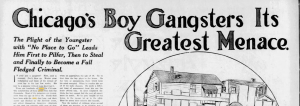
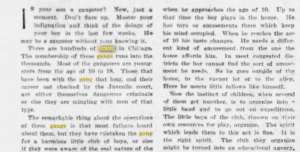
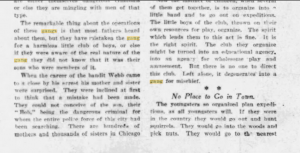
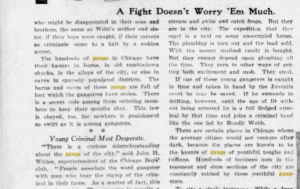
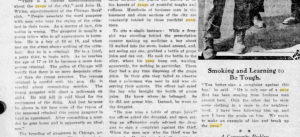

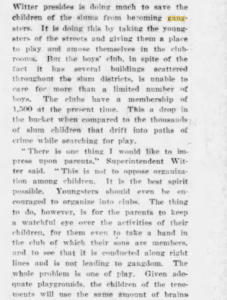
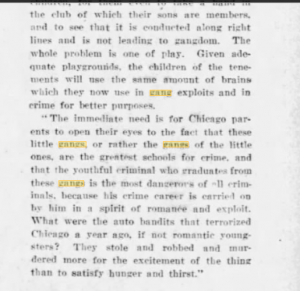
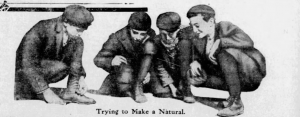
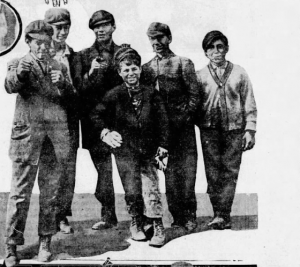
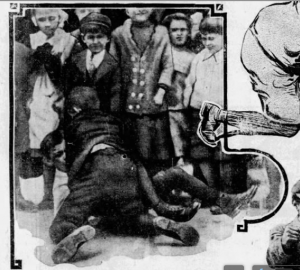
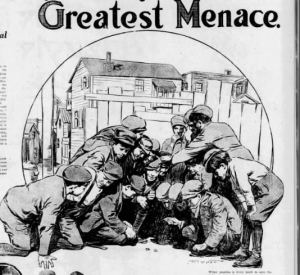
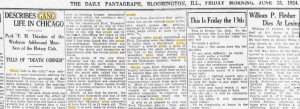
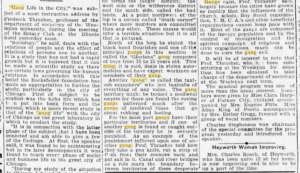
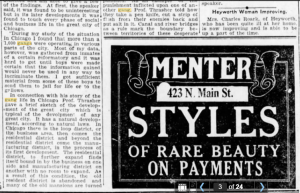
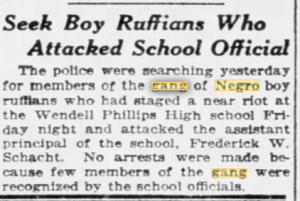
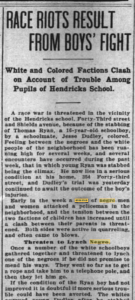
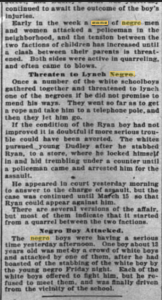
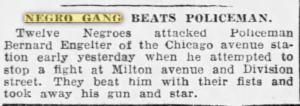

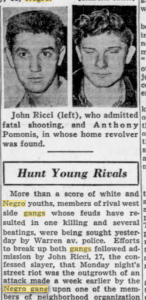
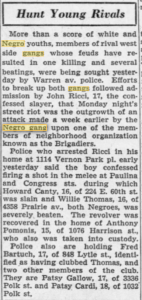
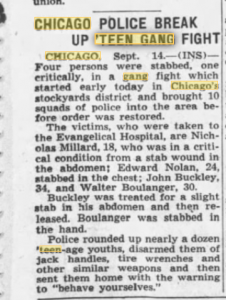
As you can see in the above articles, gangs could get quite nasty back in the old times as the 1924 article pointed out that a certain gang of boys slices off a chunk of flesh from a rival and pours salt on it. Even though these groups could get wild there seems to be not much of a link between bands of teen gangsters and murders, not only that the gang activity was confined to four neighborhoods among the whites. The black gangs didn’t start until 1919 in the Bronzeville area but these gangs were not as dangerous and often took on a defensive role against rival white gangs.
The beginning of the biker and the early greaser influence
After World War II gang activity took a sudden major spike in Chicago and this has left many researchers over the years in a state of mystery. We can attribute many causes of this, I outlined some of it in my piece “Organized Crime to Folk and People Street Gangs” but I have come into new research and new developments since then that can explain how the issue developed outside of just racial issues. Before race was a major issue there was a cause of all of the later 20th century gangbanging and it is along the lines of influence. The biggest influence of the American greaser, including the Chicago area, was the American biker. First, let’s get into a little history on biker clubs.
The first motorcycle club in the world was the Yonkers MC which formed in New York City in the year 1903. From that organization came the first federation of motorcycle clubs even before there was any other clubs besides the Yonkers groups, this federation was the F.I.M or Federation of International Motorcyclists started in 1904. Shortly after this was put together another club was formed on the opposite coast of the U.S. called the San Francisco Motorcycle Club started in of course San Francisco in November of 1904. Motorcycle clubs got a touch of popularity in California in the 1900s decade after two more clubs appeared in the year 1907; the Oakland Motorcycle Club and the Pasadena Motorcycle Club. In the year 1924, the American Motorcycle Association was formed that still exists today. This organization charters motorcycle clubs making them official on the books making it easier for them to officially register for national motorcycle events.
Before World War II motorcycle club members looked like everyone else in society and were often law abiding men that worked full time jobs and had families. Their motorcycles only came out on the weekends when they attended events and it was for weekend leisure or sometimes they participated in racing events but there was no criminal activity associated with biker clubs. Bikers didn’t even have a certain way of dressing back in these days and it wasn’t until 1928 when the Perfecto biker leather jacket was invented by Irving Schott and it was by no means a fashion statement, it was only used for the practical purpose it was invented for.
The first significant motorcycle club in Chicago area was perhaps the McCook Outlaws that formed in the suburb of McCook in 1935. The Outlaws, just like all other motorcycle clubs at the time, did not engage in any criminal activity and perhaps their wildest exploits were throwing drinking parties, but they were mostly all about riding motorcycles for expeditions or in competitions. For the most part the Outlaws were no different than any other motorcycle club around the country back in these days. Many of times motorcycle clubs adopted intimidating names or developed intimidating symbols but this still didn’t mean they were criminal groups, it was ideas that spun from military symbols where pilots would often paint intimidating symbols on their planes or maybe certain military units used such symbols as patches on their uniforms.
It wasn’t until after World War II that the biker bad boy image emerged but it goes painfully deeper than just a fashion statement or a way of acting. Clubs like the McCook Outlaws and other MCs across the country often kept themselves going during the war either by members that didn’t participate in the war or guys that participated and returned home during the war perhaps from wounds or other reasons. The McCook Outlaws put themselves right back together after the war and even rode on to Soldier Field in May of 1946 for a major motorcycle event showing that they were a well put together club. Many of the guys in the club had served in the war and some had seen some combat. This was the case with many pre-war biker clubs that had members coming home, they had fought for our country and had physical and emotional scars they carried with them.
We all know about the traumatized Vietnam veterans and many also always associate PTSD with Vietnam vets and later, but the truth is PTSD has been around rampantly since the Civil War. Ever since more modernized warfare was invented with roaring cannons and heavy guns, automated guns and hand held explosives it left troops with a horrible sense of helplessness during massive periods of heavy gunfire and bombardment that can maim and crush the human body and break one down mentally as they wait helplessly for artillery fire to finish wild bombardment. The use of chemical warfare and deadly gasses terrified many troops to the point where some of them had PTSD specific issues centered around exposure and experience near gasses and chemical weapons. In the 20th century wars, several sentries posted on battle fields with heavy duty machine guns that had the power to tear through several human bodies in the swipe of a motion ripping off limbs, tearing chests open and brutally tearing apart delicate human bodies as friends watch in agony as their comrades parish in a blood bath. These images scar men far more than the battlefields of the ancient days where men fought freely through battlefields wielding axes and swords. There was more control back in those primitive times where men could navigate through the field of battle and protect themselves as they fought their enemies savagely. The psychology of waiting helplessly across a front line or in a trench hoping bombs don’t blast you to pieces or a machine gun cuts you down deeply borrows itself into the human psyche much more, hence, why PTSD from combat is much more common in modern years. Then again, the stories we read about from hundreds of years past of crazy drunken kings and knights that displayed crude and savage behavior almost makes one think that perhaps all those ax wielding battles they savagely fought it may have made them a little touched in the head but the world was not ready to dissect such an issue in detail for the purpose of psychology and studying the human mind in the face of combat in those dark times, so we may never know the extent of psychological damage during primitive combat.
The first two world wars had a very devastating effect on the human mind and many cases of “shell shock” were reported but many men swallowed such issues when they came home because nobody wanted to talk about it. Not only did none of the vets want to talk about it the world didn’t even want to hear about it. It is hard to believe that in these days society actually had a harsher approach to men that suffered mentally and either regarded them as something to fear or inadequate or maybe be viewed as a complainer and deserving of such trauma because that was their job at the time, to face combat and deal with it. Men were also under heavier pressure during these times to keep their emotions or sorrow and pain in check and be the headstrong provider of the households and this kept them silent as they tried to return to normal life. Little did America know these men suffered greatly inside their minds and it goes beyond simply having nightmares and ducking down when fireworks go off. PTSD issues came out in other ways as some vets took up heavy drinking, drug use or became more violent by nature. Sometimes you see the image of the 1950s father beating on his wife and kids after downing several beers or a bottle of whiskey and there may have been a time when that man was not so violent and perhaps didn’t even drink but when he came home from the war…he changed. These are just examples of how some vets had some issues when they came back. Not every vet handled PTSD or war trauma the same, but one thing combat vets all did have in common was difficulty adjusting back to civilian life after living an intense and seemingly long life of killing and survival as a norm. Now vets needed to come back home where people are more sensitive, where killing in wrong and illegal and where you didn’t have the freedom to do as you please.
One activity some of the vets fell in love with during the war was riding on those Harley Davidson motorcycles. Troops used to love joy-riding across the countryside in France or other countries, sometimes while drunk as a skunk. There was nothing more stimulating then whipping through the countryside with the fresh air blowing in your face. This was a great way to blow off steam and relax yourself after spending periods of time fighting for your life and watching your friends die all around you. Troops bonded with each other deeply during war time and some bonded with the Harley bikes too. When the guys came back from the war they missed those bikes and missed the bonding they had with fellow troops, this is when many sought out bonding with both back at home.
For the groups like the Outlaws it was easy to return to the club and to their bikes as they already had a club and bikes before the war. For other guys that never owned a bike and were not in an MC before the war they had to find nearby clubs to join and a bike to purchase. What many guys started to find out when they joined these clubs was many members both experienced members and new members were veterans as well as being a veteran and being a biker seemed to go hand in hand. Memories of riding that motorcycle through those foreign countrysides were reminiscent of freedom and escape and now that feeling was needed more than ever after returning to a society of morals and laws and people that didn’t come from where they were coming from mentally. New clubs also started up right after the war like the legendary Hell’s Angels Motorcycle Club out of California that were a gathering of many war vets coming home to ride together. Not all of these clubs were made of vets but a very large portion of members were returning vets, many of which carried heavy burdens of the war and PTSD that they swallowed or chased down with a bottle of booze. Society looked at shell shock cases as loony type of guys that perhaps needed to locked away in a nut house. Back in those days if there was help offered it was often harsh like institutionalization or at least a belief that will happen.
The new biker craze began in 1946 as sales of motorcycles began to go way up and new MCs were popping up all over the country while pre-existing clubs like the McCook Outlaws suddenly had many guys wanting to join the club, many of which were war vets. Before you knew it bikers were popping up in many towns and in Chicago there were biker clubs sprouting up all over the place too but none like the Outlaws. Teen boys had eyes and ears to all this activity as they watched these men thunder through towns and cities clad in leather jackets as the bikes sounded powerful and fierce. The leather jackets looked rebellious and cool even though this was not the intention of the bikers of 1946 but young boys thought it was cool. The young men and boys also watched as the bikers gulped down beers and attracted women at the local bars as these guys looked like they were having a good time not knowing that many of them had demons they were battling and were trying to find an outlet. Many of the new bikers were boys themselves of only 19 or 20 years old that fought at the end of the war or perhaps just gained membership into the clubs.
In the year 1947, more men returned from the war as many had to serve up to a few years after the war until enlistment was complete and the biker clubs grew more in size and new clubs were being chartered. One event happened that summer that really pushed the biker image further. During that summer of 1947, an annual motorcycle rally in the town of Hollister California that had been held since the 1930s had finally returned after being stopped because of the war effort. This event suddenly had a massive unforeseen jump in participants. What was usually a small rally in the 1930s of racing events and socializing turned into a major party with thousands of bikers in attendance. The small town couldn’t handle the event. The town’s population numbered 4,500 at the time but now they were overwhelmed on July 3rd with 4,000 guests and soon it got wild. The bars couldn’t handle all these bikers and there was a major housing shortage as bikers needed to sleep anywhere including the streets and on lawns. There was tons of alcohol consumed as many bikers became rowdy and several fights broke out turning into chaos but in a mostly fun way. The celebration and wild partying continued on through the 4th of July weekend until is wound down by the end of that weekend. The town wasn’t angry and only reported minor damage. The bikers didn’t harm residents only each other but the newspapers blew up the story into seeming like wild gangs of bikers were going to take over the streets. Newspapers told stories of terror and wild, massive destruction terrifying the public. A photo of a man named Eddie Davenport was plastered on the San Francisco Chronical and Life sitting on his motorcycle leaning back with a beer in hand with several empty beers near his tires. His facial expression was all rebellion as if he didn’t care what anyone thought. This photo became the symbol at the time of what being a biker was all about, showing being a rebel in society while partying as hard as you wanted. What people didn’t know is it was likely the photographer told Eddie to put all those beer bottles by his bike to make it look like he drank them all, thus, adding to the hype; the press really blew this whole story way out of proportion and it salted the public’s image of bikers forever. Not only did it salt the biker image it also bred a counter culture of rebels as these words printed in the paper and these images crafted an ideal lifestyle not thought of until 1947 and now biker clubs would soon adopt.
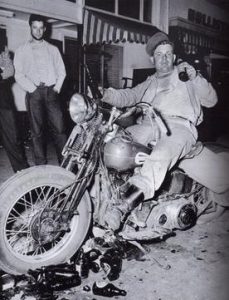
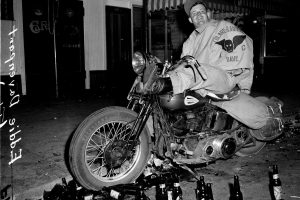
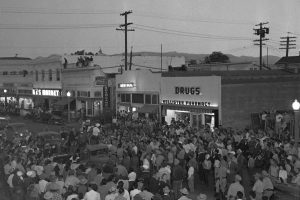
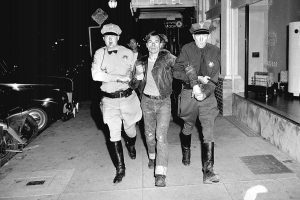
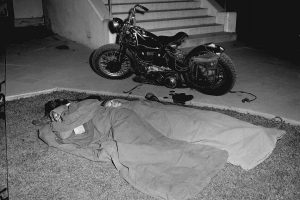
Teens all over the country would also read all about the Hollister Riot and inspiration was not only felt by future and present bikers but also by the teens who soon began to adopt biker styles like the biker leather jacket. For centuries children dressed like their parents with drab fashion or no fashion at all, but now this became a time where teens wanted to dress in their own way after the war. Boys fell in love with the hooligan look of the biker as it made them look dangerous and wild; it was 1947, the year the greaser fad began. Blue jeans cuffed at the ankles while wearing a biker leather jacket with a white tee underneath was the biker look and teens went wild over it when they saw it in the newspapers from the riot and soon they began mocking the fashion.
In the year 1948, the greaser fad grew as the biker culture grew simultaneously. The bikers were the role models for these teens as teens could now see bikers in action in some communities. More veterans were returning from service in 1948 and this helped fill the ranks of the biker clubs some more as clubs like the McCook Outlaws continued to grow packing Matilda’s Bar in the small suburb. This was the year the Hell’s Angels MC began in California which would later become the largest biker club in the world. More than ever both bikers and greasers were also adopting to wild behavior as they felt they no longer needed to conform to normal society. Since biker fights happened in Hollister now bikers took on this activity as rivalries began to grow.
1949 and the 1950s: The first generation of the greaser gangster
In the year 1949, as biker gang membership was growing and the greaser fad was growing as well, teens became increasingly rowdy. It all started with just a fashion statement, and for the majority of greaser kids it would always be a fashion statement to dress as a greaser but for some teens and young adults it was taken to a criminal level. These teens that had a thirst for danger and action learned not only from brawling bikers but also from teen gangs in the slum districts all about fighting in the streets for the affection of girls and for the best party spots. Now gang fights were popping up all over the city and no longer in just the slum districts. Increased teen gang brawling articles began in 1949 as public officials seemed very concerned or angered about the gang fights. The addresses of the combatants were from all over the city which is puzzling of how all these teens were able to network all over Chicago area to organize gang fights, regardless of the reason, gang fighting was growing in popularity and it wasn’t just for slum kids anymore. There were now kids doing this out of boredom or perhaps lack of discipline at home. Some may have been from rough homes in middle class areas where issues went on behind closed doors or maybe there was nothing wrong at home except parents were too light on their kids. It was also known that these roving packs of wild teens were venturing into black neighborhoods and beating on groups of black teens which would bring about the creation of more vicious black street gangs that needed to be tougher to protect their communities. Not only that, teens from middle class communities were battling with slum teens causing slum teens to strengthen their numbers and become more organized, there was definitely a cause and effect relationship brewing.



A new decade really got to the youth’s heads in America as they embraced the greaser culture much more now that it was 1950. As we all know, a new decade always makes people psychologically want to be a part of a new fashion era. With the rise of the greaser culture came the rise of greaser gangs which means the rise of teen and young adult gang fights. Now the gang fights were being taken to another level in 1950 as now reports of shooting deaths were filling the headlines. Fighting with bats, bricks, knives and brass knuckles now didn’t seem like enough as now guns were pulled. During this same year the Outlaws Motorcycle club now changed their name to “Chicago Outlaws” and moved their base to Little Village. It was said the original members became police officers and the club broke up in McCook but founder John Davis kept it alive with a new identity in Chicago and when they arrived they began the transformation into a 1%er type biker club. In Little Village Outlaws met resistance from the community which spawned the Gaylords organization that fought the Outlaws tooth and nail for a decade and a half. I am not positive if the Outlaws spread influence beyond the neighborhood in the early 50s very far but I theorize they did because of the ability for them to grow to several members in the Chicago area by the mid-1950s which likely means Outlaws were roving the city in the early 50s making teens want to mock their style.
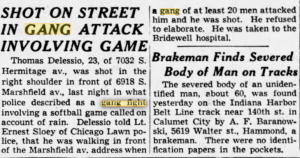
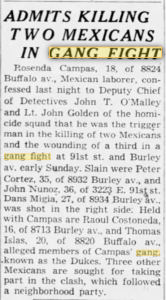


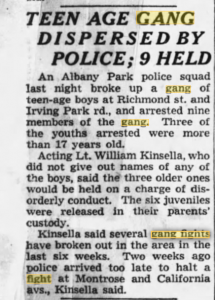
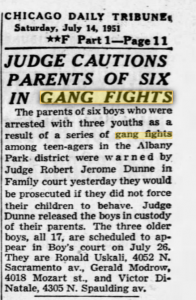
In the year 1952, more greaser gangs were organizing as some put together some pretty serious clubs, a couple that come to mind are the Noble Square area Gaylords and the C-Notes from close to the same area. These gangs still exist today which can tell you how organized they have been over the years especially the C-Notes that still also claim territory in Chicago. 1952 was also the year that all the greaser gangbanging caught on in the Chicago area suburbs as neighborhoods all over were reporting teen gang problems. I had found evidence of teen gang fights in Cicero, Berwyn, Melrose Park, Lisle, Riverside, Lyons, Elmhurst, Villa Park, Bellwood, Stickney, Forest View, Brookfield, La Grange and Oak Park and perhaps many more. Teens were coming together and networking across suburbia to get into mischief and organized gang brawls. There was some rivalry brewing also between Chicago greaser clubs and suburban clubs, perhaps because young men and teens came from the city to the burbs to scoop up suburban girls that suburban young men thought were their property. This is what greasers often fought over the most…girls, this is a known fact for greasers worldwide that they all fought viciously over courtship of young women. Some other times it wasn’t always about women it could have just been about being bored and starting fights, this was the beginning of a major social problem the Chicago metropolitan area now had to face.
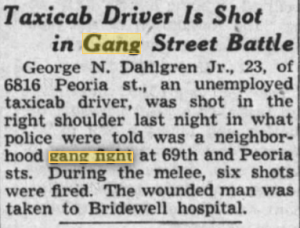

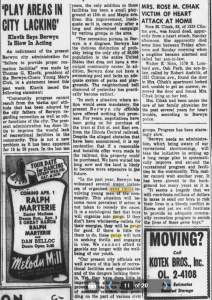
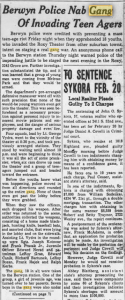
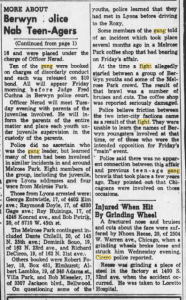
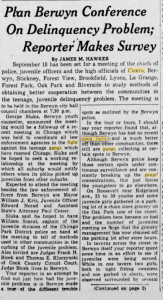

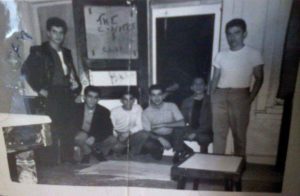
In the year 1953, the teen terror only worsened as more violence between gangs grew and more racial disputes happened which quite possibly led to the formation of such black gangs as the Egyptian Cobras. Two major teen gang brawls and terror incidents caused the city to take harsher action that year as the racial incident at the Trumbull Park projects and a brawl involving the Italian Sharks in Uptown made the city act. The city now began imposing curfew laws for teens to follow and holding parents accountable for their teenager’s crimes. When the boys acted up the parents needed to be there in court with them to face fines and other punishments. The city had had enough of the greaser teenage fights and this was viewed as a solution at the time, but little did they know this was only the beginning and soon it would all become worse. This was the year concerns had reached newer heights and the Riot Act was even being thrown at these teens to try and stop this.
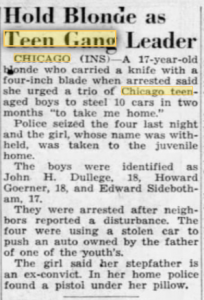



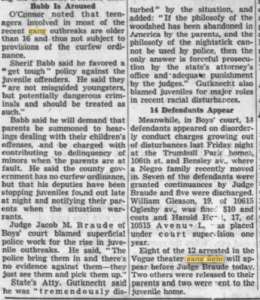


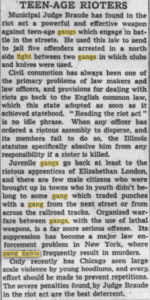

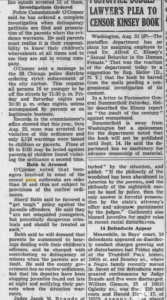
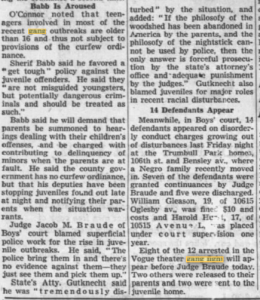



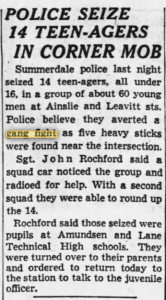
By the year 1954, some more key gangs first developed on the streets. By then organizations like Ambrose, Taylor Dukes, Imperials (Later known as Latin Kings) and Egyptian Cobras (Later known as Mickey Cobras) took formation in the Near West Side community. This was a neighborhood that was familiar to organized crime and Italian Mafia figures from when they were kids. Many mob guys started off as members of the notorious “42 Gang” that was the first very well-known Mafia farm gang for teens and young men before they graduated into the Chicago Outfit. Italian gangsters, both young and old, had always seemed to claim ownership of the Near West Side especially the coveted Taylor Street strip which was lined up with several Italian restaurants and shops with Italian families living above the stores or tucked around the corners. Italians were the last of the white population to stick it out in this neighborhood until the early 1980s when they at last gave up on Little Italy after the neighborhood became too dangerous and property values had plummeted tremendously until gentrification of the 21st century changed the area into a multi racial high income area. Italian gangs roamed these streets of Little Italy and other parts of the Near West Side exercising extreme dominance making many young Hispanic and black teens terrified until they finally fought back with some of the most notorious organizations in history. For the Hispanics they had Ambrose and Imperials, for the blacks it was Imperial Chaplains, Clovers and Egyptian Cobras then later Vice Lords. Gangs were getting tougher and meaner by this time; therefore, minority groups needed to fight back.
Issues were getting worse on the northwest side of Chicago as neighborhoods like Dunning and Jefferson Park were reporting several teen gang violence issues. In Jefferson Park police got tougher and even were swift to lock up parents of offending teens especially since parents often got in the way and yelled at police that their children were just being boys. On the south side in South Shore there were some very mean greaser groups that committed as severe of crimes as rape yet the parents of gang members gave the police a very hard time about it. A war was brewing between parents, police and teen gang members and the police were fed up so was the city. More gangs were forming entering the mid-1950s and more vicious acts were reported.

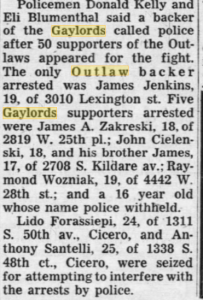



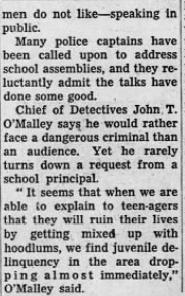
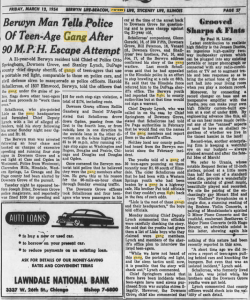
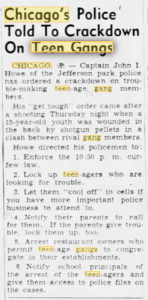

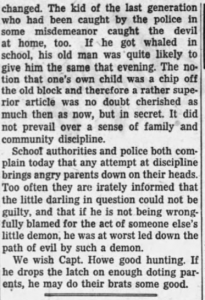
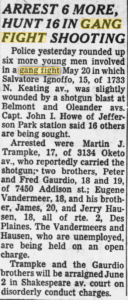
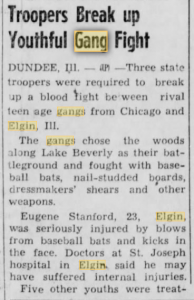
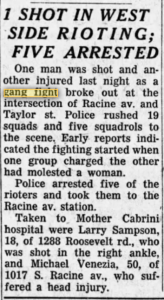
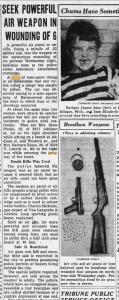
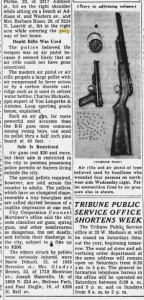

On July 1, 1955 the first teen gang murder made the headlines as a group of three car loads of teens, mostly from the Back of the Yards neighborhood, descended upon the intersection of 32nd and Morgan in the Bridgeport neighborhood looking for a rival gang for revenge. The gang had been looking for a few nights and on the night on June 29th they even fired a shot at that intersection but no one was shot. On this July 1st day the teens were back and one of the boys Clement “Cookie” Macis, only 14 years old, got too anxious when the boys spotted 4 boys standing at the intersection. Cookie pulled out a shotgun and opened fire on the boys as they drove past striking 17 year old Kenneth Sleboda killing him just outside the Old Dutch restaurant/store. Sleboda was not even in a gang at all and was mistaken for someone else. It was perhaps the first drive by shooting in Chicago history and the public was in deep shock that such a heinous crime could be committed by a 14 year old teen age boy. All boys were arrested for the crime and the world read one article after another about the shooting and about how Cookie’s own gang turned against him in jail after the shooting because Cookie acted too hastily and the gang was mad. They were especially mad that Cookie shot a kid they didn’t want to shoot. Not only did this story put a spot light on this case, it put a spot light on the teen gang problem city-wide especially in the Bridgeport area which was said to have some of the worst gangs back then where Bridgeport residents were even too scared to talk to police about gangs for a fear of reprisal. It was true that Polish and Italian gangs were indeed very ruthless in this neighborhood. Police officials were struggling with parent’s attitude that they shouldn’t be involved in their children’s behavior and that the courts should take care of it, or in other cases some parents didn’t want the courts or police to do anything to their precious sons.
This was the last time in history there could have maybe been prevention to stop the roving gangs of teens issue and the courts and police were probably correct that parents should have helped correct the behavior because the roving gangs were not only trouble in themselves they were causing gangs to form or toughen up in certain neighborhoods to get ready for roving attacks, this was how more organized and longer lasting gangs were being built, for example the Latin Counts that were created in 1955. One of the primary reasons the Latin Counts formed that year was to stop invasions of roving Italian gangs from other neighborhoods.

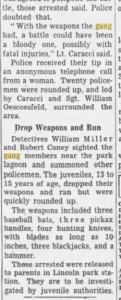


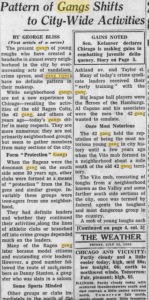
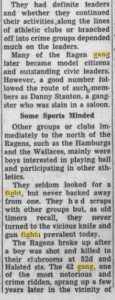
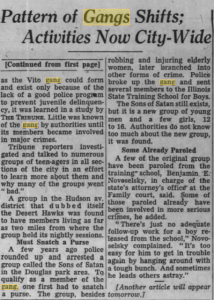
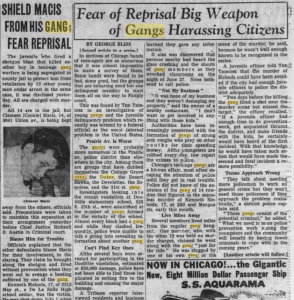
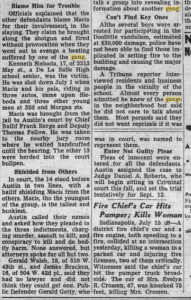

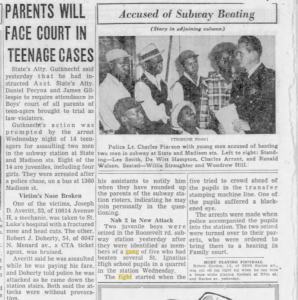
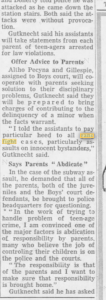
In the year 1956, another big story swept the headlines about a gang fight at Cornell Square in the Back of the Yards community that got out of control. At least two gangs met up for a fight, one being the notorious “Rebels” gang against another gang. The fight was nasty as one member of the Rebels was sliced in the face with a knife then two other Rebels were shot down, one was killed, the other badly shot. The gang member that shot the boys was eager to slay members of the Rebels because the Rebels were such a popular gang in the Back of the Yards with several members numbering in the thousands and they had a hell of a reputation for being tough. To boldly stand up to such a large gang and take one of their members out was a badge of honor. These articles swept the Chicago area as even teens read these stories and followed court proceedings. You would think this type of news would deter middle class kids from joining gangs because the kids got caught and got stiff sentences but instead it had an opposite effect as several teens from all over the city and the suburbs swarmed to the Rebel’s headquarters at Spike’s Candy store at 51st and Wolcott wanting to gain initiation. The Rebels were perhaps Chicago’s first super gang as there were almost no gangs back then that outnumbered 100 members and if they were that big they were just roaming packs. Once again rebellious deviant groups were making the news and kids became incited to join gangs and take on the fashions. Their parents didn’t pay attention to the affairs of these youths and let them join these clubs and drive around the city looking for trouble. remember the old saying “boys will be boys?” well that saying was very much prevalent with these families letting their boys run amok.
I also want to mention that these teen gangsters were expert car thieves and purse snatchers which was very alarming to police as these are more serious crimes. It is one thing to have greaser gangsters that are a menace and get involved in gang fights but it is another thing if they are boosting cars and robbing people in the streets and this is why police regarded many of them as serious criminals.
It was a harsh reality that war had an effect on teen gangs in the 1950s as many families had to move about the city during the war years as mom’s jobs changed and dad was away at war causing children to not adjust well. When the war was over I had covered above how war trauma vets displayed rebellious or reckless behavior that young boys would admire or mock. Some vets were so young they were barely adults when they came home. A teen that went to war at 17 in 1944 and fought on the bloody sands of Iwo Jima, D-Day or Okinawa was barely a man when he returned in 1945 or 1946 which made him traumatized and psychologically damaged as a young adult. These same young men filled up the ranks of the first wild biker gangs of the late 40s and early 50s or the first adult greaser clubs of the later 40s. In the early and mid 50s young men were shipping off to Korea fighting in yet another bloody and perhaps more disturbing war in the blistering cold mountains of Korea as men literally froze to death and were often left helpless as onslaughts of Korean and Chinese troops relentlessly hammered down on them from the frozen mountains as men could barely feel their appendages as frost bite slowly consumed their flesh. Now these young men were returning home battling demons as WWII vets had done. The positive side of WWII vets coming home was a big huge welcoming party followed by a celebration of a victory for the United States making vets feel like they fought for something worthy. After Korea there was no big celebration nor did people really bat much of an eyelash because the war was depressing and the United States didn’t achieve victory making some men feel like they fought for nothing. This also made society shun more of the struggles of Korean War vets because they didn’t achieve that victory and society felt even less of a responsibility to help these men. This can be comparative to a sports team that fails to win, no one wants to cheer them on after that or pay attention to their struggles, the same could have been said for our military after Korean and Vietnam. This can cause depression and amplified PTSD symptoms due to no victory talk to uplift their spirits. Many men hit the bottle hard or began using drugs while others became rebels of society adding to the wild biker ranks or perhaps became older greaser gang members, sometimes returning to their old gang but this time as a more vicious member. With yet another war in the equation the streets would become more vicious in Chicago especially with “white flight” taking off as the most middle class families could afford to move to the suburbs while black and Hispanic families took their place.
The big white flight push began building heavy steam in the year 1955 and by 1956 some majority white neighborhoods had flipped to becoming majority black within the course of one year. Neighborhoods like Woodlawn, Englewood and North Lawndale had just become majority black that year and the white families remaining couldn’t afford any of the brand new houses in the suburbs; therefore, their greaser gangs became much more vicious as they saw blacks moving in was going to change the culture of the neighborhood, not only that they feared reprisal from blacks that had always been confined to other communities. I am not sure about the details of the racial clashing in Woodlawn but in Englewood it was really bad as especially Italian gangs went after groups of blacks like nobody’s business. The biggest fear of all was seeing the neighborhood depreciate in value and become a slum. The notion was that black brings slums but nobody really looked at the true cause as redlining which was a horrible tactic used by big business and big government to legally bring down the value of a whole entire neighborhood once they identified that their community had a significant black or Hispanic population, both blacks and whites were played by this system that destroyed our city and ruined neighborhoods.




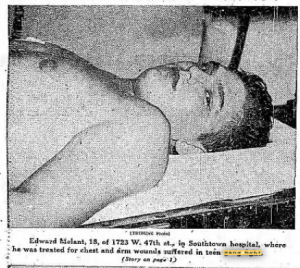

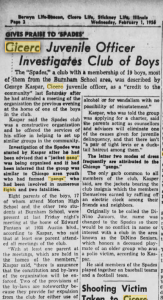


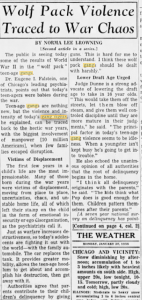
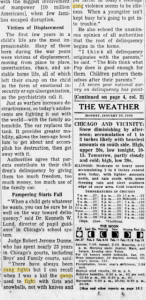

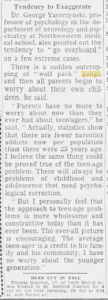
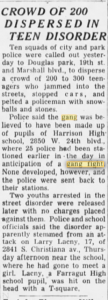
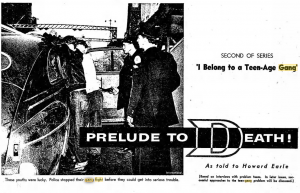
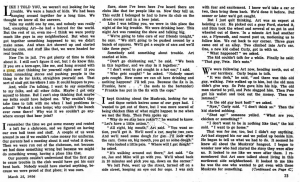
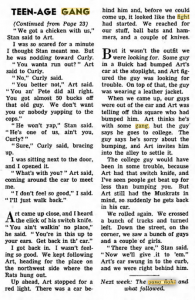

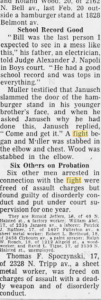
In the year 1957, another major gang incident made the headlines and once again it involved the Rebels. A group of Rebels surrounded a black teenager and struck him on the head with a ball peen hammer killing the boy instantly in a racially motivated attack. Once again the Rebels experienced another recruitment burst because of this incident.
The northwest side and north side of the city were perhaps buzzing with the most greaser gang activity especially in the West Town area and the Dunning/Jefferson Park area. In later years we will cover how these were the big homes of many later greaser clubs but this is when it all began in the late 40s and early 50s and got crazier by the later 50s. Was it because of minorities moving in? The answer is no, by 1957 barely any Hispanics and almost no blacks had moved in, it was mostly caused by bored teens from good homes that had parents that didn’t pay attention to them. The problem with this was it created some hardened gangs that were geared to protect against these roving bored teens and that’s how some of the most well-known Hispanic and black gangs got their start. That boy killed with a ball peen hammer was a member of the Blackstone Raiders which would later evolve into the Blackstone Rangers which would then later evolve into the Black P Stones we know today. These groups were also the influence for later and tougher greaser clubs that would end up having existence for many years to come, some of which still exist today.
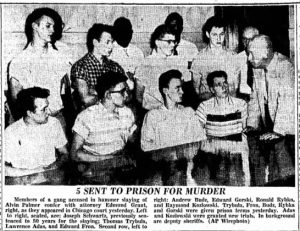
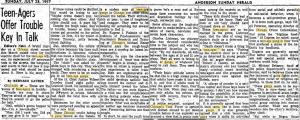

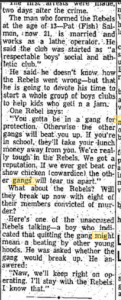
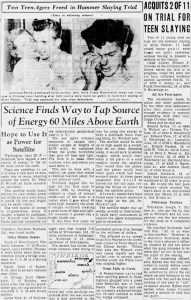




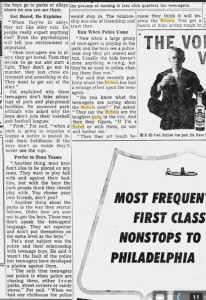
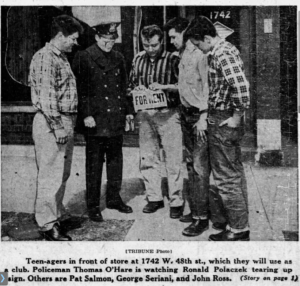
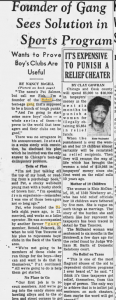

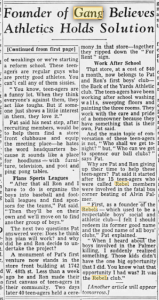

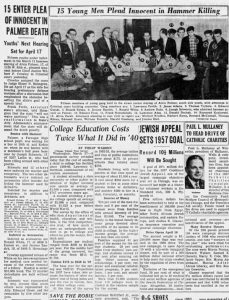
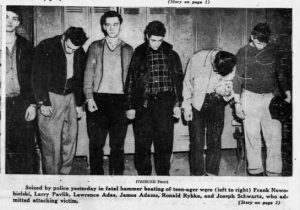

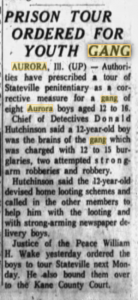
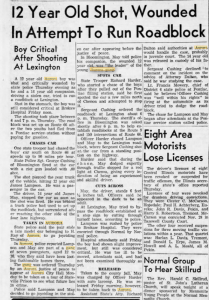
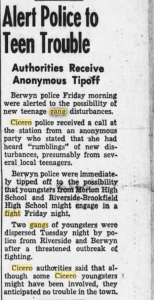
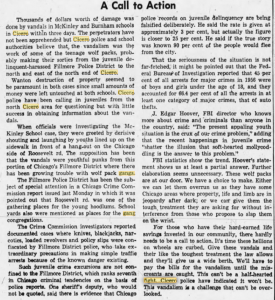
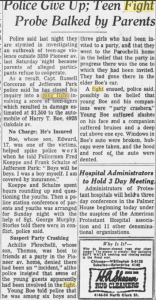


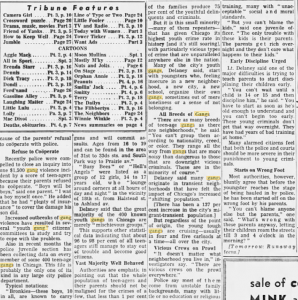
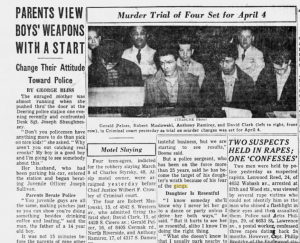
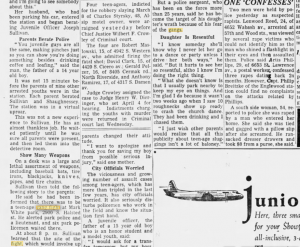
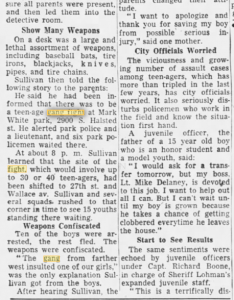
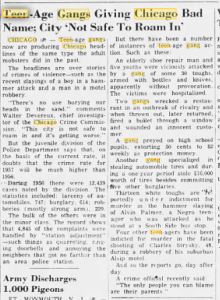
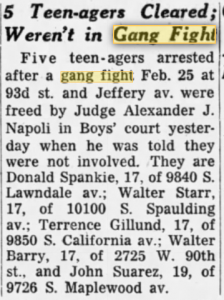
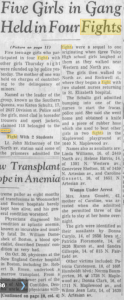
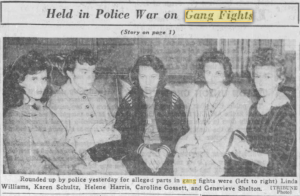

As 1958 came in, the greaser fad had become so popular that greaser style clubs were just about everywhere. The majority of greasers were law abiding groups of youths and young men that simply worked on cars and motorcycles and the worst thing they did was party but they avoided aggressive behavior and were law abiding. There were also several clubs all over the Chicago area that didn’t even follow greaser style and were simply S.A.C. clubs. An S.A.C. is a “Social Athletic Club” which is what it says in the name, it was a bunch of guys or girls that got together to engage mainly in organized sports. These groups would attend dances and court girls and sometimes throw parties and again they were not gangsters and criminals. Many greasers were even just S.A.C. groups as well.
A serious issue arose for teens in Chicago about jealousy, jealousy from gangs. Gangs in general back then, whether greaser gangs or non-greaser gangs loved to have control of territory, the best parties and the most desirable women. Women especially were the trophy of gangsters and they felt if they wanted them they owned them as long as the girl showed any willingness to hang with any of them at any point in time or even give them a little time of day. Even if the girls simply lived in the neighborhood and the gang wanted to court them, they were automatically regarded as their property and if any other young men came to court them there would be problems. It has been a behavior since the dawn of man that when boys and young men gather in groups they behave like animals around women as testosterone flares up and men will sometimes become territorial and aggressive with other males. When girls choose to hang out with a group of guys and do not date any of them while still talking to a few guys from another hang out group each group may become jealous of each other and soon there could be a stand off which can become rather violent. This is what happened not only between greaser groups and gangbanger groups but also between greaser clubs and regular S.A.Cs or even just some young men hanging out together.
The issue in the city became that groups of young men had difficulty hanging out in groups without being pestered. You may have heard your father, grandfather, uncle or other family member preach to you that they grew up in the mean streets of Chicago and got by just fine without joining a gang and that gangs are for cowards; we all have heard this so many times but that doesn’t apply to everyone. Perhaps that person you know didn’t hang out with a lot of people all at once and also throw parties and draw in girls. Having all of those traits is a recipe for becoming a target by gangbangers and this has been a case for several generations. When teens were growing up in the city, some would find bonds with a group of other boys that they could relate to, sometimes that bond was between 10-15 boys or maybe just 5 guys, either or, it started as a bond between a group. If the group was interested in partying, like many youngsters are, that became strike two. Strike three is hanging out with pretty girls and throwing parties where people outside of your clique attend. Your group becomes liked and girls start to talk about you guys, now the gang members take notice. Perhaps your group will be approached and asked to assimilate into the gang and your group says no or maybe they will just start picking on your crew because they know you guys don’t have the weapons and resources they have and before you know it you have a beef. This had happened so many times in the Chicago area especially by the later 1950s as it got worse. The bullying was on every corner and your clique tries to remain neutral and stay away from gang life but after a series of bad stuff happens you can’t stand being chased through parks, having your little brother come home beaten up badly or your girls whisked away by gangsters. You guys can’t stand having your tires slashed and windows broken or the gun shot that was popped off on your block anymore. You and your crew finally decide enough is enough and you chose colors and give yourselves a name; you have just become a gangster and not by choice but you have to do what you have to do in order to continue on with your desired lifestyle of partying and having a lot of friends…you have to knuckle up and fight for it now. This is the story of how major gangs like Chi-West and the Playboys began in 1958, they couldn’t stand being targeted anymore so they started a gang.
The Playboys started off as a baseball team called the “Naturals” and they loved to just hang out and play ball back in 1958. As the year progressed they found more friends and threw parties as girls started to hang with the Naturals but once they started school at Wells High School in the fall of 1958, the Gaylords and C-Notes noticed them and started chasing them around. The Gaylords and C-Notes were bigger groups that were often vicious and aggressive and when they saw what the Naturals were accumulating they wanted to put a stop to them so the Naturals fought back and started gang banging under their new name “Playboys.” Now they had colors and symbols and they also had guns, it all happened so fast and by November 12, 1958 they were in the newspapers for shooting at black gangsbangers resulting in a murder. Earlier that year these were just kids interested in playing ball but because their backs were against the wall they now developed a new thirst for action and violence; the streets of Wicker Park changed them. As time passed the Playboys developed a hell of a reputation for violence as they were well known for hardcore gangbanging even making the newspapers multiple times in the 1960s and 1970s.
The Rebels made the news again in 1958 twice when they were in the paper for fighting police officers in a bowling alley and for trying to ally with a gang known as the “Jets” in downstate Ottawa which was about 80 miles south of the city. Once again this not only brought more recruitment for the Rebels it also made more youths attracted to the greaser gang life.
Soon there would be many more S.A.Cs that would convert into gangs out of necessity. The city was becoming a jungle in all neighborhoods not just the ghettos anymore, this would soon make many neighborhoods not as safe and many youths in school were terrified.



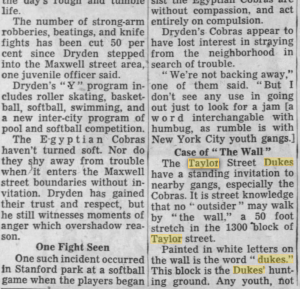

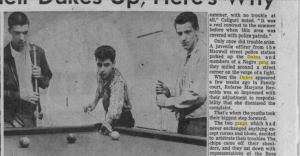


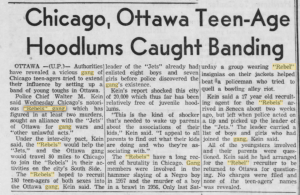

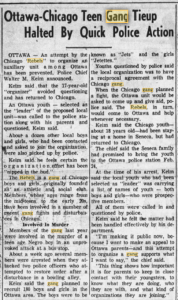
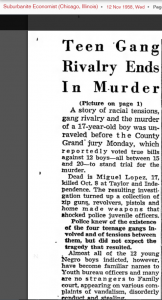
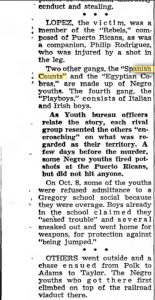
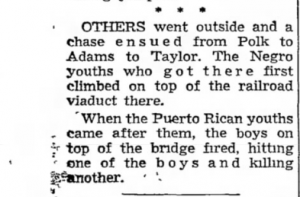
Chicago began to see an increase of racial shifting of certain neighborhoods in the mid and late 1950s mainly due to the construction of the Dan Ryan Expressway, Kennedy Expressway and the Circle Interchange. The neighborhoods directly effected by all this were Morgan Park, Fuller Park, Armour Square, Englewood, East Garfield Park, West Garfield Park, North Lawndale and most of all the Near West Side. The Near West Side felt the burn from all three road projects as several families of all races had to evacuate their homes as they were slated for demolition between 1955 and 1960. Then in 1962 more displacement happened for a few years as the new UIC campus was built right over a lot of Little Italy and the Maxwell market area. Neighborhoods like the Near West Side, Fuller Park and parts of Armour Square and Morgan Park had heavy concentrations of a black population. In Armour Square and Morgan Park only the black community was effected by this construction and it completely removed almost 100% of the black community of Armour Square. Displaced black families then moved about the city which grew the black populations in effected communities like Englewood, North Lawndale and East Garfield Park. Blacks from effected neighborhoods like Fuller Park for example filled into Englewood and other areas. There was also a massive influx of southern blacks still coming into the city since the 1940s and by the second half of the 50s that number was growing so this was another factor for growing black populations on the west side and the south side. Neighborhoods like North Lawndale, East Garfield Park and West Garfield Park became less attractive for middle class whites to live in because of the construction since the highways divided access to shopping districts or just made getting around the west side more complicated. After whites left the values of the homes they left had dropped ten fold which made the property usually purchased by landlords that subdivided the property into multiple small apartments that they often failed to maintain. Southern blacks moving into these apartments had lower standards because of how they were used to living in the severely impoverished southern states; therefore, these kitchenettes could almost be luxury to some, in reality they were slums.
In the 1950s, whites in Greater Grand Crossing, West Englewood and Chatham neighborhoods now had to face the reality of larger populations of blacks moving in. West Englewood had blacks for several decades before the 50s but it was always a small confined community that very seldom saw any growth but now there was steady growth as the borders of that black section began to grow. Greater Grand Crossing began to see black in the 1930s but it was a very slow migration in the 30s and 40s but now blacks were appearing all over the neighborhood by the 1950s and whites were furious. The Chatham community was completely shocked when blacks began to move en masse suddenly and now racial clashing began.
Soon there was a fight for the south side as whites began to object harshly about blacks moving in. On the west side the fight was not as heavy as the Jewish community in North Lawndale just moved away peacefully while other Jews embraced blacks but in the west side community of East Garfield Park residents were upset but I do not know of any real racial strife just major white flight in the 50s.
In the northern communities blacks were not moving into those communities instead the perceived invader in the later 1950s was the Puerto Ricans. Puerto Ricans were concentrated in two main communities in the 1940s and earlier 1950s. Most of them lived in the Near West Side and in Old Town in an area that is today known as the Carl Sandburg Village. It was the construction of this very set of condos that caused mass evictions of the entire Puerto Rican community in Old Town and now both Old Town and Near West Side Puerto Ricans were slowly moving into West Humboldt Park, East Humboldt Park, East Village and Wicker Park. The white communities objected to this move but it wasn’t significant enough to cause a major uproar yet. Puerto Rican gangs like the Imperials I mentioned earlier that would later evolve into the Latin Kings moved in these areas and the Spanish Lords started here all in 1959. Both these organizations were very low key when they moved in to the point that white gangs didn’t even know their club names. White gangs didn’t consider these organizations a threat and from their perspective back then there was no issue but for the heavily outnumbered Puerto Ricans it was a living hell. On the southern part of the city displaced Mexican people from the Near West Side began to settle in Pilsen and South Chicago causing some racial strife but these communities still remained over 90% white by the 1960 census.
Most of the 1950s racial battles were being fought on the south side of Chicago as blacks were perceived as the big enemy down there. So, the question becomes, why did they need to hate blacks so much? Why couldn’t they just let them live there and have open arms? We are going to explore this in depth so I can show you as the reader why that couldn’t happen. I have page after page on this site dedicated to sympathizing with the struggles of the black man and how terrible he was treated by the white man but this site is not completely dedicated all the way to the struggle of the black man only. My mission is to point out the struggles of not only the black man but the white man and the Hispanic man too. Greed and corruption pitted the races against one another as redlining, land grabbing and propaganda destroyed race relations in this city as Chicagoans were used as pawns for a race war against each other to help support or ignore corporate of greedy governmental agendas. Many people of the white communities didn’t want people of color in their neighborhood because they feared depreciation of the community they worked so hard to build within and I will go into details on this.
The majority of these people in these communities were not really racist and realistically didn’t hate someone based upon their skin color. The issue is when people of color were moving into these white communities, the assessed value of the community dropped tremendously. This dropping of value was not controlled by the community or the people living there. This was controlled by lending institutions and real estate agencies. Going deep into history, blacks were discriminated against for education, equal employment and pay and to live in better communities. Because of these factors blacks were often left under educated and were stuck below poverty line incomes. In the 1950s there was also an issue of black southerners not being educated about proper maintenance of their dwellings. In the south many blacks were forced to live in squalor and deal with the lowest standards of living. When arriving in Chicago many were clueless on tending to property which would lead to their properties or properties they rented depreciating in value and looking like slum dwellings. This was also an issue for Puerto Rican migrants that were used to living in ran down villages in Puerto Rico. It was a mess that came from old prejudicial processes from the 19th century and early 20th century where blacks were kept as second class citizens. White people in these south side neighborhood in the 1950s felt threatened as blacks moved in because they knew how other communities in Chicago historically went way down in value once blacks moved in and they feared for their property values. This was a concern not only because of race but also because of living among the poor. The white citizens also knew that the city would deem these communities as less valuable and filter less tax money to the community to keep up maintenance and funding for education, parks or any recreation. All communities all over the United States are rated by desirability and when blacks move in the desirability rating tends to take a hit, especially if they are poor blacks. More than skin color, middle and upper class people generally tend not to want to live among the poor period, regardless of race.
When blacks began moving to white neighborhoods on the south side the fear of property value drops was very real as many residents began to panic. Real estate companies took full advantage of the fact that historically many whites did not want to live by blacks; therefore, the real estate agents came knocking on the doors of white households and scaring them with stories that blacks were soon going to take over. This tactic known as “block busting” was highly effective as agents would help the families move very rapidly while having to sacrifice a loss on their home equity which went into the pockets of the agency. The family was then sold on a brand new home out in the suburbs in one of the new subdivisions being built by the many builders coming up at the time. This took away the families’ leverage to negotiate a better price for the home because both the agent and building company knew the family was desperate to escape a racially changing community. Families would not only lose big equity in their homes, they would also gain a high mortgage payment due to such a hasty move. When the old home was left vacant the realty company would sell the home at a higher value to the newly arriving black family or would sell to a landlord that would divide up the home into small apartments so he could make his money back ten fold, especially after he would fail to maintain the property.
Each family that moved out during white flight in the earliest years made a very substantial income giving them the means to make it happen. Their credit lines were above average and they had a higher scale middle class income. The lower middle class income families of the community didn’t have the means to move from the area especially since the suburban homes were going for a high rate due to how new they were and there wasn’t enough old homes in many suburbs to move into. These families would then brace themselves for a racial change in the community, many of which were willing to accept the changes because they had no choice.
In the beginning, the racially changing neighborhood was more in favor of the white family as blacks were the minority group, this often left many black families to face discrimination or some bitterness but many of those white families that were resentful and discriminatory during this early transition had left the neighborhood a few years after the beginning of the transition and this is when the black population became close to the majority or had just achieved the actual majority of the population. Many of the white families remaining were not out to attack blacks or cause any problems but many groups of blacks were bitter about their treatment when they first arrived here or treatment elsewhere before they moved here. This is when the white kids were bullied by groups of black youths or black gangs. These are stories that never made the newspaper or were a subject of controversy because it was unpopular news and the white man was seen as privileged and should be able to move out if he wanted to. Many of these white families were poor or even had dysfunctional families but they were treated like they had privilege. The 1960s in these areas were much harsher on many white families still living in racially changing neighborhoods as large black gangs began to swell in numbers like Disciples and Black P Stones. There was a lot of fuel thrown on the fire with coverage in the media of racial battles in the streets around our nation. There was a lot of positive with blacks standing up for themselves and fighting back against oppression but sometimes there was some negative that came from this in these racially changing communities as some whites were attacked and ridiculed just for being white. This is when many white youths remaining in these south side communities banded together to form greaser gangs to fight back and for their right to live in the community. For many white youths there was no choice but to fight back; however, the fight wasn’t as charged up as it would be up north where whites were fighting Hispanics. The biggest fight was being fought in the Roseland neighborhood by the 1960s.
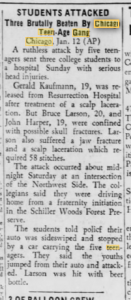
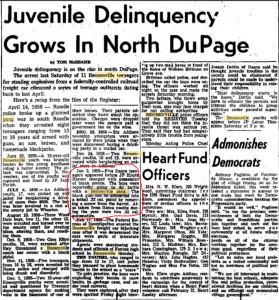
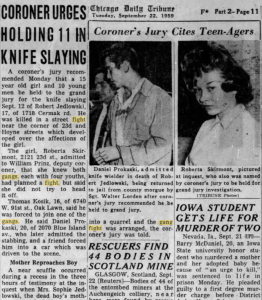

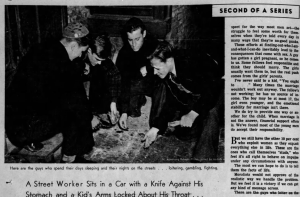
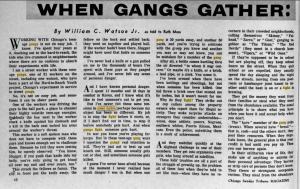
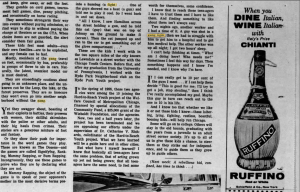
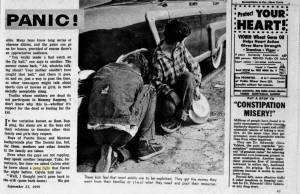
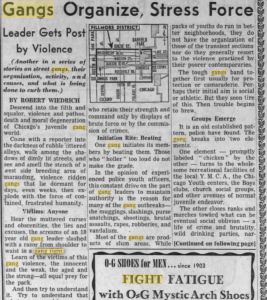

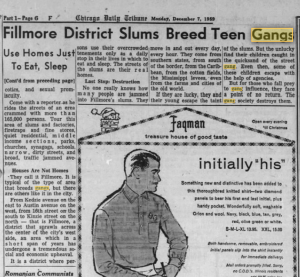
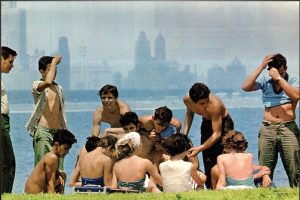
Early 1960s: The beginning of the second generation greaser
For decades the north side streets of Logan Square, Humboldt Park, Wicker Park and all of West Town had been highly coveted northern Chicago neighborhoods. Besides these streets becoming crawling with some of the wildest greaser clubs by the late 50s, these streets were safe, clean and people took great pride in these communities. In the early 1960s more new subdivisions were being constructed in the suburbs as suburbanization became increasingly popular. City-wide, the issues with crime and gang issues were growing entering this new decade and more middle class families had growing fears that these issues would end up in their backyards. The usual block busting tactics continued to ruin parts of our city as this greedy practice only became more rampant, now the north side was falling victim to such a devastating practice.
Up north the perceived enemy was not the black man instead these communities were being infiltrated by Puerto Rican people, some straight from Puerto Rico as others were migrating from the Near West Side and Lincoln Park. In the Near West Side community construction had begun on the new University of Illinois at Chicago campus in 1962 and this caused many more evictions. In Lincoln Park the Puerto Rican people that came her in the late 1950s caused major resentment which led to a urban renewal project designed to hit them right in their pockets by rehabbing the neighborhood making properties unaffordable for lower income Puerto Ricans. Logan Square, Wicker Park and Humboldt Park had lost some interest with neighborhood rehab projects, thus, bringing down the values of these communities just enough so lower income residents could move in to homes that were vacated due to suburbanization, but many took up residents in the subdivided homes that were bought up by landlords that converted those homes into multiple apartments. Just like on the south side of Chicago these landlords often turned into slum lords letting repairs go out the window making for a shabby looking property on the block ruining the desirability of the neighborhood.
Once Puerto Ricans began moving into these communities in higher volumes in the early 60s it caused quite an uproar because once again the fears of the neighborhood depreciating took place. Puerto Rican people, just like the blacks on the south side were often very poor and uneducated. Many Puerto Ricans moving in also didn’t speak any English and some had the means to open Spanish speaking businesses that was a real threat to the culture of the neighborhoods. Once again the most middle class white families had already left or were about to leave as the lower income whites were left behind to adopt to a color changing neighborhood. Another issue was many upper income class whites often bullied Puerto Rican youths in the early 60s then left the neighborhood a few years later leaving a bitter taste in the Puerto Rican youth’s mouths and revenge ready to be served on the remaining whites left behind.
What needs to be understood is between the years 1962 and 1964 Puerto Rican migration into Wicker Park, East Village, East Humboldt Park and West Humboldt Park and Uptown and Mexican migration to Little Village all was very rapid during these years as whites crazily moved out. Chicagoans had witnessed the devastation to color changing neighborhoods because of practices like red lining so the instinct of the youths were to fight back against this perceived invasion. What needs to be understood is that these neighborhoods were not properly transitioned and there was no guidance for a smooth transition of people of color to arrive. The perfect remedy is to prevent white flight out of fear or hate and to maintain a stable economy for the neighborhood while keeping away out of control red lining and block busting. these neighborhoods had no organizations or any support from the city to make the transition sensible. In some neighborhoods like East Garfield Park, groups that attempted to advocate for a smooth transition failed as this proved to be a very difficult task. The bottom line was a smooth transition was almost impossible and to an average family living on the north side they could only see this as a threat especially since it was very often assumed that Puerto Rican migrants had anti-American sentiments.
Greaser gangs were becoming more territorial and centralized by the early 1960s as the roving greaser gangs were beginning to become something of the past. These groups were also becoming more organized than before. Groups like the Gaylords, Chi-West, Playboys and C-Notes became increasingly popular in these communities as they were the most organized.
On the south side of Chicago blacks arrived in more new communities as they came in heavy volumes right away. Neighborhoods like: Avalon Park, Calumet Heights, Auburn-Gresham, Pullman and West Pullman began the transition as blacks began moving in. Neighborhoods like Auburn-Gresham and Calumet Heights attempted a smooth transition for blacks and even forbade block busting tactics. In Pullman and Roseland there was mostly anger toward blacks moving in as greaser gangs of the 1960s in these neighborhoods would take on a violent approach.
The early 1960s spelled the beginning of a new generation of Chicago greasers. This was the beginning of the era of greasers based in every neighborhood that could be seen in their turf daily. This generation would also prove to be more hardened greasers than their predecessors.
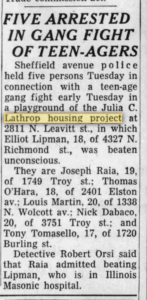
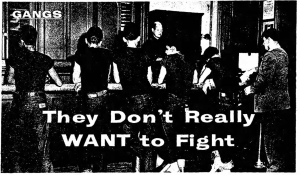
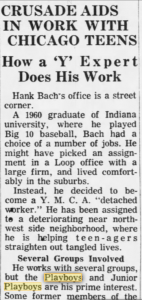
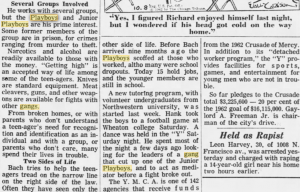
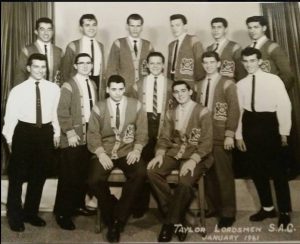
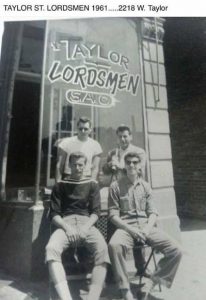
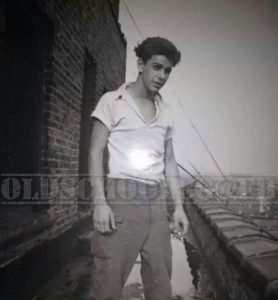
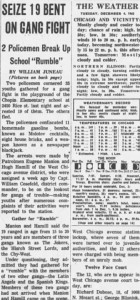
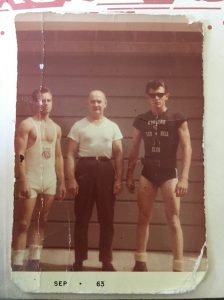
Mid-1960s: The race wars begin
Since the late 1940s greaser gangs viciously slugged it out with each other as their wars sometimes swept the headlines. In the early 60s they fought some of their last wars against each other as they now felt the need to ally up with other greaser clubs within racially changing neighborhoods.
In the mid-1960s, neighborhoods up north now had a large Puerto Rican population while on the south side neighborhoods like Roseland and Pullman were transitioning to becoming almost equally black as they were white. The police in these communities were especially upset with the racial transition and greasers often attested that police would encourage racial attacks by white gang members, the police would help it along. People banded together from Roseland, Pullman and Burnside that were all concerned with blacks moving into the area and they held meetings at the old Florence Hotel at 111th and Forestville Drive. Major black Chicago street gangs were moving in to these neighborhoods like Blackstone Rangers and Devil’s Disciples which caused greasers to fight against these larger gangs.
Up north, the Puerto Ricans had become in tuned with gangbanging and learned how to assemble a super gang, the Latin Kings. The Latin Kings were so deep and organized they soon outnumbered any individual greaser gang by the year 1964 when they were put together. Latin Kings also riled up other Puerto Rican gangs like Warlords and Spanish Lords to fight against all white gangs as well forming an alliance known as “United Neighborhoods.” This rising up caused the most organized white greaser clubs up north to organize against the Puerto Ricans in two rival groups called “Playboys Ventures and Pulaski Park” and the “Gaylords C-Notes and Gents.” These two alliances were rivals but they didn’t spend nearly as much time fighting each other as they once did instead both groups consisting of three gangs each sought out Hispanic gangs in the West Town, Logan Square and Humboldt Park areas.
The late 1960s: The third generation of greasers and the race war intensifies
White flight continued to hammer down on the city as more and more middle class white families headed for the suburbs. Some of the first suburban new subdivisions of the 1950s had now come down in value making these homes more affordable allowing some lesser income middle classes to leave the city. It was now getting to the point where businesses were closing down as the white families in the neighborhood that owned them had left. Some business owners already feared for the local economy and packed up and left before things could get bad. Many of these vacant storefronts were never filled with new businesses and if they were they were often replaced by Spanish speaking businesses, that is on the north side, on the south side the vacant buildings became occupied by high price convenience stores owed by foreigners that had no direct ties to the community.
The people that had lived in these communities a long time were not used to crime and this type of poverty and it all happened to begin once blacks or Puerto Ricans arrived. This is why the remaining whites blamed people of color for such actions because that is all they could see. What they didn’t see was many of the criminals were transient and coming into the neighborhood to commit crime because they saw shabby buildings and a neighborhood on hard times; therefore, they sensed opportunity. what else they didn’t know was these families had no other choice on where to live and that many landlords were offering slum lord properties cheap at a price that was irresistible to an impoverished family. I am not justifying the actions of the white man in these communities when they didn’t make Puerto Rican people feel very welcome but I just want you to step back and imagine if your neighborhood was changing before your eyes to something you are not familiar with to the point where you start to not understand your own surroundings anymore. Also imagine if your neighborhood is suddenly having pimps, prostitutes, dope pushers and drug needles on the streets and you feel unsafe even in your own home. Am I saying the Puerto Rican people caused all this crime, no, hell no. I am saying crime is a product of poverty and poverty is a product of a city that doesn’t take care of certain people that live in certain areas of the city and these people moving into Humboldt Park, West Town and Logan Square were from the slums of the Near West Side where life was hard. When they moved to these nicer communities they were not helped into housing that we call section 8 today that helps rehab families into nicer homes and nicer communities, instead it was left to the slumlords back in these days. Not only that there were not enough job training programs for these people to help them get higher paying jobs to make a better living.
The Puerto Rican gangs were at first, a response to the many angry greasers that attacked viciously, but now these gangs had manifested into giants like the Latin Kings and the growing Latin Disciples. The greaser clubs now needed to keep up with the strength of the Latin Kings and their allies and that’s when the white man grew the Gaylords which was the first successful white super gang. In 1969, the Gaylords put together this plan to grow into giants. This was also the year that the Gaylords C-Notes and Gents alliance united with the Playboys Ventures and Pulaski Park alliance so they could fight side by side against the United Neighborhoods.
On the south side, greasers battles against the black gangs in the streets of Pullman, Roseland and Burnside. Burnside was just seeing more black families move in while Pullman and Roseland where 50% black. Burnside residents were also complaining about higher crime in the late 1960s and it just so happened to increase once blacks began to move in to the area. These families didn’t want their neighborhoods to convert into nearby communities like Washington Park, Greater Grand Crossing and the Bronzeville area; therefore, they felt the only way to stop that from happening was to take matters into their own hands and fight in the streets, burn down houses or spit at black youths moving through the neighborhood. Because of some unfair racial treatment for employment and housing in these parts of the south side for black families organizations like the Black P Stones arrived to settle this issue but the greasers didn’t want these organizations hanging out in their community because of what they knew about the Stones from the police and the newspapers. In the streets Stones and greasers slugged it out with bottles, bats, bricks, knives, chains and many times guns too. When the police arrived to break up the melee, the black gang members were arrested not the whites.
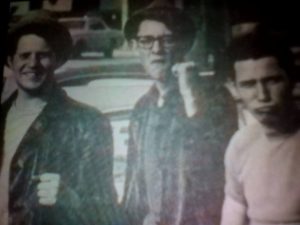
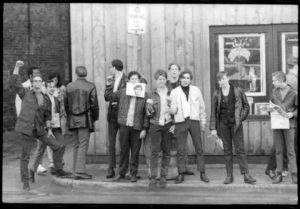
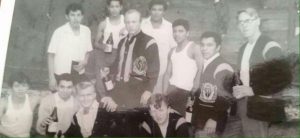
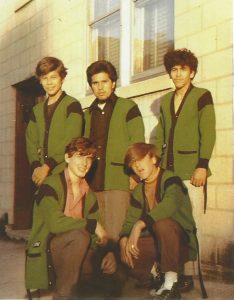
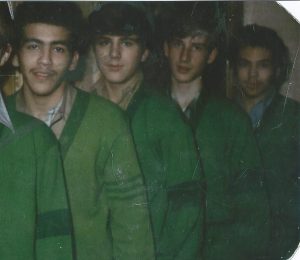
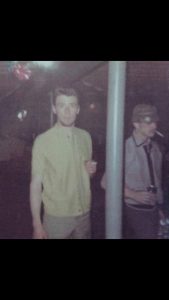
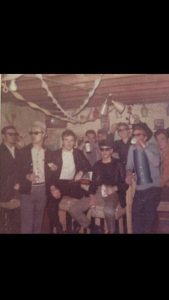
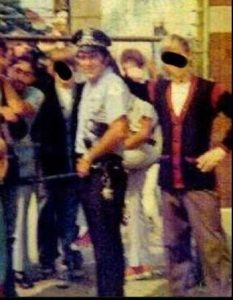
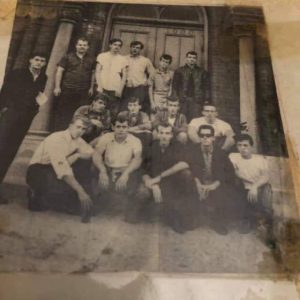

Early 1970s: The rise of the greaser and the neighborhood change
In the early 1970s, the greaser fad was dying out all over the world because it was seen as a 1950s and 1960s thing. In Chicago the greaser fad did not die at all, instead it now stood for something much deeper, this was the creation of the “Stone Greaser.” As it was defined on the Stone Greaser website (http://www.stonegreasers.com/greaser/) Stone Greaser means to be an extreme greaser or hardcore greaser. Even though the fashion of the greaser was more prevalent in the 50s and 60s, the attitude and the way of handling street business was more greaser like than in the past and perhaps pushed the boundaries further. The greaser gangs that survived the 60s now had to knuckle up even more and go as far as violent murder to defend turf and put the point across. Being a greaser wasn’t about a way of dressing anymore it was a way of living.
By the early 70s the Hispanic gangs of West Town and Humboldt Park now were in larger numbers as Latin Disciples and Imperial Gangsters were growing while several new gangs were appearing and gaining popularity like: Spanish Cobras, Latin Lovers, Orquestra Albany and Latin Eagles. All this came from further waves of Puerto Rican migration. The white gangs now felt the need to draw up a complete cease fire between each other so they could focus all their energy on the Puerto Rican gangs or in areas like Uptown they fought black gangs too. This agreement became known as the “White Power Organization” drawn up in 1971. The Stone Greasers of Chicago’s north side were now united or at least would no longer harm each other. This was an agreement to preserve the Stone Greaser and prevent extinction of the Chicago greaser and the war would become bloody.
White gangs by the early 70s adopted white power symbols like the swastica, Klansman and a cross. Many of these groups would also scream out “White Power!” or put it on gang cards and graffiti on the walls. Let me clarify that all this had nothing to do with the Nazi party, the Ku Klux Klan or any other white nationalist groups. These symbols and sayings were geared toward one goal and one goal only, to piss off rival black and Hispanic gangs, period. They wanted to get them mad, frustrated, upset or preferentially to the white gangs move out of the area. Sometimes they took things as far as burning crosses on lawns of rival gangs just to intimidate them and the neighborhood but in reality white greaser clubs often didn’t agree with white supremacist groups and sometimes even ran them out of some neighborhoods. Most of the time greasers didn’t have any beef with Nazi groups but would just shake their head when those groups came speaking in their neighborhoods or, like I said, even tell them to leave. In neighborhoods like Uptown many Gaylords and other white power greaser groups hung out with groups of blacks and Hispanics sometimes especially if they had a common enemy to fight. Chicago neighborhoods can be complex and many times people of different ethnic groups and races hang out even if they normally have agendas against other groups that are similar. For example of group of Black Gangster Disciples can hang out with Gaylords because they both hate Vice Lords and Latin Kings. Many of these white greaser groups also accepted Hispanics into their organizations. Some of the original north side Gaylords were Mexican, just like some of the first Simon City Royals were Arab, Hispanic or even mixed race. A Mexican Gaylord could be drinking with fellow Gaylords by a Gaylord tag that had a swastika in it. Greaser groups like the Simon City Royals would eventually even take in blacks. The point here is that these white power ways and symbols were simply there for intimidation and to cause anger from rival gangs.
On the south side of Chicago the early 70s into the mid-70s was the last stand for greasers in Pullman, Roseland, Burnside and West Englewood. White supremacist groups were in these communities trying to assist angry white residents but many residents didn’t agree with them either. The gang violence got very ugly between blacks and whites during these years until it died in 1975 when the rest of the whites left pushing all white supremacist efforts into Gage Park and Marquette Park until the 1980s.
On the west side of Chicago there was a war being fought since the late 1960s between white greasers and blacks. West side communities like North Lawndale, Near West Side, East Garfield Park and West Garfield Park had become almost completely black by the early 70s and Austin was the last stand that was still trying to hold onto being majority white. The greaser gangs of Austin were mean and tough and fought Vice Lord groups tooth and nail. The issue was the long time white residents of Austin saw what was happening along southern Cicero Avenue since the late 1960s. As soon as there was some deterioration along this part of Cicero Avenue from Chicago Avenue all the way down to Roosevelt Road blacks immediately moved in as property became cheaper to rent. This of course caused a white flight panic that started at the intersection of Cicero and Jackson and spread north and south along Cicero Ave. Now by the early 70s the white flight was spreading all over the community. The site of prostitutes, drugs, pimps and drug dealers horrified the long time Austin residents and many wanted to see the black migration slow down or even stop because once again residents blamed the blacks but in reality there was much deeper into that from a deep past of racial inequality that kept blacks in a state of poverty. But once again, for the sake of this piece we must put ourselves in the greaser’s shoes. To the greaser this wasn’t their problem, all they were concerned with was perceived invaders that threatened to change this community.
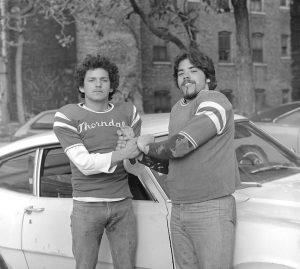
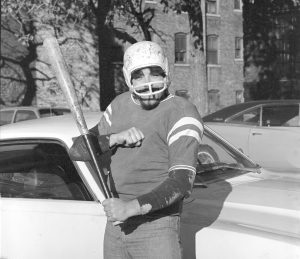
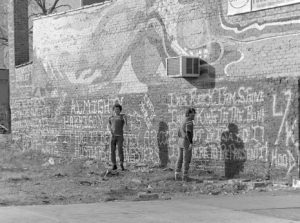
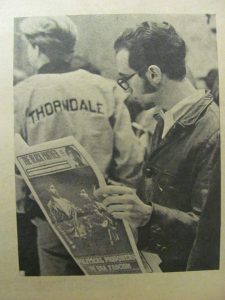
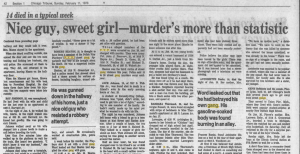

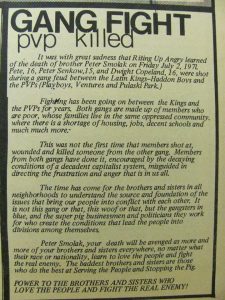
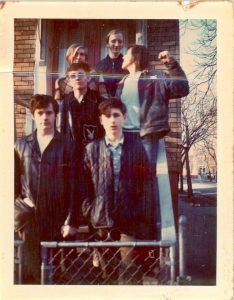
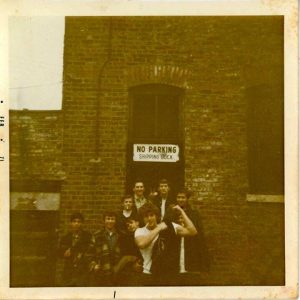
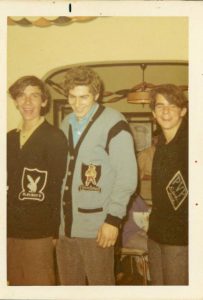
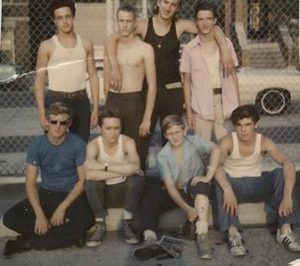
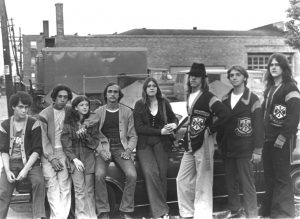
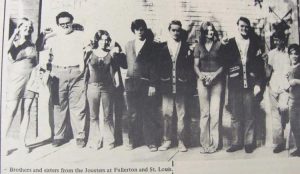
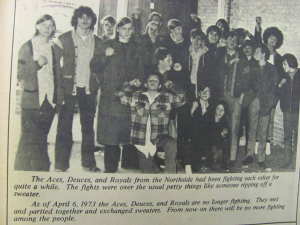
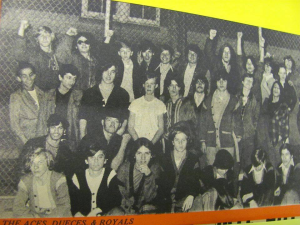
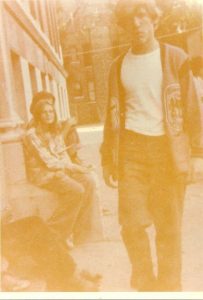
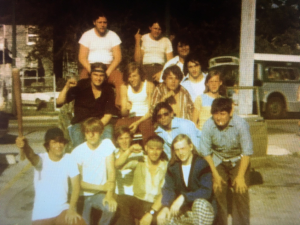
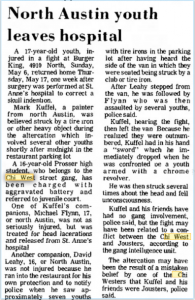
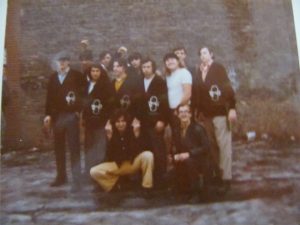
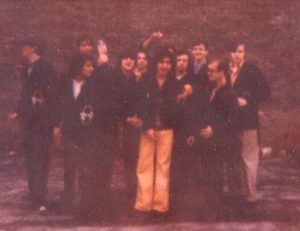
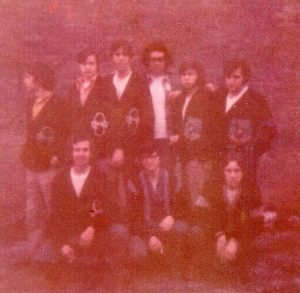
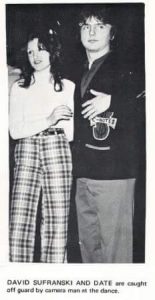
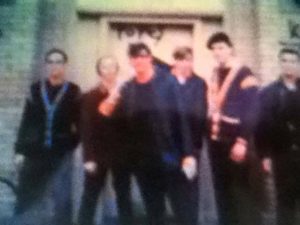
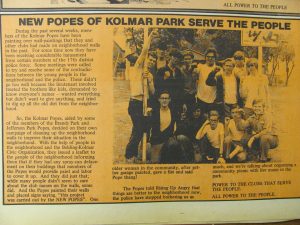
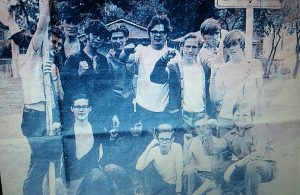
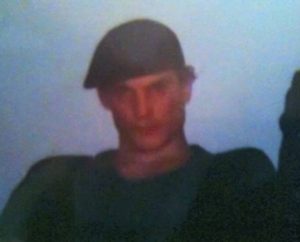
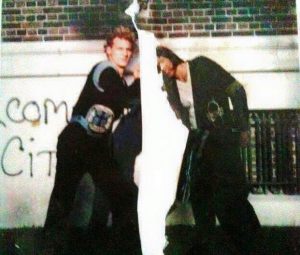
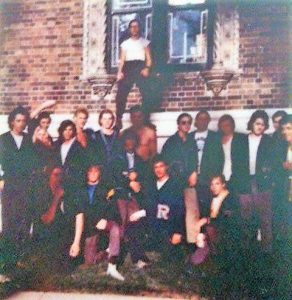
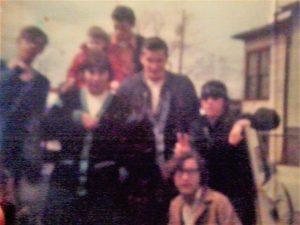
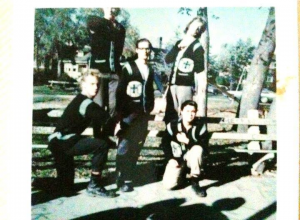
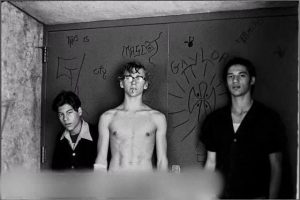
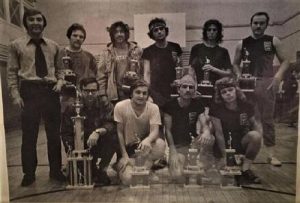
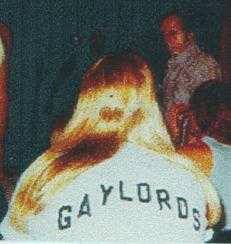
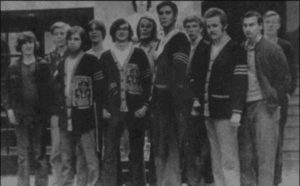
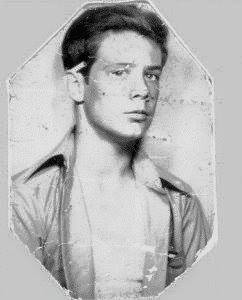
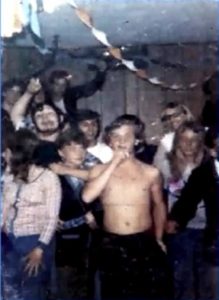
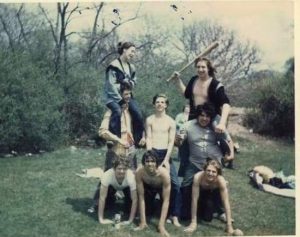
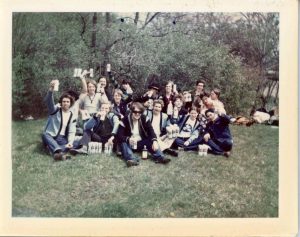
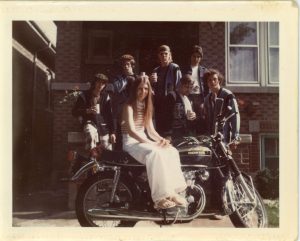
Mid 1970s: The Stone Greaser army
In the mid and early 1960s, several young greasers were drafted or enlisted to participate in the Vietnam War. By the early 1970s many of those young men were coming home and by the mid-70s the rest had returned. Just like all Vietnam vets all over the country these young men suffered from serious PTSD and fought several demons mentally after returning home. Many young men had to deal with living with the issues of war only to return home to find out their neighborhood had changed and they saw scores of gangs all over the streets they didn’t recognize that were of another race. Their neighborhoods of Logan Square, West Town and Humboldt Park had become half or majority Hispanic or black and the neighborhoods had fallen into some urban plights with boarded up buildings and ran down homes. Crime was now high and gangs ruled the streets. The vets came back to their block looking for neighbors they once new only to find a Spanish speaking family that was just as surprised to see them. Many of their friends and acquaintances had packed up in a frenzy a few years ago and had already made the voyage to the suburbs and some of their old homes now housed four families all living in divided sections of the home. The veteran was looking for something positive to come home to among friends but now that was all gone. Finally he finds some pals still in the neighborhood and finds out they are still affiliated with the same neighborhood gangs just now the fight is more real than ever as they must fight to salvage their existence in this neighborhood. The vet is invited to a meeting where several fellow gang members are in attendance including several guys from other gangs all carrying the status of “UFO” or “WPO.” There are so many guys and so many more not even in attendance as the vet finds out thousands of guys are in on this. Several vets just like him have returned from the war and are ready to fight too. Now the white gangs have combat veterans ready to fight, military trained guys that will have no problem shooting to kill or planning strategies of attack on the enemy. This brings a new elite force for the Stone Greaser army as these guys can even plan gorilla warfare and invasion tactics. The only issue is, the enemy also has elite guys that are military trained, now they are back in the neighborhood as Latin Kings, Maniac Latin Disciples or Spanish Cobras and they are Puerto Rican, yet proudly served our country. These men of different color fought side by side against the common enemy in the jungles but now they will fight against each other once again as they wear colors.
Vietnam vets returning to the ranks of the gangs were scary to say the least as they didn’t take any shit from enemies and often operated with a short fuse. These vets could also get down with some of the dirtiest gangbanging work that some of the other guys couldn’t stomach. War, chaos and killing was the normal way of life in Vietnam and it was legal to kill. returning vets all over the country struggled to fit in with society because we live in a society of laws and you can’t go out and kill anyone that looks at you funny and there are even laws protecting people that mean you harm. In war if someone is an enemy, even if they aren’t actively threatening you, you are free to maim and kill as you please. Many vets coming home struggled with this adjustment but on the these mean streets of Chicago the adjustment didn’t need to be as heavy as many people in these communities were now too scared to call the police or simply didn’t care anymore. Gun shots rang out all day and crime was rampant so what’s one more gun shot? What’s one more crime going to do? How about if many of the cops in the neighborhood used to be greasers before joining the force? Or, how about if they just don’t like how the neighborhoods have changed even if they aren’t from there? These cops may blame Puerto Rican and black people for it and sometimes even brutalize them in the streets. The cops could sometimes become cheerleaders for the greasers and look the other way when the greaser takes the life of a rival Hispanic gang member. Some other cops would just look the other way if you tossed them a small wad of $100 bills too. Although this wasn’t always the case it surely did happen. Regardless of whether the greasers had the police in their back pocket or not these neighborhoods now became easier to commit crimes in because police were either too busy now, non-existent or on the take. Scared residents locking their doors and not calling police also made it easier for gangsters to unload on enemies without serving jail time; therefore, the returning veteran could turn their old neighborhood into their new battleground and this was frightening for the enemy.
On the south side of Chicago the race wars between white and black were in their last days as the white south side greaser was fighting his last battles. The battle for Roseland, Pullman and Burnside was now a lost battle. Roseland was especially the center of the race wars since the 1940s and after 30 years it was time for the white man to just focus on packing up and leaving especially since Roseland was becoming a dangerous neighborhood. Even in Hispanic southern neighborhoods like Pilsen, Little Village, South Chicago and the Back of the Yards the white man was now in the big minority as they were all giving up. The south side of Chicago didn’t have a Stone Greaser army in the 70s, they mainly stuck to small greaser gangs that ultimately didn’t work out in the later half of the decade. Even a faction of the Gaylords on the south side failed by the end of the decade mainly because they were part of the original Little Village group that died long ago during the Vietnam war and I don’t think the south side Gaylords were heavily networked to the north. The south side didn’t have super greaser armies like the north did. The north had Gaylords, Simon City Royals and Insane Popes. Up north they even had smaller but still large groups like the Taylor Jousters, C-Notes and P.V.P while in the south there wasn’t anything notable since the days of the Rebels that had long passed.
Greasers had been part of the Back of the Yards gang culture all through the 1950s and 60s and was still rather strong in the early 70s, but by the mid-70s white flight had taken a big toll on this neighborhood and more Mexican families were moving into this area. This was the beginning of the end of the greasers in the Back of the Yards. These had always been some of the toughest and wildest greasers in the city but not even they could make it in a racially changing community, by the late 70s they had become extinct as Migratory Mexican gangs from other neighborhoods took over.
The west side battle was heating up more in the Austin community as the black population now had reached 50-60% by the mid 70s and the greasers were in for the fight of their lives as some of the craziest Vice Lords in the city continued to grow in the neighborhood. The Playboys and Ventures had spread to Austin and joined forces with some Gaylords that had settled there. The Rice Boys started in the Austin neighborhood and were some of the meanest of greasers as they viciously attacked enemies and formed an alliance with Playboys and Ventures to create the “Playboys Ventures and Rice Boys” alliance.
The greaser armies were perhaps becoming too large up north as now the peace between them was shattered in 1975 when Gaylords went to war with both Simon City Royals and Insane Popes. It really didn’t matter if they had turned on each other at this point, their armies were still growing into the thousands and the Gaylords were part of the UFO coalition with the C-Notes, Taylor Jousters and P.V.Ps. The Royals and Popes had each other as a coalition known as the “R.P.N.” The Royals and Popes also began hanging out with the Black Gangster Disciples one of the largest black gangs in Chicago at the time.
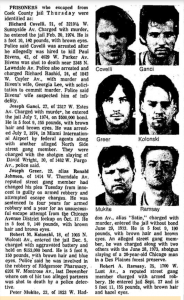
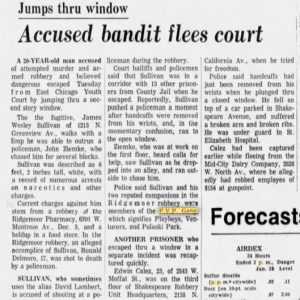
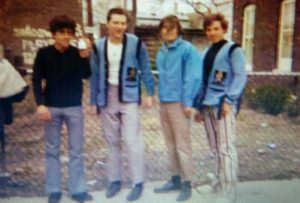

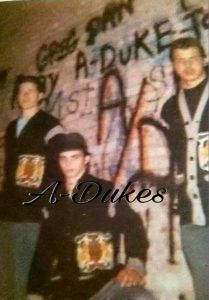
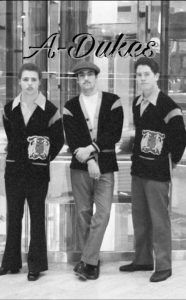
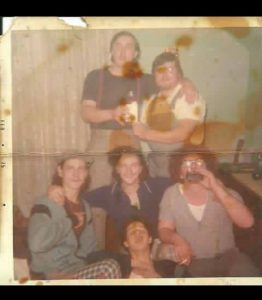
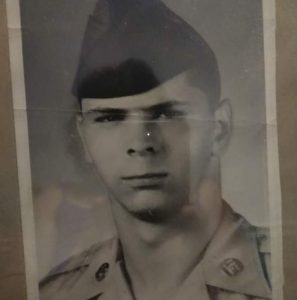

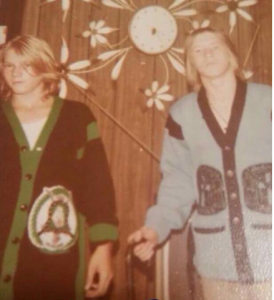
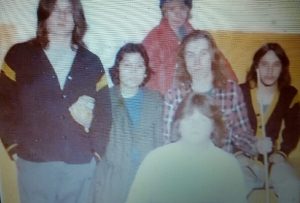
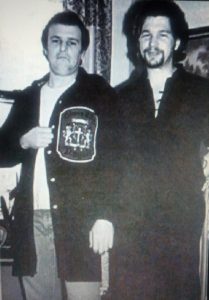
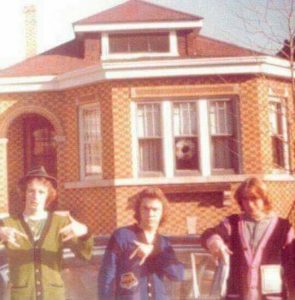
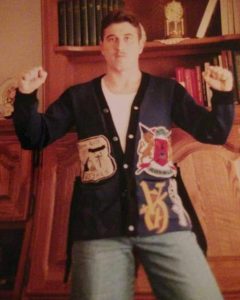
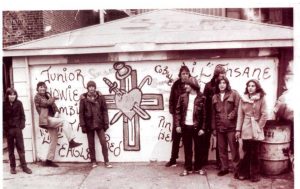
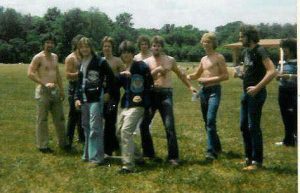
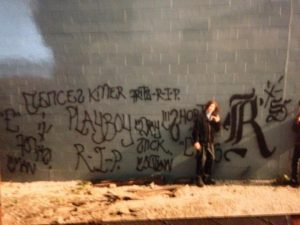
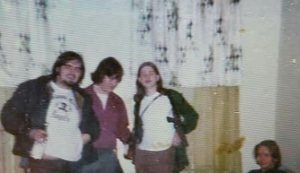
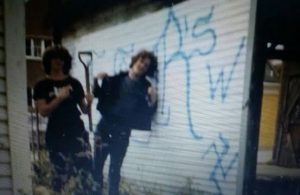
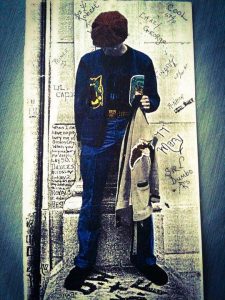
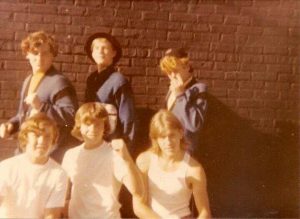
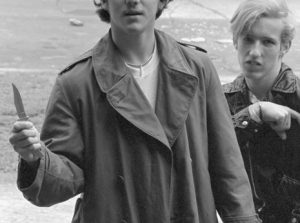
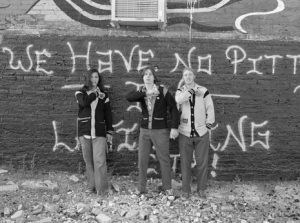
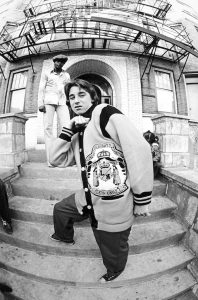
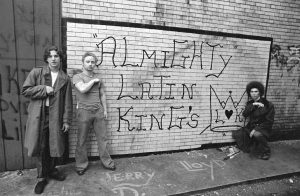
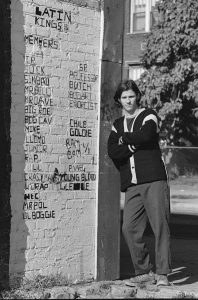
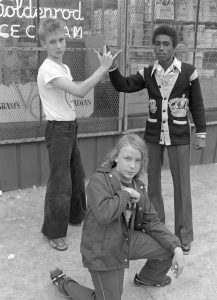
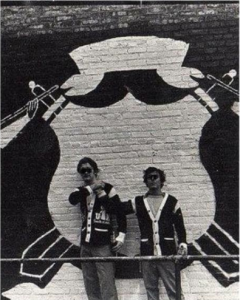
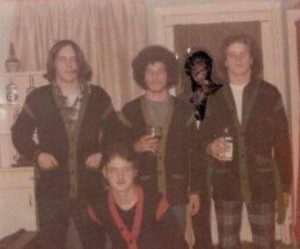
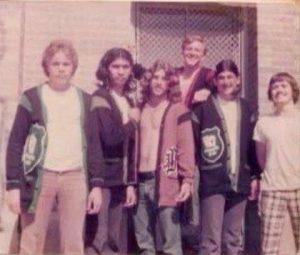
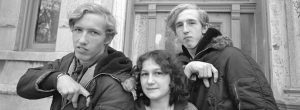
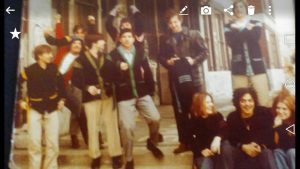
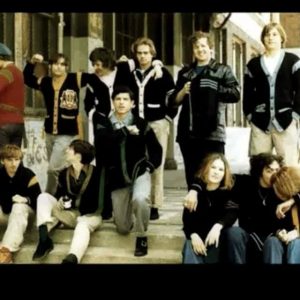

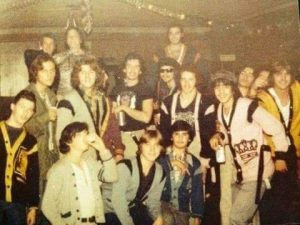
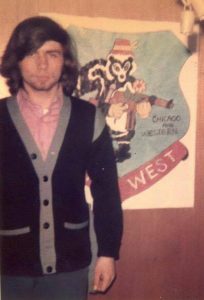
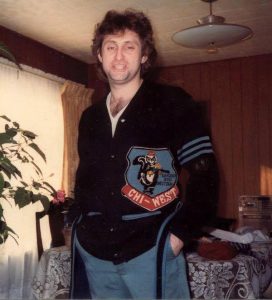
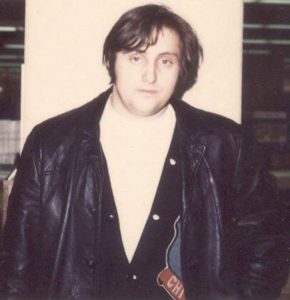
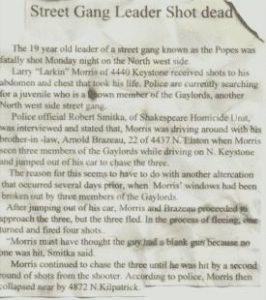
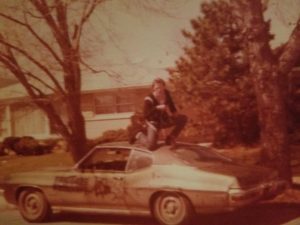
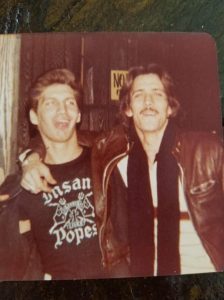
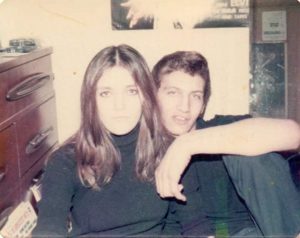
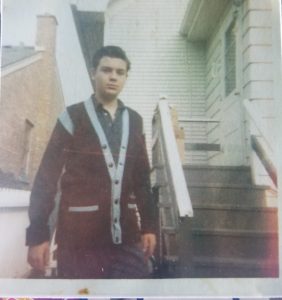
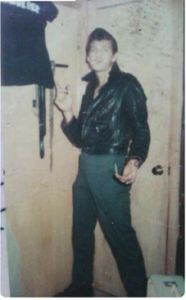
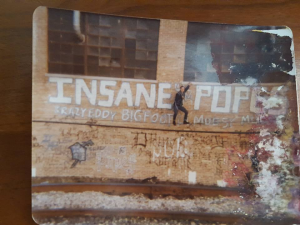
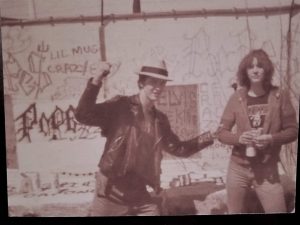
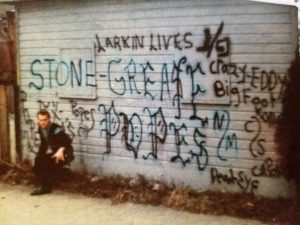
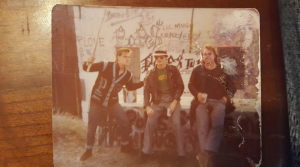
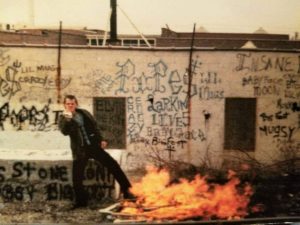
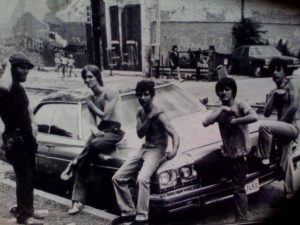
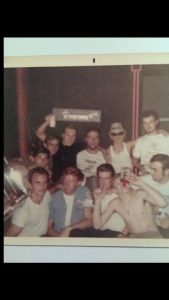
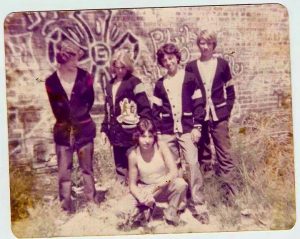
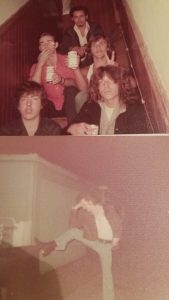
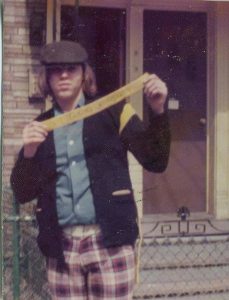
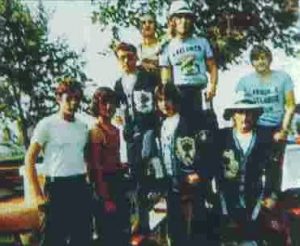
Late 1970s: The Stone Greaser peaks
By the late 70s, northern neighborhoods that were once almost completely white now had several blocks completely gutted of white families. The Humboldt Park neighborhood had now experienced over 90% white flight as now the neighborhood was all Puerto Rican and black. Wicker Park and East Village were now well over 50% Hispanic as white flight had taken a devastating toll. Logan Square had now become 50% Hispanic. Uptown now was as equally white as it was Hispanic or black. Albany Park and Hermosa were now experiencing white flight that was replaced by Hispanic migration. With the growth of the Hispanic population came the extreme growth of the Hispanic gangs especially Latin Kings and Maniac Latin Disciples. Despite the fact that the Hispanic population was becoming the majority in many areas the Hispanic gangs still felt they were outnumbered while the white Stone Greaser gangs were growing mainly because of those alliances known as UFO and RPN that would literally sick hundreds of greasers upon them all at once. The Hispanics began creating more alliances like the United Latino Organization which was the coming together of Maniac Latin Disciples, Spanish Cobras, Latin Eagles and Imperial Gangsters in 1978. In 1979, there was the creation of the “Insane” alliance which was Spanish Cobras, Orquestra Albany, Harrison Gents (had many black and white members) and Ashland Vikings. There was also the “Maniac” alliance which was: Maniac Latin Disciples, Latin Stylers, Latin Lovers, Milwaukee Kings and Latin Jivers. The United Neighborhoods was now not just for Latin Kings, Spanish Lords and Warlords anymore, now Insane Unknowns and the Ghetto Brothers Organization/Yates Boys Organization was part of it. In the prison system all these organizations were part of the Folk and People alliances as of 1978 and all the ULO, UN, Insane and Maniac stuff was put to the side as Folk and People ran supreme. ULO, Insane and Maniac were all Folks; therefore, they were not rivals on the streets and were actually all allies rolled into one to the point where they started mildly adopting Folk alliance symbols and bylaws by 1979. The United Neighborhoods was put aside in the joint and the People alliance took over behind bars and just like Folks, the People alliance was being uttered a little more on the streets in 79.
So, what did all these alliances spell for the Stone Greaser? Trouble! Indeed it was all trouble for the greaser because it now meant groups of hundreds of ULOs, UNs, Insanes etc…would descend upon them and go in for the attack. The bigger trouble was in the joint. When a greaser would get locked up he would soon discover that the new Folk and People alliances ran the prison system. Hispanic and black gangs had joined forces to go against the other group and any groups outside of their alliances that carried any white power flags. This was a world of trouble for the ULO gangs like Gaylords, C-Notes, Jousters and P.V.P as they were all about using white power stances even through they were not officially white power groups. This is when Thorndale Jag Off founder Joe Ganci had assembled the “Northsiders” which was a prison gang for all the white greasers that wouldn’t be protected by Folk and People and could come together as a white man’s organization. The RPN alliance gave in quickly and joined the Folk alliance and became the only pair of white gangs to join either alliance. Many greaser groups, both friends and enemies of Popes and Royals, criticized them for making such a move saying it was cowardly or that they sold out to the blacks and Hispanics. In reality this move was strategic for both groups because it not only allowed them survival it also allowed them to expand operations and make money through drug and weapons trades in later years. The original Royals were made up of men of all races (mainly different Hispanic races and white) anyway so they weren’t really meant to be white power, it was just a necessary doctrine that needed to be used in certain neighborhoods to piss off gangs they hated like Latin Kings and Latin Eagles, now they would be allies with Latin Eagles.
The census of 1980 had now shown that Logan Square was 50% Hispanic and West Town was 50% as well which includes the Wicker Park neighborhood and East Humboldt Park neighborhood in it. Ukrainian Village, Noble Square and southern West Town remained majority white during all these years and East Village very well may have remained majority white. About close to 50,000 of the just over 96,000 West Town residents were Hispanic and among those approximately 50,000 Hispanic people most of them resided in Wicker Park and East Humboldt Park. I don’t have facts and figures for what exact percentage of Wicker Park and East Humboldt Park were Hispanic but I can say those neighborhoods were at a minimum over 70% Hispanic by the late 1970s. If you don’t believe me, just ask someone that grew up there in the late 70s. So how was it that Playboys and Taylor Jousters were perhaps at their peak in Wicker Park? How was it that in a 50% Hispanic neighborhoods like Logan Square and a neighborhood like Uptown that had less white people than ever could an organization like the Gaylords be at their peak in strength? How could the Simon City Royals be creating once of their biggest chapters in Albany Park when that community was close to 40% Hispanic by 1980? Heck, even a nice piece of Irving Park’s population was now Hispanic, but somehow the Gaylords scored as the 4th largest gang in the city in 1979 according to Michael Kilian, Connie Fletcher and Richard Ciccone’s book Who Runs Chicago? The Gaylords now were at their best with 6,000 active members on their roster and the Simon City Royals were not far behind with at least 5,000 plus members. So the overall question becomes how can their be a negative correlation between the shrinking of the white population and the growth of the white gang population? One would think there would be less white gangbangers with less white people in these communities but it actually worked opposite.
As these communities were transitioning into larger Hispanic or majority Hispanic populations many young white youths fell victim to bullying from Hispanic or black youths. This is a subject I have heard about many times from old school greasers but it is something that is long forgotten in history because no one ever thinks the white man can be racially bullied by people of color but it can and did happen on the streets of Chicago, it just never made the news. Just imagine a young white teen from a broken or impoverished home trying to walk to school or go to the store in his neighborhood. As he walks a few blocks he is noticed by some neighborhood gangbangers that approach him. They begin asking him questions and bothering him when all he wants to do is carry on. He has no interest in gangs or anything like that and doesn’t even care about race, especially since he is too young to remember when the neighborhood was vast majority white. Regardless of his neutrality, the gangbangers keep harassing him until he says one smart mouth response either due to aggravation or nervousness and suddenly he is pommeled by the gangbangers as they savagely beat him up. This is a situation that was suffered by so many black and Hispanic youths throughout history as they were victimized repeatedly but this doesn’t mean this didn’t happen to innocent white kids by Hispanic and black gangs too, maybe not nearly as often but it still did happen. Now this young man will be victimized by the gang more often as they bully him and take his money until one day they are scared off by a group of Gaylords that leap out when they see this kid being wailed on. The Gaylords walk him home and tell him to come to them at anytime if he needs help. He tries to fend for himself a few days later but the gangbangers just attack him again and even worse they accuse him of being a Gaylord. When he goes back to the Gaylords for help the Gaylords are quick to offer assistance. This young man feels the loyalty from the Gaylords and soon looks up to them especially since he is scrawny and a little awkward and has a tough time making friends but now his friends are the Gaylords and he feels indebted to them even though they don’t ask anything in return. Finally one day he asks to join the Gaylords especially since he is marked by that gang in the neighborhood. Now one day he walks alone yet again and the gangbangers approach him again for another beating because they know it will be easy, suddenly the young man looks up angry and pounds on his chest as he screams at them, ” I’m rock, I’m a stone! I’m a Gaylord to the bone!” Then a swarm of Gaylords pour out from the alleys with bats and chains and soon the gangbangers on the other side are being beaten while others run for their lives. This is how Latin Kings, Black P Stones, Maniac Latin Disciples got started as they were bullied by white greaser gangs throughout history which forced them to gangbang, and this is also how so many young white kids living in racially changing neighborhoods joined the ranks of the white gangs because they were now the minority and many times treated that way.
As I said, white flight gutted much of these communities and what was left by the late 1970s was the poorest of the poor whites and many came from dysfunctional homes where there was alcoholism, drug abuse, physical abuse or the family was heavily dependent on public aid. These are things we often don’t think of with white families anymore but back in these days it was more prevalent. White gangs also had very heavy hitters in their ranks with some straight killers, burglars, robbers and downright violent guys. The older white gang members were some of the most ruthless as I have heard some chilling tales about older Gaylords in their 20s and 30s that would come into a rival gang neighborhood and tear the place up. These guys were not afraid to visit rival neighborhoods and pull up and begin shooting. Many older greasers and white gangsters were even half connected or mentored by organized crime outfits and simply didn’t give a shit about killing or dying. I have talked to many Puerto Rican guys that gangbanged with groups like Latin Kings, Spanish Cobras and Maniac Latin Disciples etc… and many have said they dreaded having to fight with the Gaylords. They certainly wouldn’t back down against Gaylords but they knew they would be in for a long and painful fight even if they were the victor against the Gaylords. The Gaylords would make enemies suffer delivering onslaughts of pain and anguish. Gaylords would use upsetting and violent methods against enemies. Older Gaylords from the Noble Square area used to drag dead bodies around on their bumpers of their cars while laughing hysterically. Simon City Royals were quick with the guns as they popped off and brutally beat many enemies, hence, why so many of them ended up in the correctional facilities for violent crimes in the 70s, some of those crimes could be seen as downright sadistic. P.V.P.s were very vicious as well as many Hispanic gangs complained about them over the years but later had to give them respect for how brutal they were. In these neighborhoods the white boys needed to be very vicious to get the point across. I have been told by many Hispanic gang members of the past that those white gangsters in the white gangs were some of the baddest guys you could ever meet.
In the Austin neighborhood the Ghetto Brothers Organization moved into the area in the late 70s and went on a personal mission to eliminate the greasers. These GBOs were the craziest and toughest section of GBOs and were known to be stone cold killers. Legendary battles went down between Rice Boys and GBOs but GBOs had an advantage as they were open to recruiting blacks making this section black and Puerto Rican while the Rice Boys would only have whites in their ranks, same with the rest of the white greasers. By the end of the decade Austin became 80% black so the fight for the greasers became very tough to say the least as white flight had gutted this community of white families.
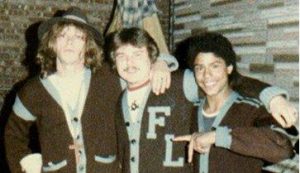
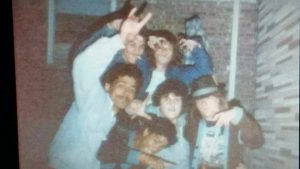
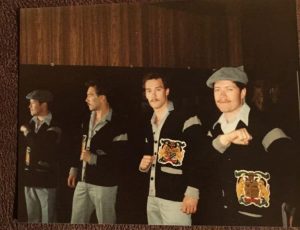
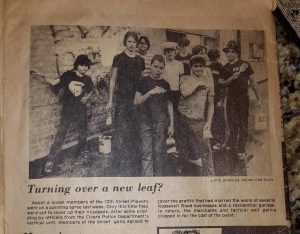
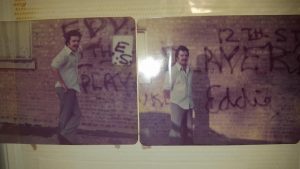
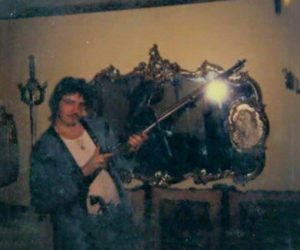
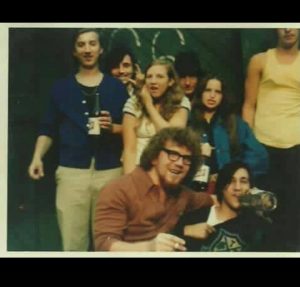
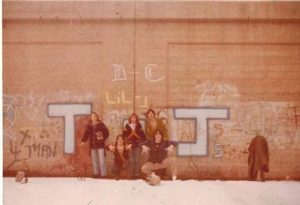
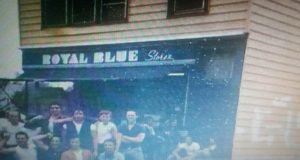

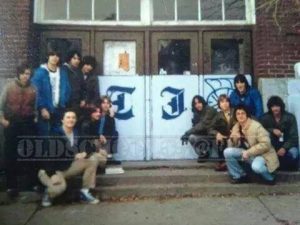
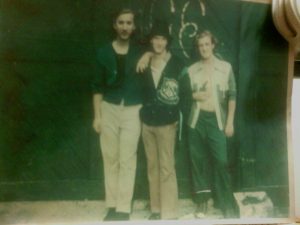
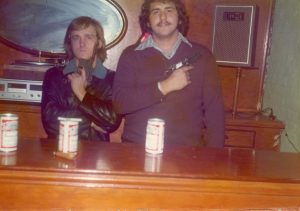
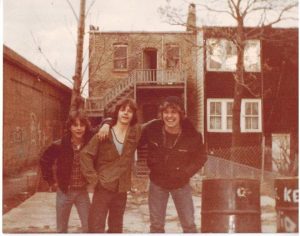
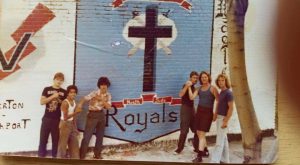
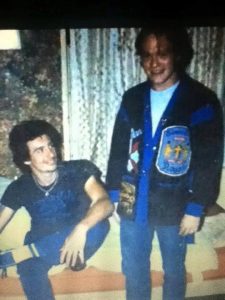
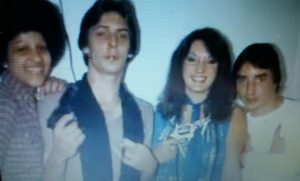
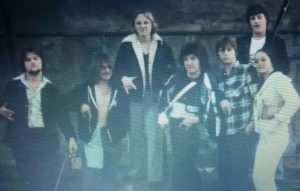
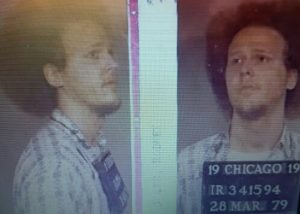
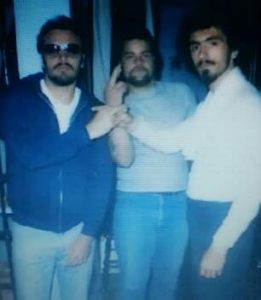
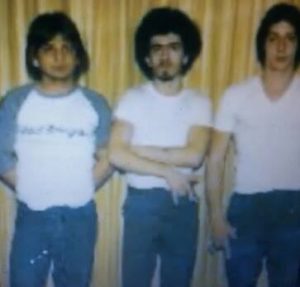
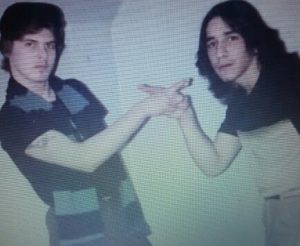
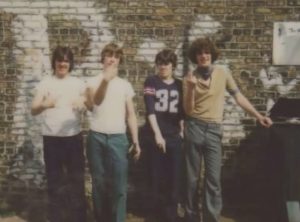
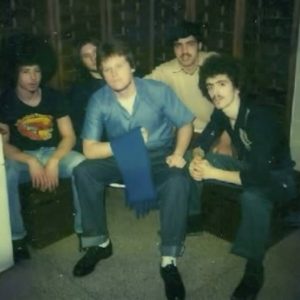
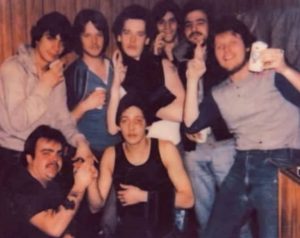
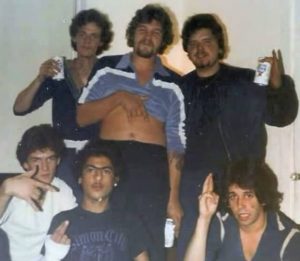
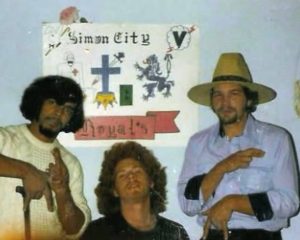
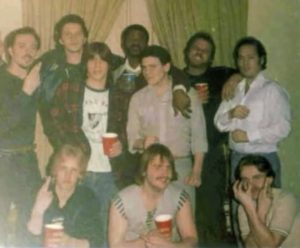
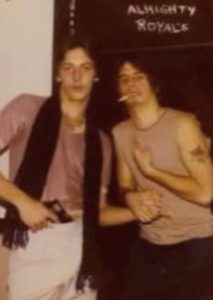
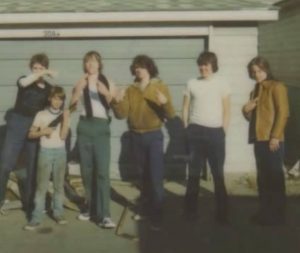
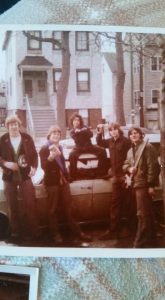
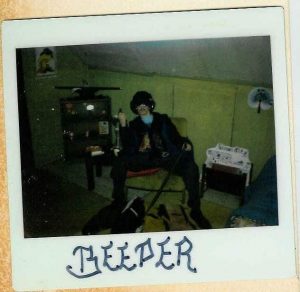
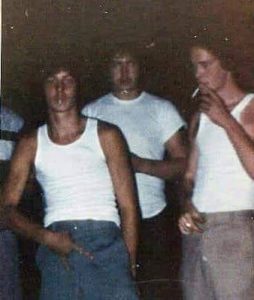
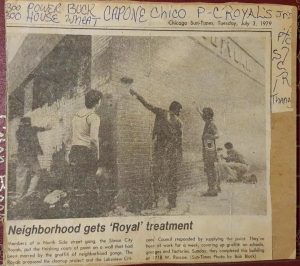
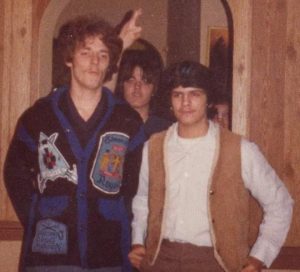
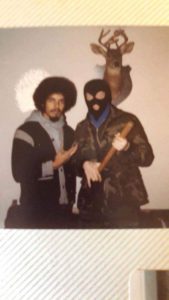
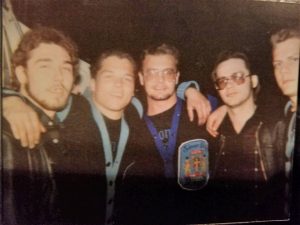
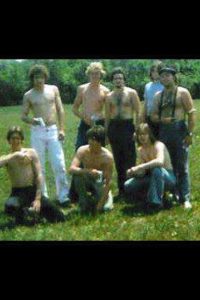
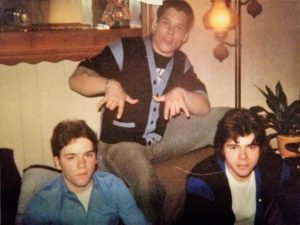
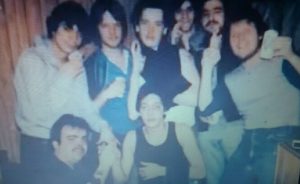
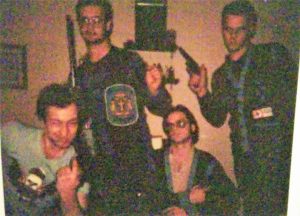
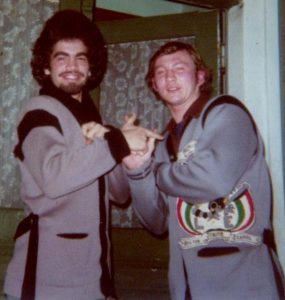
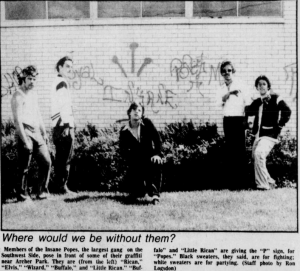
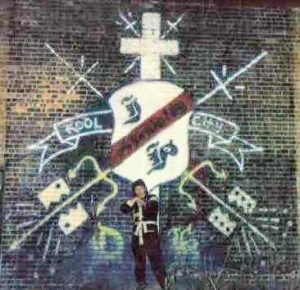
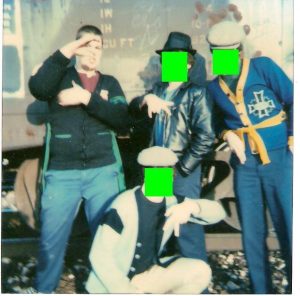
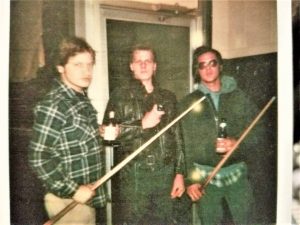
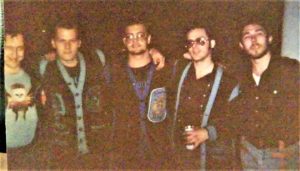
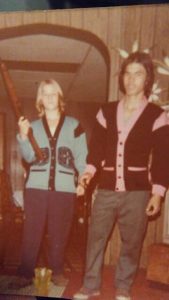
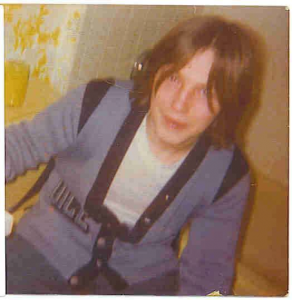
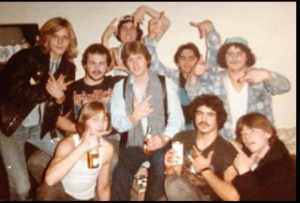
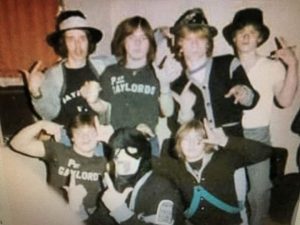
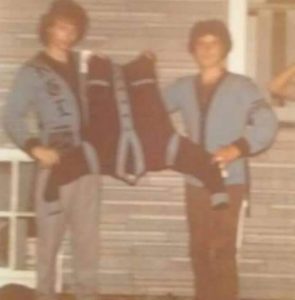
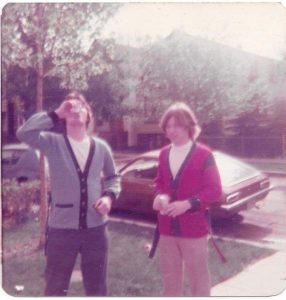
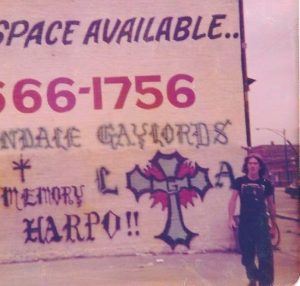
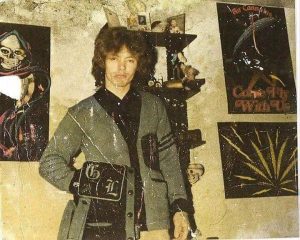
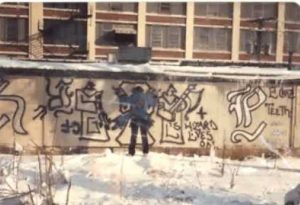
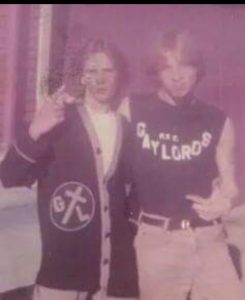
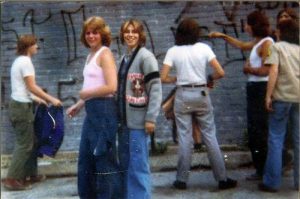
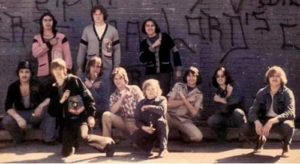
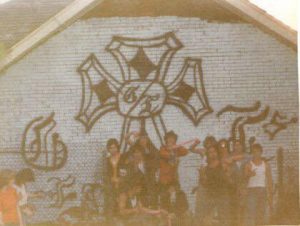
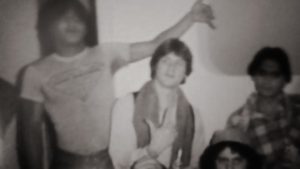
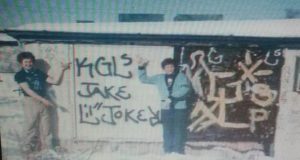
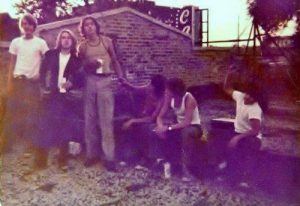

Early 1980s: The first signs of the decline
The early 1980s was the last time greaser culture would really show itself in American culture. This was also the last of the Stone Greaser era as the streets were soon to change. During these years Stone Greaser was still a major way of life for the white gangbangers and many of the white power ideals still stood but were in great jeopardy.
As I stated before, when Folk and People was created in the prison system in the late 1970s, these alliances immediately ruled the correctional system. In the year 1981, top representatives within the Black Disciples, Black Gangster Disciples, Latin Kings, El Rukns and Black P Stones became the prophets on the streets when leaders were simultaneously were released from prison. Their preaching was all about the ways of Folk and People and they laid out a roster of who was who. The roster was also opened up to taking in new organizations on the streets into these two alliances and the vast majority of gangs had no choice but to join. Just like in the joint, it became very hard to get by on the streets being in a gang and not being part of Folk or People. The white power gangs were in the most trouble as they didn’t want to be affiliated with either Folk or People especially Folk since the Simon City Royals and Insane Popes had joined. The Gaylords were the biggest target among the white gangs and this made life very hard on members in prison and even on the streets. The Gaylords made the very tough decision to join the People alliance and became the first white power type group to join the People alliance. As a rule for the People alliance the Gaylords were to drop their white power ways. Gaylords were not technically white power at all but their symbols were offensive to the black and Hispanic allies like Vice Lords, Latin Kings and Black P Stones. Some Gaylord groups followed suit and dropped those symbols and represented the five point star but others downright refused and even continued their hate for the Latin Kings. Shortly after the Gaylords joined the People alliance the UFO coalition broke up as every gang in it went to war with the C-Notes. The C-Notes began a new path very similar to the Simon City Royal and Popes. C-Notes began to slowly shed their white power ideals as they began recruiting more and more Puerto Rican members and began to focus on making money just like the Royals had begun to do in the early 80s. This was how a white gang would survive in later years, by taking in people of color and learning how to make money. These were ideals that groups like Gaylords, Taylor Jousters and Playboys refused to do. Sure these groups would take in Hispanics but were not about selling dope or hustling, they wanted to stay true to the Stone Greaser ways but that was soon to be outdated.
The northern neighborhoods were now shifting to becoming majority Hispanic in Logan Square and most of West Town. Even Uptown was becoming more Hispanic and black than white. New neighborhoods were now shifting to being heavily Hispanic like Hermosa, Albany Park and Belmont-Cragin. Hermosa especially was changing very quickly by the early 1980s and white greasers were fighting some of their most ferocious last battles against Puerto Rican and Mexican gangs. In neighborhoods like Wicker Park and Logan Square the white gangs were shrinking and some sections were already closing down while others were beginning to struggle. The balancing for these organization’s size was the heavy recruitment in neighborhoods like Belmont-Cragin, Uptown, Irving Park and Albany Park.
These were the last years that gangs in Chicago wore sweaters because of the 1981 law that allowed police to arrest gang members on the spot if they were caught wearing these sweaters. The sweater was a big part of greaser gang culture just as it was for the Hispanic gangs too so this was a big blow for the greaser. The whole city was closing in on greaser culture and many were ready to fight harder than ever for it even if it got them in prison and this is how more greasers ended up behind bars for several violent crimes.
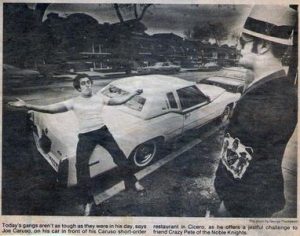
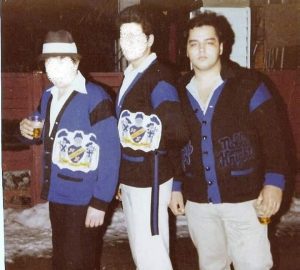
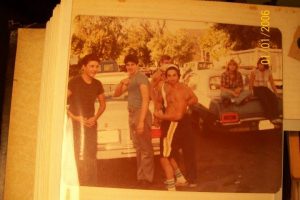
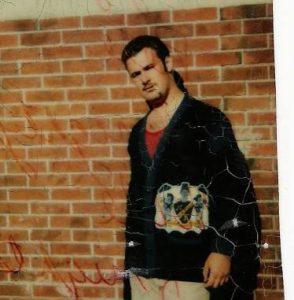
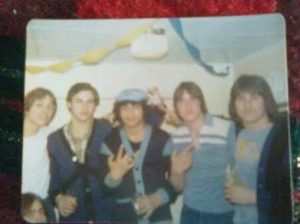
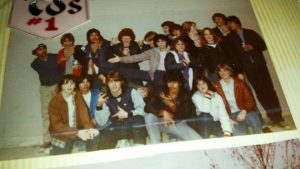
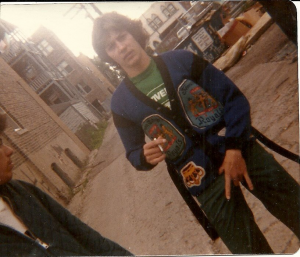
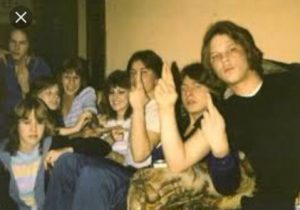
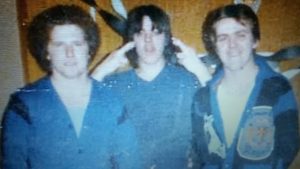
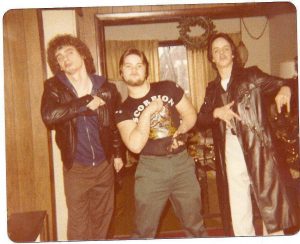
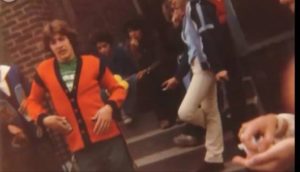
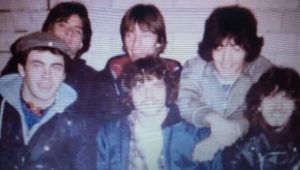
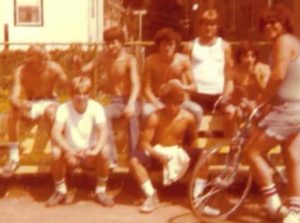
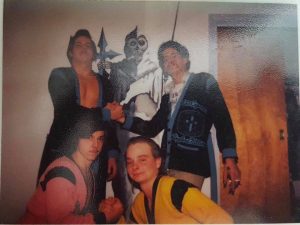
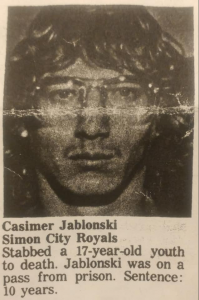
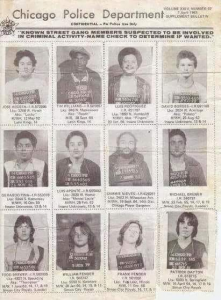
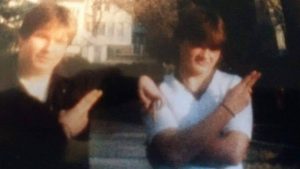
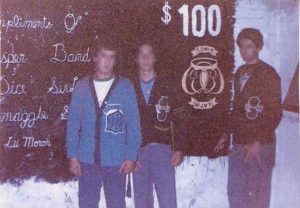
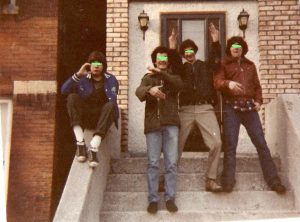
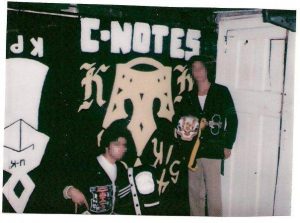
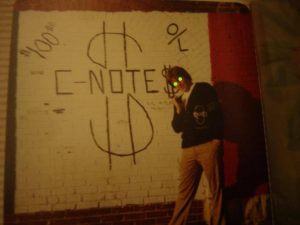
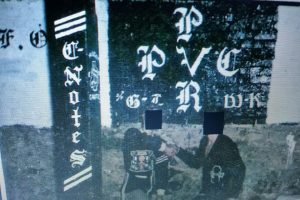
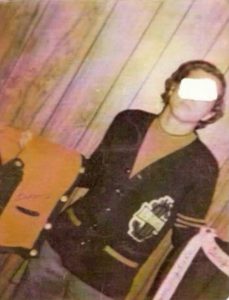
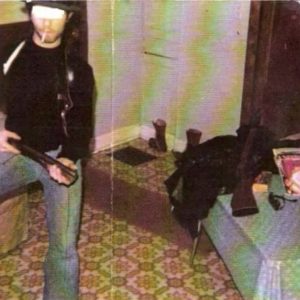
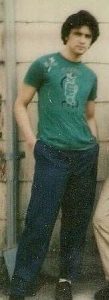
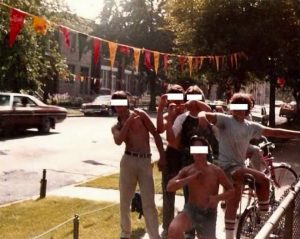
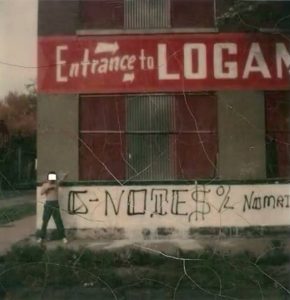
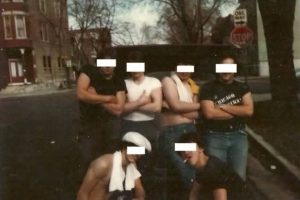
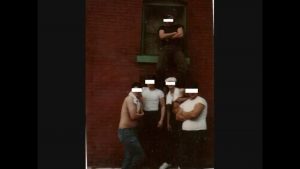
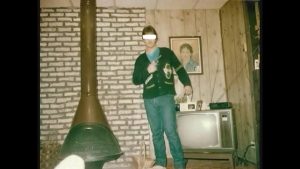
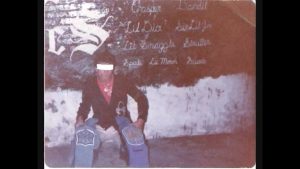
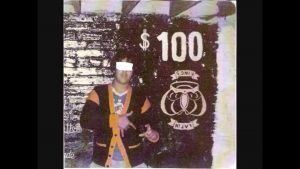
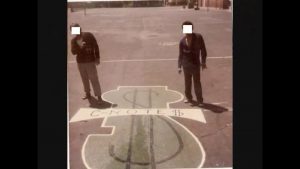
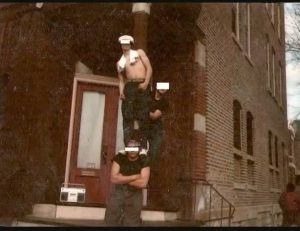
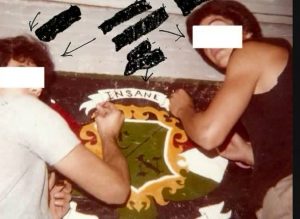
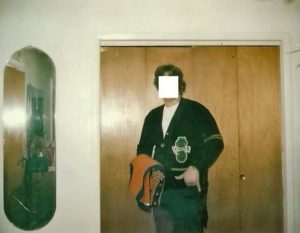
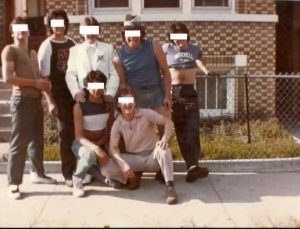
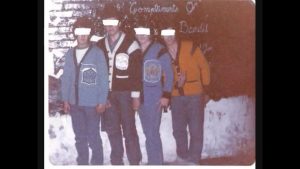
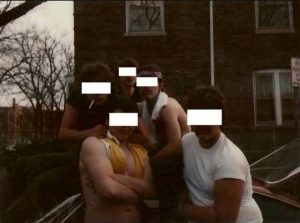
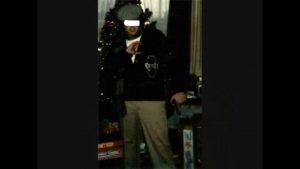
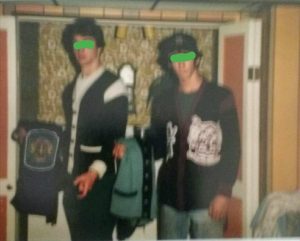
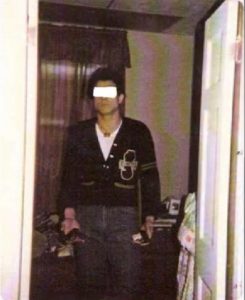
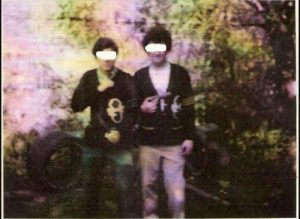
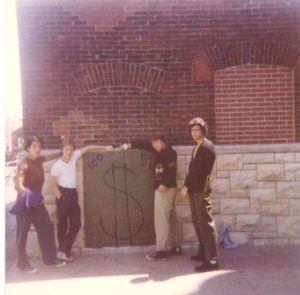
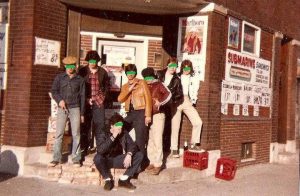
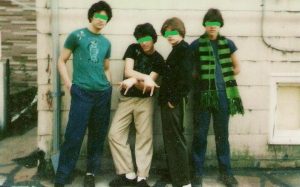
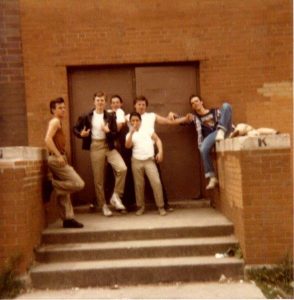
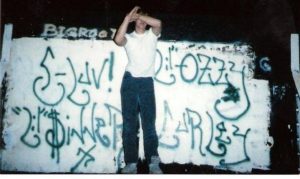
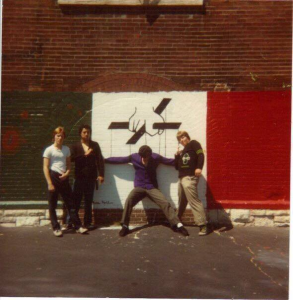
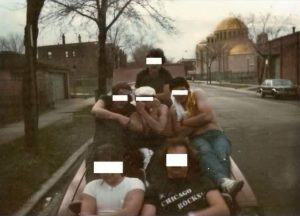
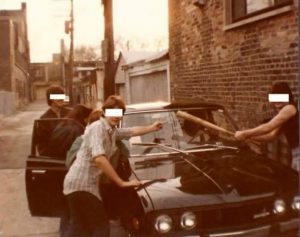
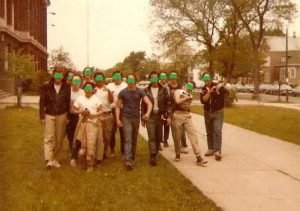
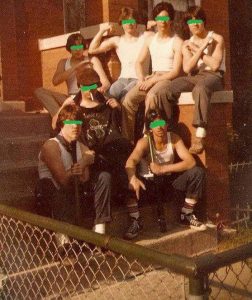
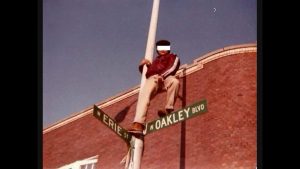
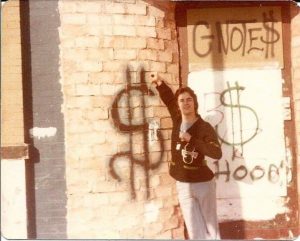
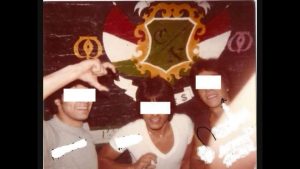
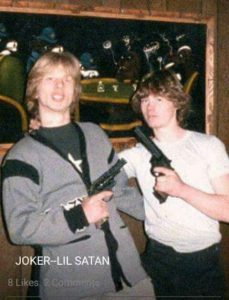
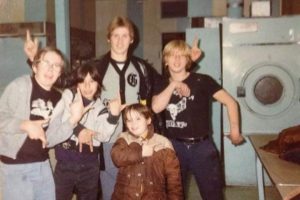
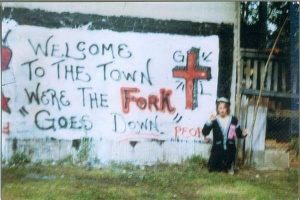
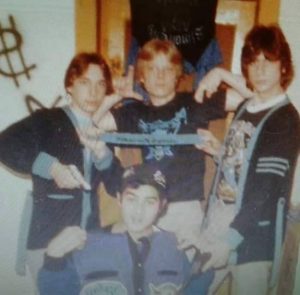
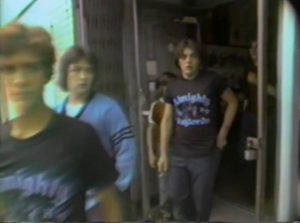
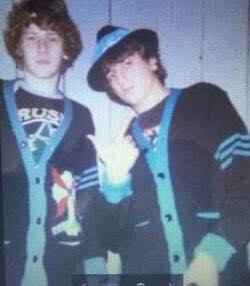
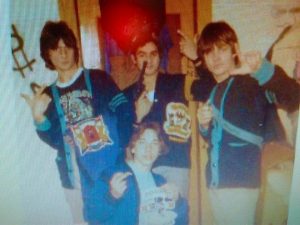
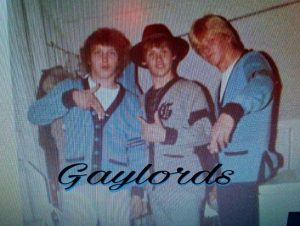
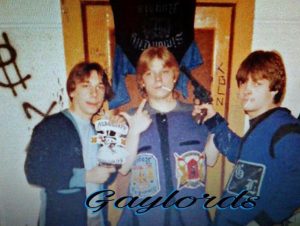
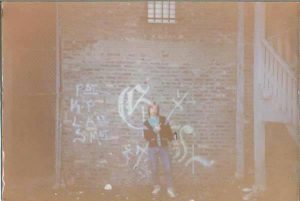
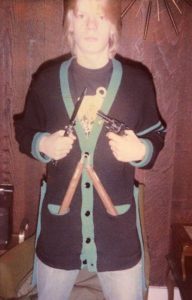
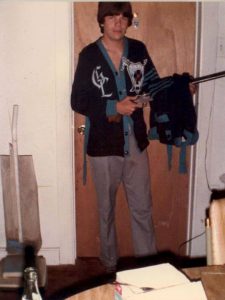
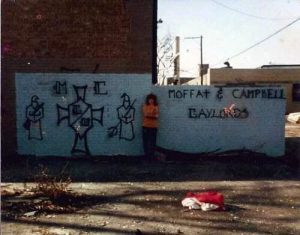

Mid – 1980s: The end of the greaser era
Although some greaser styles continued on throughout the 1980s as a revival effort across the country, for the Stone Greaser it was about passion not about fashion. By the mid-80s Logan Square, all of West Town and Hermosa had all become vast majority Hispanic neighborhoods now and there was no more room for white gangs. Taylor Jousters, Gaylords and Playboys lost all their turf in these areas which was a major chunk of their organizations. The P.V.P alliance was now just the Playboys as Ventures and Pulaski Park were now gone. Playboys packed up and made their way for Belmont-Cragin for their final stand. Taylor Jousters did the same thing as they moved all their operations to Belmont-Cragin which became their final territory. Gaylords continued operations in strength in Uptown, Lincoln Square, northern Austin and Albany Park but they had now lost Logan Square and Hermosa which were rather large installments. Recruitment had also slowed down for Gaylords as Albany Park was becoming increasingly Hispanic along with Northern Austin becoming more Hispanic and black. Uptown was now majority Hispanic and black and there was not much more room for recruitment here either. Gaylord’s growth was stunted.
Gaylords had become very acquainted with allies like the Latin Kings in some of their sections and began partying with them. Older Gaylords began trying Heroin that was often provided by Latin Kings and soon Latin Kings became the main dope dealers to these older Gaylords and this began a sad journey of addiction for some of the leadership of the Gaylords. The Gaylords were the last major white gang in the city that still stuck to the old ways of white gangs and now their nation was in jeopardy.
The Simon City Royals and C-Notes and to a slight lessor extent to the Insane Popes were doing well as they were often in the same areas as Gaylords but they were much more open to recruitment for other races and youths of other colors were more comfortable joining their ranks as they didn’t have what was viewed as white supremacist ideals anymore. The biggest lure of all was that Royals and now C-Notes were hustling and trying to make money especially Royals who had now partaken in the drug trade. Royals were hanging out regularly with fellow Folk alliance gangs becoming very close with the Imperial Gangsters, Latin Eagles and Harrison Gents. During these years Royals were even pretty close with Maniac Latin Disciples and Spanish Cobras. The C-Notes remained rather anti-social with other gangs but were coming around to operating more and more like Hispanic gangs in the area.
As I had stated, Logan Square, West Town, West Humboldt Park, Hermosa and Austin were no longer being fought over as now the fight was taken to the north west side of the city to the Belmont-Cragin, Irving Park, Jefferson Park, Dunning area as there were threats of major migration of Mexican and Puerto Rican gangs coming to the area. The issue was starting to become many of the white youths in these neighborhoods were preferring to join the Hispanic and black gangs as recruitment first opened up into black gangs and now Hispanic gangs became more aggressive about recruiting white youths. Hispanic and black gangs were also interested in making money through illegal activities while the white gangs were not and this was a big hang up for some white youths that came from lower income families. White youths first joining these organizations that were majority black or Hispanic felt they needed to prove themselves right off the bat; therefore, they often became the front line gangbangers that did a lot of the tasks the gang wanted done. Whites had been in Hispanic gangs since the 1960s but now there was a larger flood of whites joining more than ever.
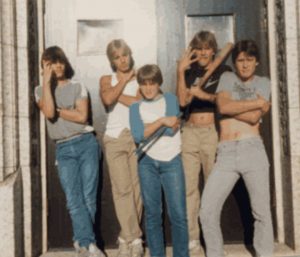
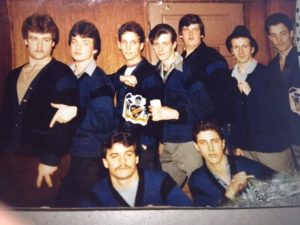
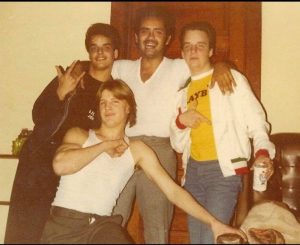
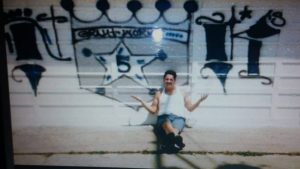
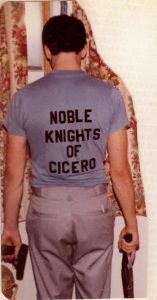
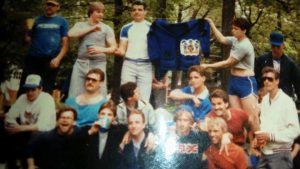
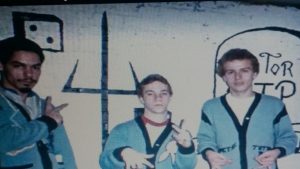
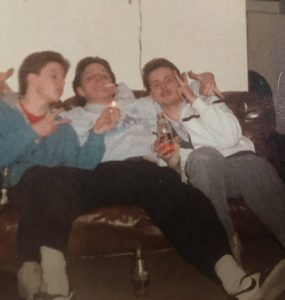
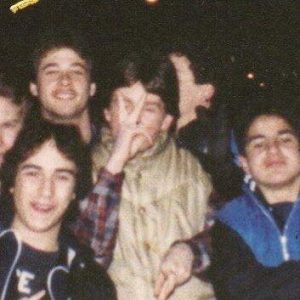
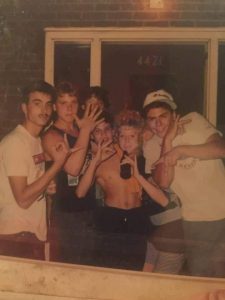

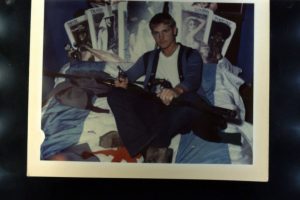
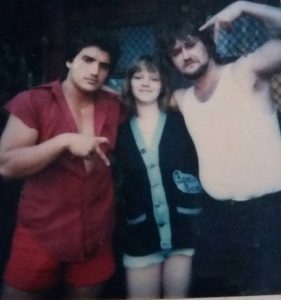
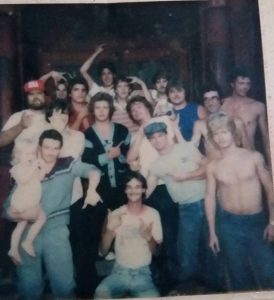
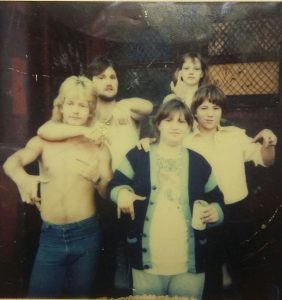
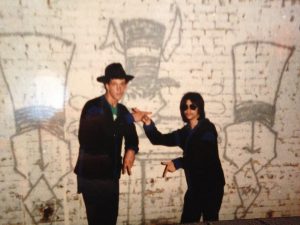
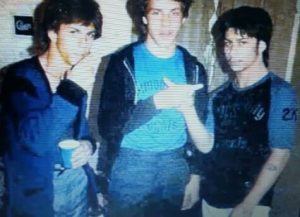
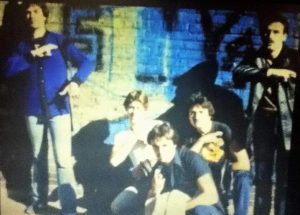
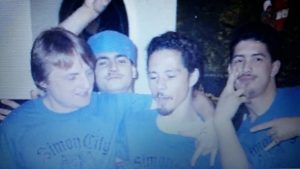
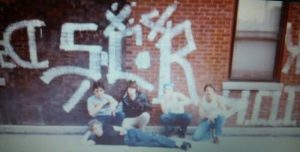
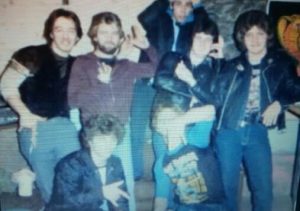
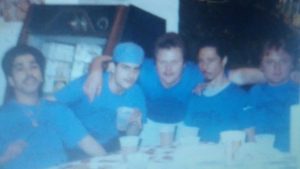
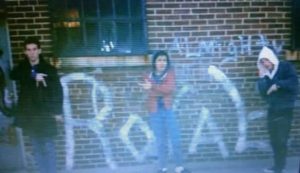
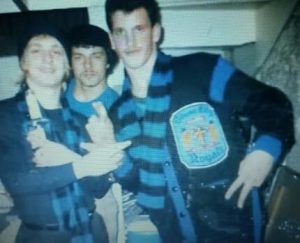
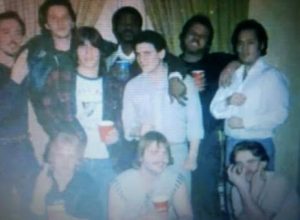
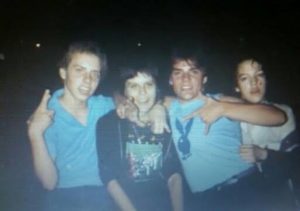
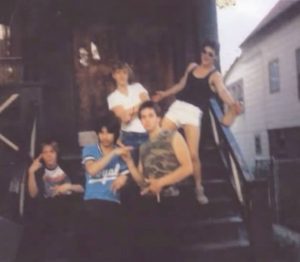
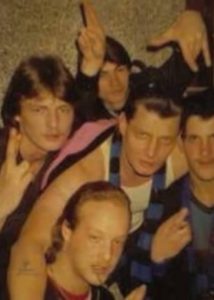
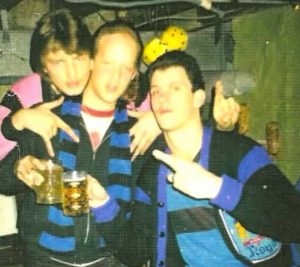
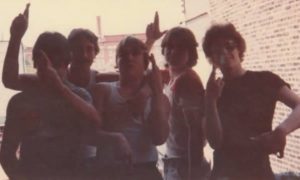
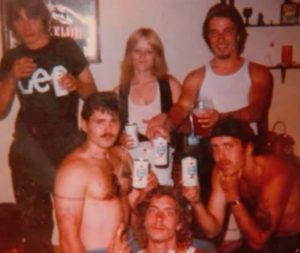
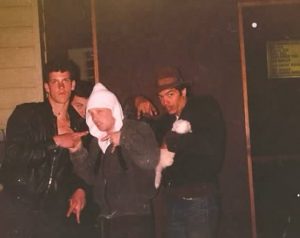
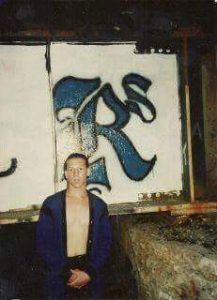
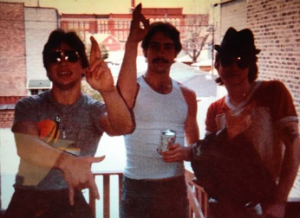
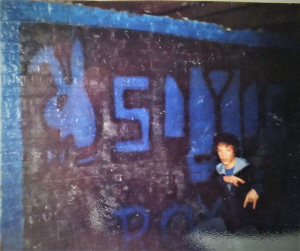
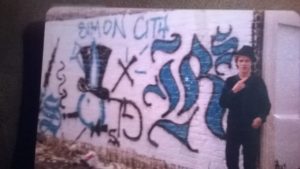
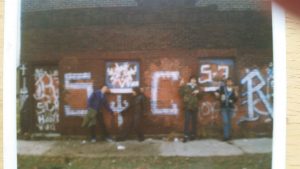
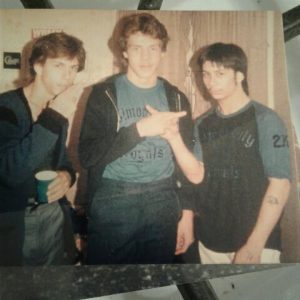
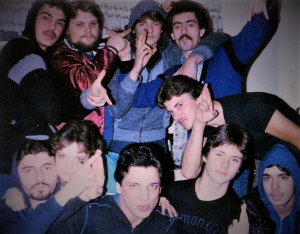
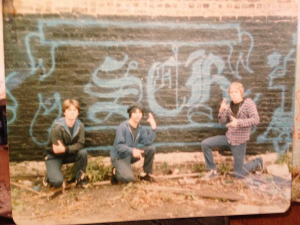
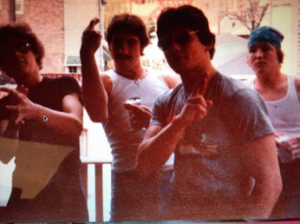
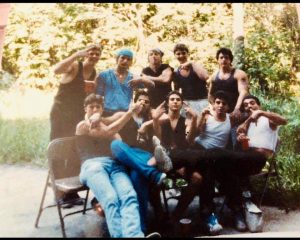
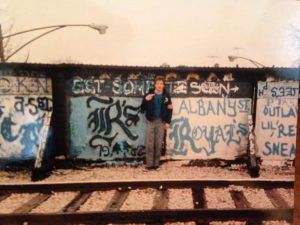
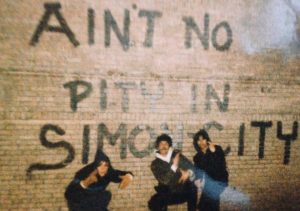
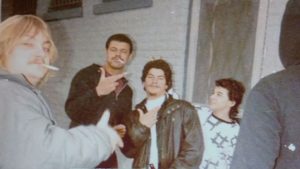
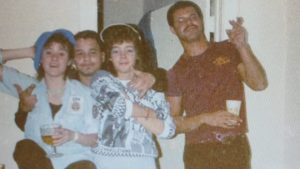
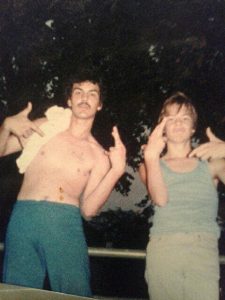
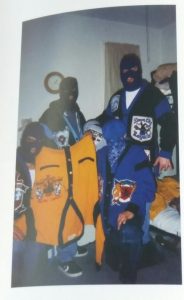
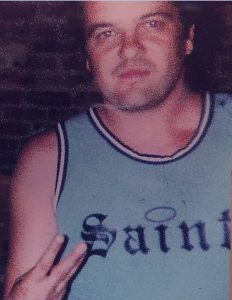
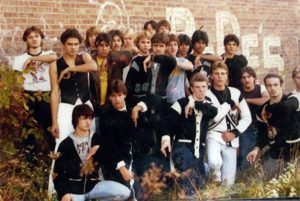
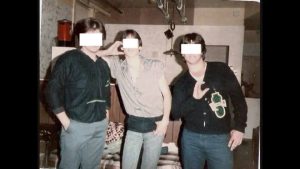
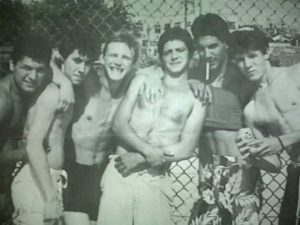
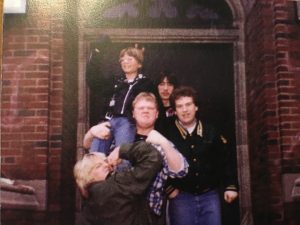
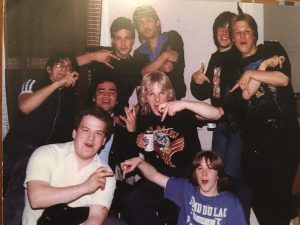
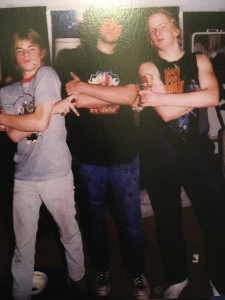
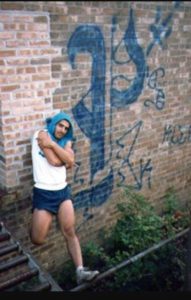
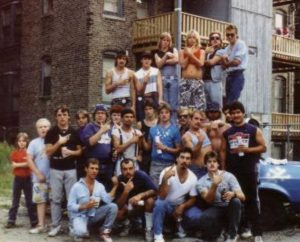
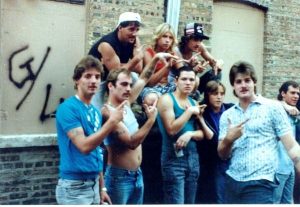
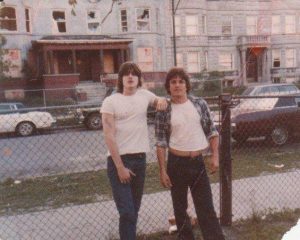
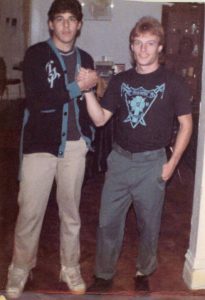
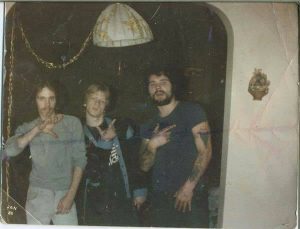
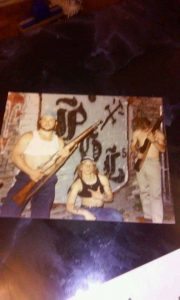
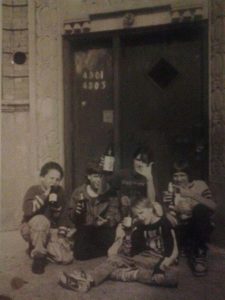
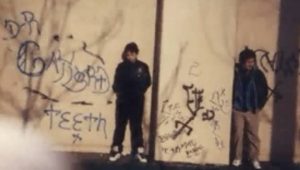
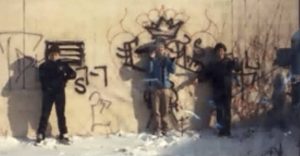
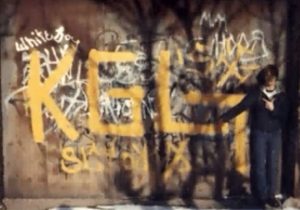
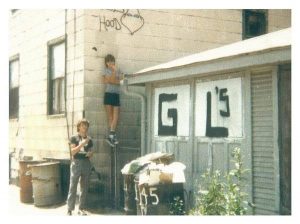
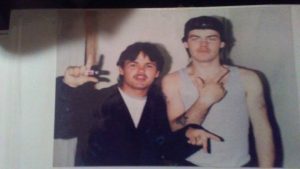
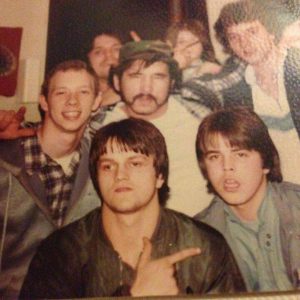
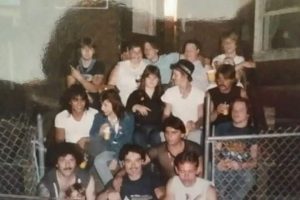
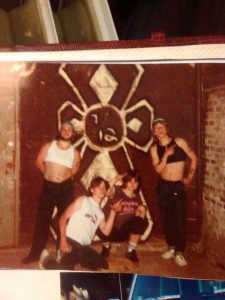
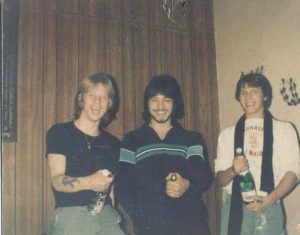
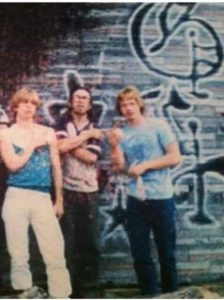
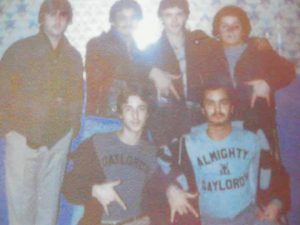
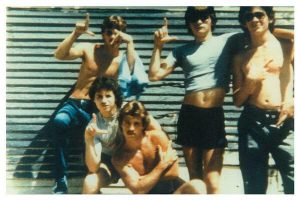
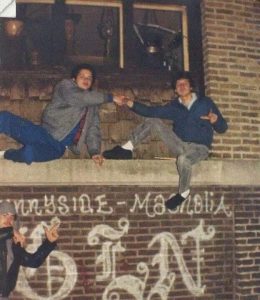
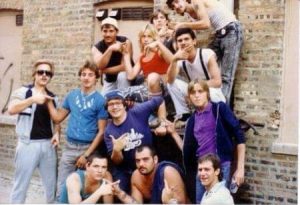
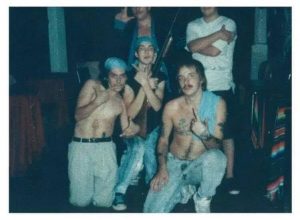
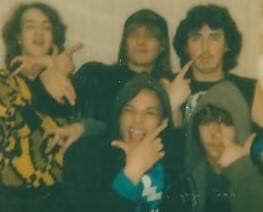
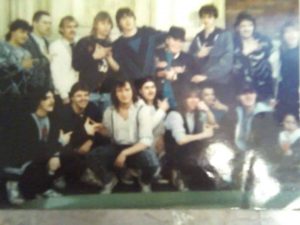
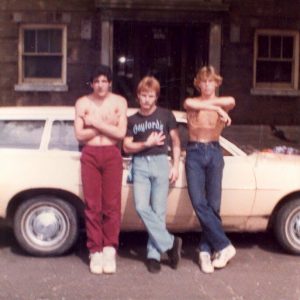
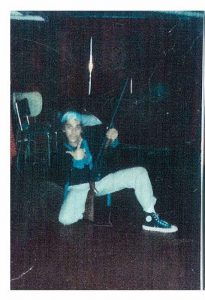
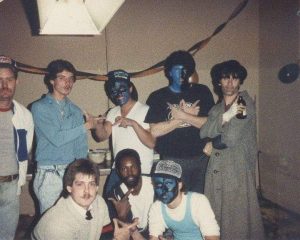
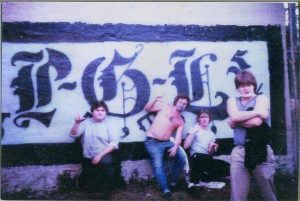
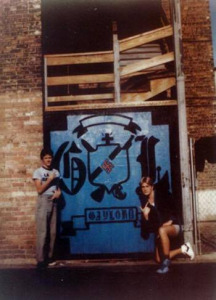
Late 1980s: The downfall
In the late 1980s, the Stone Greaser ways were fading into the past as now almost all extreme white gangs had gone extinct with the exception of the Taylor Jousters still holding Hanson Park in Belmont-Cragin and the Gaylords still holding Uptown, Irving Park (Kilbourn Park area) and Austin (Sayre Park area). The Playboys were having their last stand at Cragin Park in the Belmont-Cragin area but the end of the decade they were gone from Chicago area forever.
Selling drugs and joining black and Hispanic gangs became the way of life for gangbanging white youths as many were flipping from white gangs like Gaylords into gangs like Latin Kings and Maniac Latin Disciples. Much of the leadership of the Gaylords became addicted to Heroin now and many were thrown in prison for drug addiction related crimes. This was not just in the Gaylords, there were many leaders within smaller white gangs that got addicted to drugs in the 1980s that led to those organization’s downfall. The Playboys were even known to have addicts among their ranks as far back as the 70s.
Drug addiction was a big thing among all the gangs no matter how large in size or what race the gang was. Sometimes it came from partying too hard and being around the stuff too much. Other times guys got addicted from selling so much of it they gave into temptation to put it up their nose or in their veins. Another cause was PTSD from the streets. The streets are a war zone where the average gangbanger in the 80s and further back saw so many killings and messed up situations and it had a traumatic effect that led to PTSD. Many PTSD sufferers turn to self-medication from alcohol and drugs, while some gang members even suffered mental illnesses. Sometimes that whacky gang member they may give nicknames like, “Crazy,” “Psycho,” “Loco” may actually legitimately suffer from mental disorders and their glorified reckless gangbanging behavior that fellow gang members admired and rivals feared maybe the result of a severe psychotic episode. A documented case of gang leader with known disorders was Brian “Mouse” Nelson of the Simon City Royals. Brian Nelson was a highly respected and feared gang member due to his craziness and unpredictable violence which eventually got him a leadership position in the organization while also getting him thrown is supermax prison. Once inside Nelson was treated terribly and his documented medical conditions were not given recognition and ignored leading him to attempts at suicide and downright spiraling into insanity. The man suffered tremendously until he was finally released. He now works with mistreated inmates and advocates for them. We must never lose sight of the fact that just because these men are gang leaders they are still human beings like all of us.
It was a known fact that drugs and money became a much larger focus for Chicago street gangs by the late 80s. In the 70s the older gang members in Hispanic gangs were the only ones that distributed drugs while the young ones may have served as just couriers for a fee. In the black gangs young dope dealers began to appear in the 70s after a new law imposed in 1971 imposed tougher sentences for adult offenders of drug trafficking crimes. It wasn’t until the 80s that we began to see many more juvenile drug dealers that often answered to older teen dealers. By the late 80s black and Hispanic gangs were moving this stuff in major volume on the streets as young gang members were now selling lots more of it. With all these juvenile drug sales on the street corners came more competition which led to more violence. Of course, there needed to be a grand prize for kids to strive for in these neighborhoods to get them to kill each other, that prize was Air Jordan basketball shoes. If you talk to anyone that grew in the streets in the 80s they will tell you just how crazy people would get over these shoes which led to robbery and even killing. Young teens sold drugs just to fund these shoes or any other flashy clothes and jewelry. Young teens growing up on the streets were tired of being poor and that even included young white boys still stuck in the city. This lure of money and being in a bigger gang took over the interest of young white boys making them lose interest in the old Stone Greaser ways. Only white gangs that assimilated to new ways like Insane Popes, Simon City Royals and C-Notes were doing better than white power type groups.
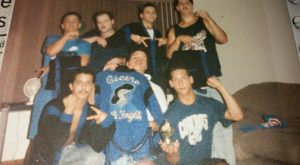
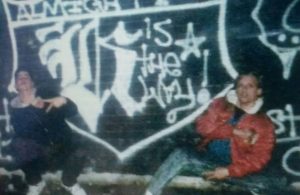

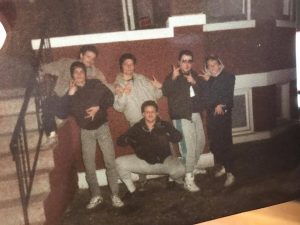
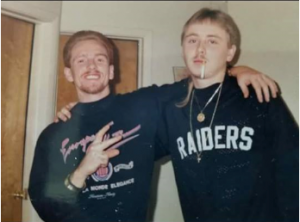
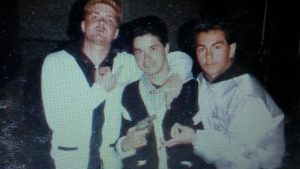
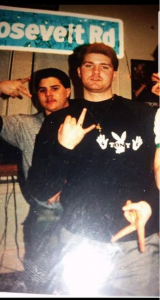
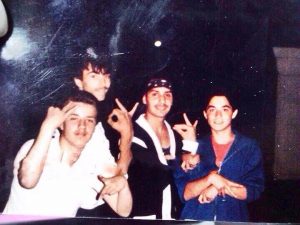
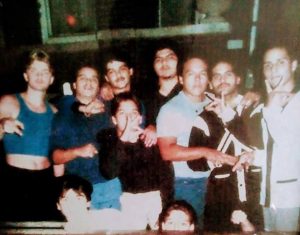
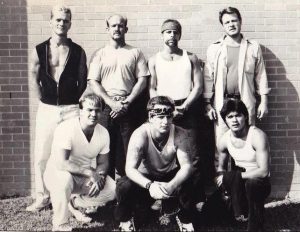
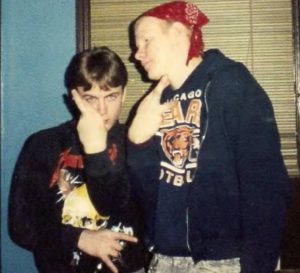
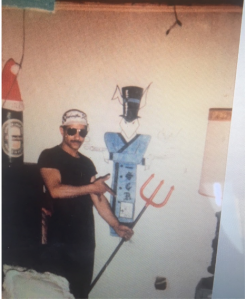
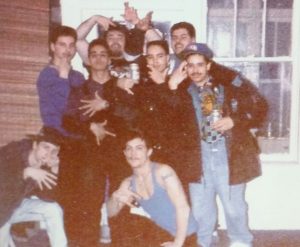
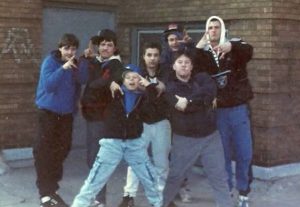
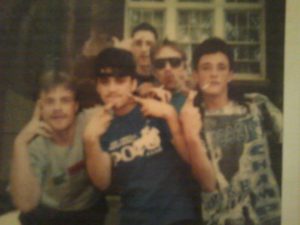
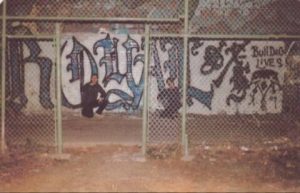
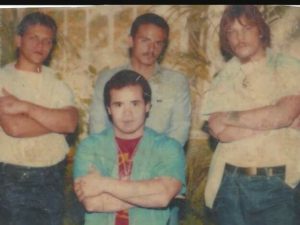
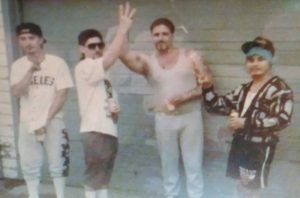
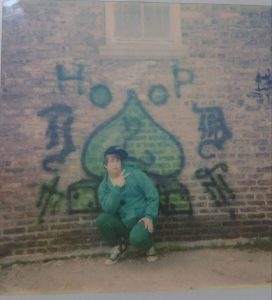
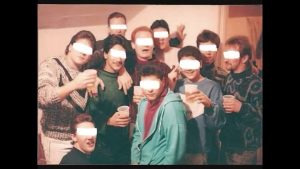
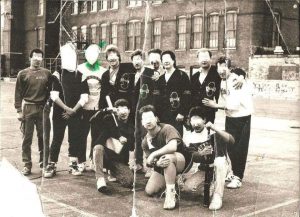
Early 1990s: Drugs and drive bys
The early 1990s was an extremely dangerous time period in Chicago history. Police were still very crooked, graffiti was still plastered on all of the walls in the city, gun shots rang out day and night, hundreds of gang members still gathered in the streets, all the project high rises still stood high in the sky. Most everything was the same as ever with one difference, now guns were everywhere. Even little kids as young as 9 were carrying guns and popping them off. Beating down a rival gang member until he cried uncle was no longer a big deal, now you could be considered a billy bad ass if you shoot someone and this became the norm. Because of all the gun play on the rise gang members often didn’t get out of the car anymore when they spotted a rival and would instead just shoot as they drove by; the problem was innocent bystanders often got clipped by gun fire but it didn’t stop the drive bys because they knew if they didn’t shoot now that same guy would be selling on their turf soon enough or talking shit about them the next day.
This was a new world that the Gaylords and Jousters were just not used to with selling drugs on the corners and doing shootings instead of fights. Gangs had been using guns to shoot each other down for generations but that usually only happened if they wanted to take someone out of importance or if that rival did something real bad to the gang or someone they knew. There were rules and laws gangs had to abide by that protected innocent bystanders from getting struck down in the past. You couldn’t begin shooting if there were innocent people in the way or you would suffer consequences for breaking those rules. By the 1990s, those rules were becoming less harsh or in some sections leaders just didn’t care anymore as long as the cash was flowing in.
You may be asking in your mind right now if what I am leading up to is that the Gaylords and Jousters didn’t have the guns to compete in this new gang world. The answer is no, the Gaylords and Jousters were always well armed since at least the 1960s. Gaylords and Jousters were shooting rivals dead in the streets in the 1990s but refused to open fire when an innocent could be struck down. Jousters and Gaylords had shotguns, pistols, rifles, revolvers and even some automatics, they were ready to fight their last fights. Jousters where all over Hanson Park strapped and no other gang could dare come through without permission.
In the Uptown neighborhood the Gaylords began partaking in the drug trade for the first time as they went into business with fellow People alliance allies the Black P Stones. This deal greatly burned them as they ended up heavily incarcerated on drug charges which brought about the end of this section of Gaylords. The Black P Stones were big enough to bounce back from convictions but not the Gaylords, it destroyed their presence in the neighborhood. This is why Stone Greasers usually don’t deal drugs. The Simon City Royals and C-Notes were more successful in drug operations but even many Royals got burned and ended up locked up especially high ranking leaders. C-Notes plugged into a really complex drug game and were even changing the look of their mob as more Puerto Rican and Mexican members became prevalent. The C-Notes became very much about business instead of white pride while Royals were on the same issue but just dealing with more hurdles.
Regardless of the fact that Popes, Royals and C-Notes were adapting to the new gang ways they still didn’t see nearly the recruitment numbers that Hispanic and black gangs experienced. In the suburbs Royals were not real wide spread and C-Notes and Popes barely touched the burbs. Regardless of this, white boy gangbanging was at an all-time high in the suburbs and that’s because they were now easily latching onto Hispanic and black gangs that had grown into suburbia. Now that almost all the white families had partaken in white flight over the decades they ruled many suburbs and once organizations like the Latin Kings, Two Six, Satan Disciples, Gangster Disciples and Vice Lords landed in these suburbs these branches were mostly white and these chapters were even ran by white guys. The white boy gangbanger now was taking on a different persona. Instead of being a Stone Greaser he was now mocking much of the fashion and slang of black and Hispanic gang members and often engaging in behavior he deemed necessary to be viewed as an equal to his black and Hispanic peers. Many other whites would regard these guys as “wanna bes” trying to be something they are not. Some of these guys were indeed just clowns acting foolish but many other white gang members in these organizations would really prove to be down guys that graduated into the hardcore lifestyle of the gang life. It is very important to distinguish between the white goofy wanna be gangster that has a big mouth and the one that has put in real work and can prove it, he will normally not have a big mouth.
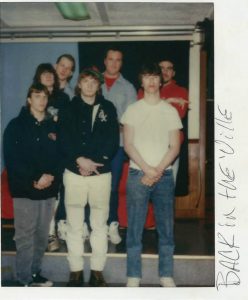
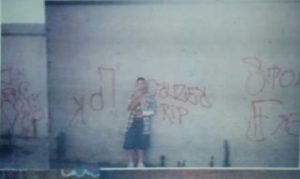
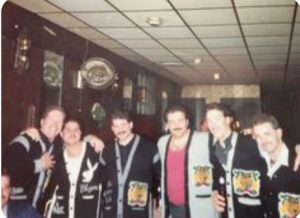
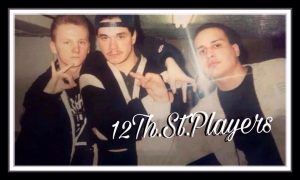
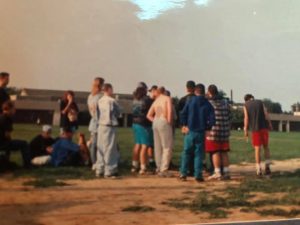
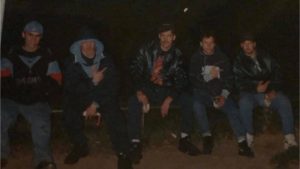
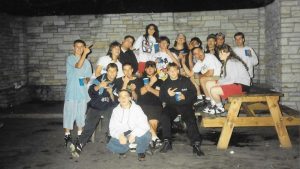
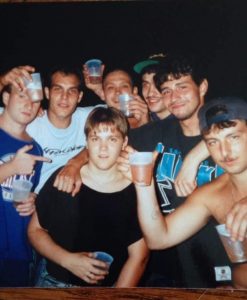
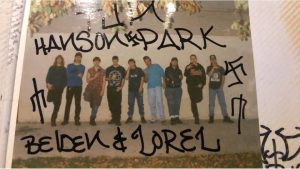
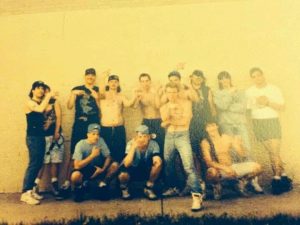
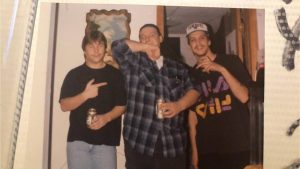
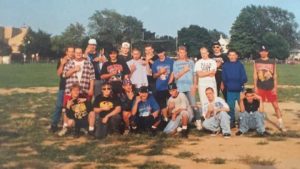
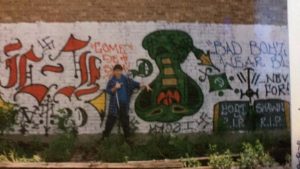
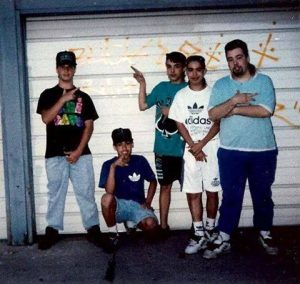
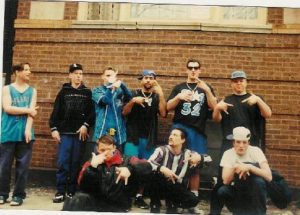
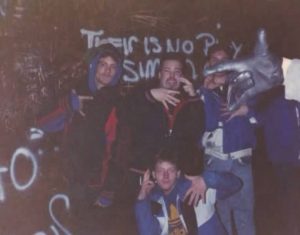
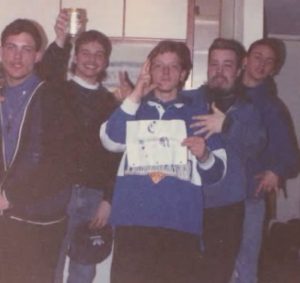
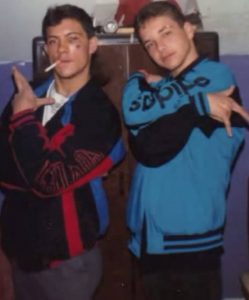
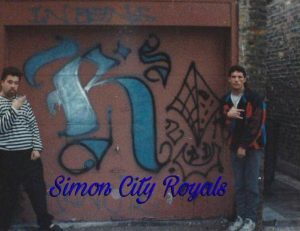
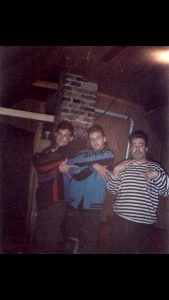
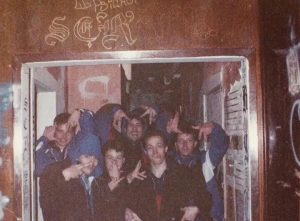
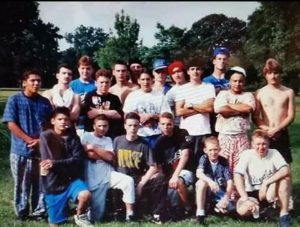
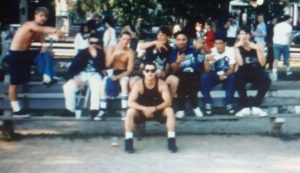
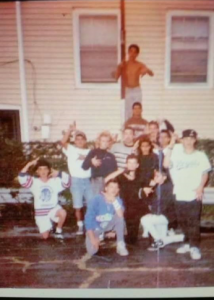
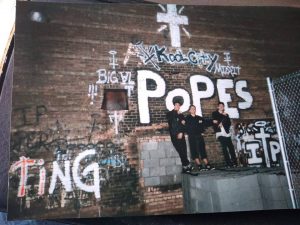
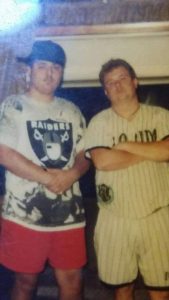
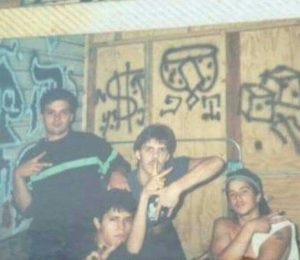
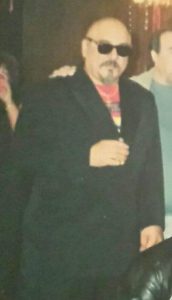
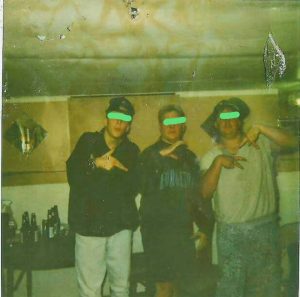
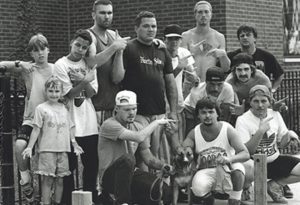
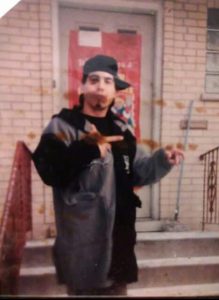
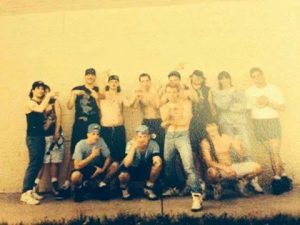
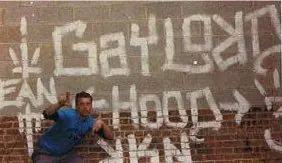
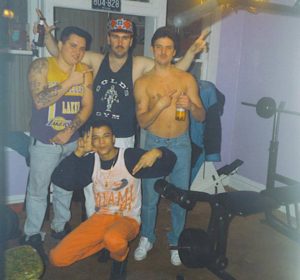
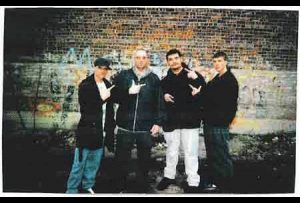
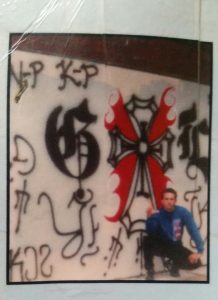
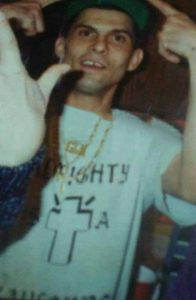
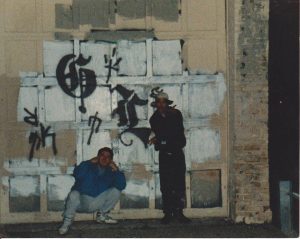
Mid-1990s: The last stand
The early 1990s saw some of the worst murder rates in Chicago history. In the year 1992 Chicago experienced 943 homicides which was the second worst year in history right behind 1974 at 970 murders. The difference between 1974 and 1992 was now innocent bystanders were getting mowed down by gunfire unlike in 1974 when gang hits were more controlled and organized. The reason 1974 was higher is because gangsters were just more savage and law enforcement was less existent when serious crimes went down. The reason for the high rate in 1992 was shooting after shooting in many drive bys and other sloppy execution methods.
Regardless of the new shooting methods in the early 90s there were still many laws that gangs imposed upon themselves for messing up shootings but in the mid-90s order was beginning to break down. In the early 90s it was allies turning on each other but by the mid-90s there were more cases of factions of organizations turning on each other. Much of this was caused by the drug trade as this was now the main focus of the gangs and if your organization didn’t make money as the main focus it became very hard to claim territory in the city limits or even the suburbs. This became a very tough situation for the Jousters and the Gaylords as they still refused to submit to this type of gang life.
Both Gaylords and Jousters were blazing guns while some of their members suffered bullet wounds and/or jail time. For the Jousters, defending Hanson Park was very tough, tough for any gang to take that park but the Jousters held it very strong which drew them into hard core gangbanging. The Jousters were surrounded by Hispanic gangs all chomping at the bit to take the park and Jousters gunned at them all. In Sayre Park the Gaylords engaged in a legendary bloody war with the Insane Dragons and the Latin Brothers. The war was very nasty and cost lives but the Gaylords made their last stand at claiming turf. The spirit of the Stone Greaser was still alive in these organizations.
Royals, Popes and C-Notes now had many different races among them. C-Notes would only take in Hispanics among other races but Royals and Popes were very multi-racial now. C-Notes had now joined the Folk alliance in 1995 but were still enemies with Royals and Popes because they were attached to different families within the Folks. The ways of the Stone Greaser would never die with the old schoolers within the Royals, Popes and C-Notes, but the younger guys were not greasers but had the job of protecting turf.
The mid-90s was definitely the final years you could see many white gangbangers moving about the city actively. In the suburbs the white gangbangers were very active and many legends were coming up in the burbs, especially Cicero that was the land of the Noble Knights, Twelfth Street Players and Two Two Boys, all had many whites in their ranks or were majority white. In the southwest side of Chicago South Side Insane Popes were buck wild in the 70s, 80s and 90s and had some of their craziest years by the mid-90s as they gunned at rivals. Some really down white gangsters came from these areas but by the late 90s many were facing jail time or were beginning to retire.
The later 90s brought lots of slow down for the white gangsters as the rest of white flight ran its course even out of suburbs like Cicero. Heading into the new century the Gaylords no longer claimed any turf and only unofficially were still running Kilbourn Park and Sayre Park but you couldn’t see them on the block anymore. Jousters finally withdrew from Hanson Park in 2005 after winding down slowly in the early 2000s and Hispanic gangs only moved in after the Jousters fully moved out in 05, that’s how much the Jousters had made an impact on that territory.
Heading into the new century the white gangbanger became increasingly scare in the city to the point where it became hard to find. In the suburbs there was even a major reduction in gangsters and many that were still around were not very feared or respected. Chicago as a whole outgrew the very street active gangs but the true white gangster seemed to completely disappear from the scene.
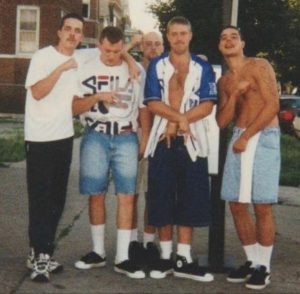
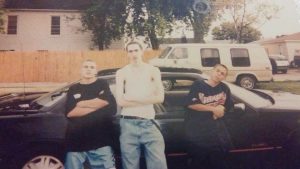
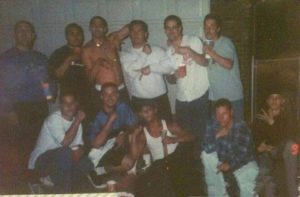
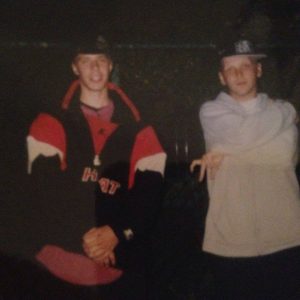
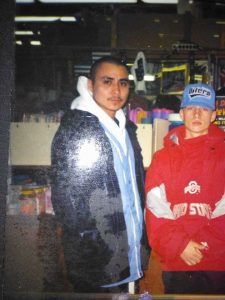
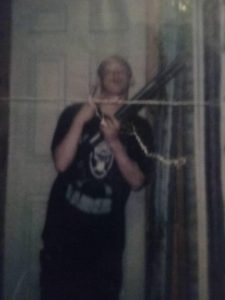
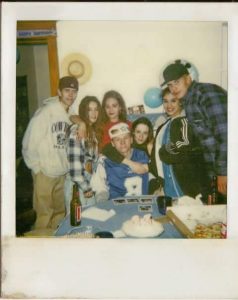
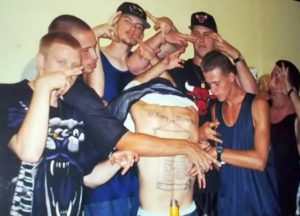
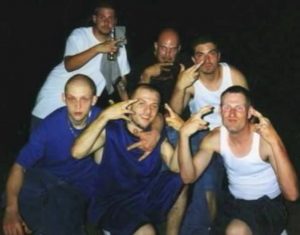
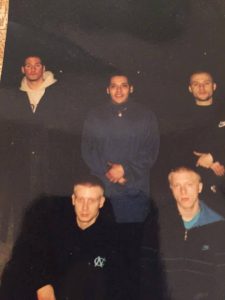
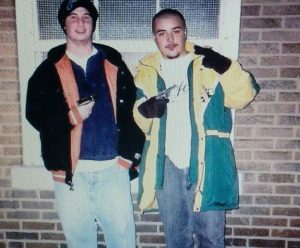
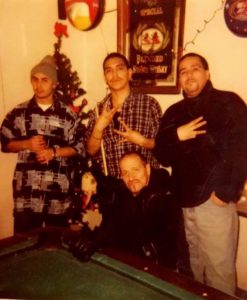
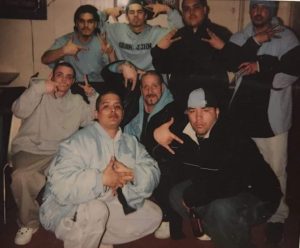
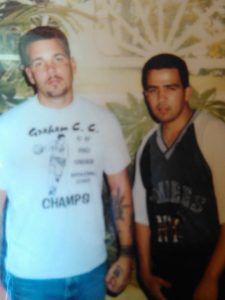

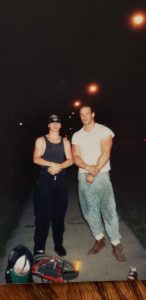
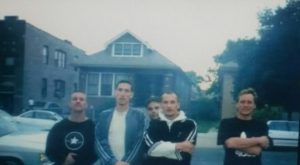
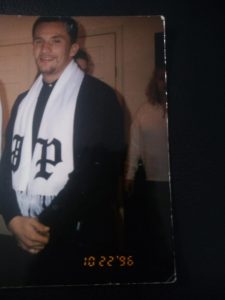
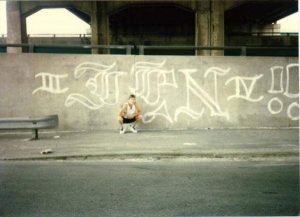
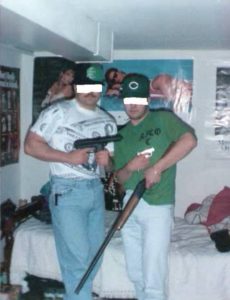
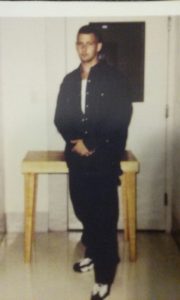
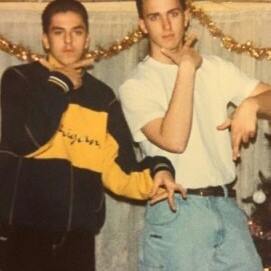
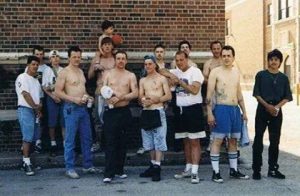
Conclusion
From the dank, dark and dirty streets in the slum district to the picket fences and bungalows to the deteriorating declining hoods. From the slum dwelling dirty faced youths to the ducktail haired, leather jacket wearing cuffed jean teens to the gang sweater clad toughs to the saggy pants hip hop teens; the white gangbanger had a long ride of well over one hundred years until he became mostly forgotten in the cityscape of Chicago.
Indeed the most admirable and fascinating era was the greaser era of the late 40s to the early 80s. Greasers were rough and tough and there was a bad boy romantic type side that drove the girls crazy and the girls drove the greaser more crazy as this was one of the main issues they fought each other. Teen dances, drive ins and drive thru hamburger stands were the hangout of these local toughs looking for a good time and some action. These boys evolved into the rugged Stone Greaser of the 70s that was twice as crazy as the 50s greaser. The greaser of the 50s came from green grass and picket fences but many times the 70s greaser came from rows of beat up buildings and the land of dope pushers and pimps as he wore his colorful club sweater and battled the black and Hispanic gangs. The white gangster of the 80s and 90s learned from the Stone Greaser and many evolved into some hardcore sawed off gangsters. The 21st century killed off what was left of this influence and to many this seemed like a good thing at first because of how wild and dangerous the greaser influence could be but in reality the streets became worse. Now the Stone Greasers have grown old and have families, many of which are now law abiding decent men that provide for their families and often have good jobs. They may have felony records and have a history or serving prison time but they still came from a time of rules and morals unlike the current gang landscape that has no structure and often lacks any morals. We can learn from the greaser era of how to be a valiant street warrior without the heavy cost to the rest of society. Sure the greasers robbed and stole but very few innocent people were killed by greasers as opposed to much of today’s gangs that often rob and kill and beat or shoot innocent civilians; this behavior will perhaps increase over time making the future possibly look bleak.
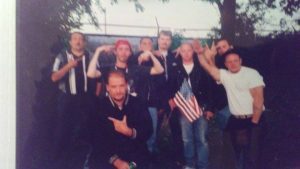
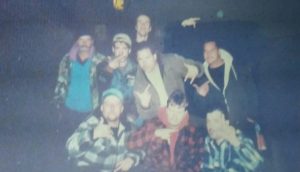
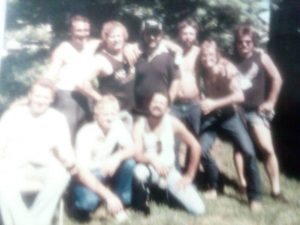
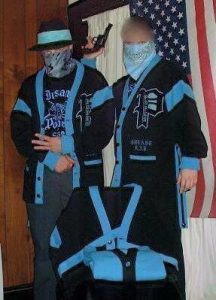
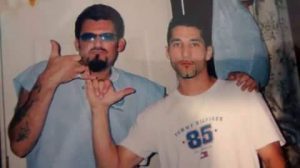
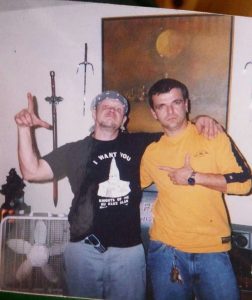
Many of the greasers retired as they got older but some didn’t want to end the gang life but had outgrown some of the active organizations or perhaps the organization they were part of folded. These older greasers ended up joining the ranks of 1%er biker clubs in the Chicago area, most notably the Outlaws MC. It is ironic that the greaser learned from the biker in the late 40s and now ended up becoming a biker in later years after being a greaser through most of their youth. The way of life went from biker to greaser then back to biker. The common shared aspect of each lifestyle is a sense of freedom, a certain freedom normal people in society will not understand. Greasers and bikers were developed by misfits of society that grew tired of conformity and sameness. Many of these misfits see the world for what it really is and see ugliness that others do not see. For the earliest bikers this vision was seen by veterans coming back to a world they no longer could relate to after seeing the darkest and ugliest side of humanity. This is difficult to come back from especially after returning to a mostly ignorant and naive society of people socially trained to be cohesive thinkers and followers. The biker and the greaser were lone wolves that strayed from the flock of sheep and couldn’t fit until they found a pack of wolves just like them. The wolf can wonder alone and survive on his own but when he finds a pack of like minded wolves his life becomes complete. Most people in society will never understand this lifestyle mainly because most of society has not seen the ugliest aspect of human life and because most will not understand this type of freedom. Many greasers and bikers experienced hell at home as children, real poverty and/or fought in barbaric wars where blood shed was common and savage. Even in today’s society men still come home from Iraq and Afghanistan as changed men and will sometimes gravitate to the 1%er club after return. The 1%er meaning runs deep as I had said most of society will not understand or relate. Only the 1% can be that wolf that can find his pack. Many were once greasers in their youths and were 1% by heart back then now they have returned to the influence where it once come from. They have come home.
White boy hall of fame clubs: The streets’ toughest
Almighty Popes – These guys spawned out of the Insane Popes from 62nd and Normandy after a disagreement with their own gang in 1994. 62nd and Normandy Popes wanted to make money and have equal opportunity for all races that the rest of the IPN wasn’t too keen on. After the split the APs went buck wild closing in on enemies, recruiting aggressively and shooting their way through the midway area quickly snatching their claim to fame. They soon exploded in numbers and even flipped some IPN sections making them the new force to be reckoned with on the southwest side. They opened legendary suburban chapters in Bridgeview, Orland Hills and Justice as they soon filled their ranks with some heavy hitters. Their exploits got into the heads of some of the younger members and one 15 year old reckless member shot two 13 year old girls to death causing the police everywhere to crack down on them. Another leader in Orland Hills threatened to stab a woman to death bringing the downfall to the last section. Their reign was short lived but legendary.
Arch Dukes – These legendary greasers ruled Cicero from the late 1960s until the early 1980s. Many legends of brutal fights and fearless warriors have been told about the Arch Dukes as much of Cicero would cheer for their success against invading gangs from the city while some dreaded their existence. Arch Dukes had such a powerful influence that they inspired the formation of the Noble Knights and Twelfth Street Players that would eventually steal their throne.
C-Notes – These West Town guys had ties to the Chicago Outfit since their beginning in 1950. The C-Notes were either founded by future wise guys or some of the baddest greasers you wouldn’t want to cross. Over time C-Notes kept their recruitment very selective as you had to be one fearless individual to join their ranks. Puerto Ricans began being accepted starting in 1960 and if you saw a Puerto Rican C-Note you knew he was one bad ass dude. C-Notes did business and favors for the Outfit and made money more than any other gang in the area. For fun C-Notes roved the north side and west side getting into it with gangs all over and smashing them to pieces while snatching their well-earned sweaters, on the other hand, taking a sweater from a C-Note was very difficult. Fighting gang fights against C-Notes was brutal, exhausting, painful, traumatizing and many times impossible for rivals. C-Notes would leave you bloody, bruised and possibly hospitalized after a fight, or perhaps they would just shoot you dead!
Chi-West – These West Town greasers started in 1958 and quickly spawned into a group of some of the most feared greasers in all the north side of the city. Chi-West had no allies and many gangs didn’t want to get into tangles with Chi-West or it would be a painful experience. This crew consisted of mean street warriors as the group was mentored and connected to Ukrainian organized crime. Fighting with Chi-West was dangerous and risky as going on a mission to snatch one of those sweaters was often not a good idea; however, Chi-West members had treasure troves full of captured sweaters from their rivals. Chi-West was not good at give and take with sweaters they took well but didn’t give. When white gangs came together in the 1970s Chi-West declined WPO and UFO unity and stood alone, as their slogan goes “The Skunk (Their symbol) stands alone!”
Gaylords – A once mighty empire that stood on the north side with thousands of young and old mostly white men that once reached the top 4 largest gang list in Chicago at the edge of the 1970s. The Gaylords came together in the early 1950s on two opposite sides of the city fighting dangerous rivalries with Chicago’s toughest and most violent clubs like the C-Notes and the Outlaws Motorcycle Club. These two Gaylord groups sure got their training wheels taken off very early on in the 50s practicing fighting Chicago’s most vicious greasers. This army soon swelled into the thousands on the north side and significantly enough on the south side as ideals of the north siders and south siders eventually connected by the 1970s. The Gaylords were the saviors on the streets for frustrated white boys living in racially changing neighborhoods that were too poor to embark in white flight. Don’t get me wrong, the Gaylords were not all numbers they had some mean sections and truly fearless warriors in their packs. Ever heard of the Ohio and Grand Gaylords? You surely wouldn’t have wanted to if you were considered an undesirable in their eyes in the 1950s and 1960s when this original north side section ruled much of West Town. These crazy guys were known for lynching dead bodies of rivals to car bumpers and dragging them around the neighborhood while laughing hysterically. They were known for hanging dead Latin Kings by the neck to trees in Humboldt Park and gaining such hate from the enemy that Latin Kings returned the favor on the same trees in the same park. Ever heard of Lawndale and Altgeld, Moffet and Campbell or Sunnyside and Magnolia? If you did you would know these Gaylords would destroy you if you crossed them and there was an abundance of down ass members that could tear you apart. Even men in their 30s, 40s and 50s partook in some of the banging in the older days. Ogden and Grand was especially notorious for crazy old Gaylords that could be mistaken for maniacal mafiosos. The Gaylord legacy is one to never be forgotten and old rivals still recall the endless woes of going head to head with these wild men.
Insane Popes (north side) – These guys are one of the oldest active gangs in Chicago going all the way back in time to the days when North Lawndale was a white neighborhood. They began outside Pope Elementary School on the west side of Chicago’s mean streets. It seemed like everyone on the west side and south side hated the Popes in their early days as they fought gangs as far away as Bridgeport. The Popes had to move neighborhoods multiple times during their early years, but they couldn’t be broken apart, they just kept at it and fought like demons. This organization had many legendary warriors and were one of the toughest gangs in Chicago in the 1950s, 1960s, 1970s, 1980s and even into the 1990s. The Popes were always a force to be reckoned with.
Insane Popes (south side) – These were some of the most fearless, toughest and influential warriors you could possibly find in Chicago beginning in July of 1973. This group once stood very strong on the south side of Chicago guarding the Midway area with such might that the people of Midway cannot forget the Popes. Many regard the Popes as something to fear but to also respect as they kept undesirables out of the community. These guys would beat, shoot, stab and do whatever to keep enemies off their turf and would not let up pushing on their rivals. A rivalry with the Popes was never ending and would leave you sleepless at night with that nagging thought that the Popes were going to get even with you. These guys partied hard and fought hard and many members and non-members still smile recalling their exploits. Former enemies recall having a hard time dealing with these guys and even have scars to prove it.
Noble Knights – Once former very young members of the Arch Dukes these young pre-teens bravely decided they could handle the Ridgeway Lords on their own. They proved to be correct. These white boys slowly crept up further into the spotlight in the later 1970s until they downright stole the spotlight by the end of the decade. Being a Noble Knight soon became heavy duty business as they took on a major war with syndicate style gangs that moved in the area in the early 80s like Two Six, Two Two Boys and Imperial Gangsters. The Noble Knights were the kids down the street and often didn’t even look like bangers but my oh my they would shock Cicero at how they could bang viciously and didn’t give a shit if the big outfits from the city had more guns. The Knights were not just some neighborhood chicken shit wanna-be kids, they were in your face and would beat your ass up and down the block. By the 80s you had guys in their 30s with mustaches and beer guts wearing Chicago Bears shirts while holding Union jobs and still beating up on rival gangbangers showing them who still runs Cicero while making younger rival bangers piss their pants in fear. The Noble Knights were deep in Cicero and Berwyn…very deep. Noble Knights were not all numbers, they were full of action-packed gangsters. Noble Knights even had some connections/business with some of Cicero’s old school mafioso Outfit members. Perhaps you could spot a Knight in the 80s delivering or picking up special packages from local establishments or maybe collecting a debt from a business owner. The downfall of the Knights was quite simply gentrification of Cicero as the community became vast majority Hispanic.
Playboys, Ventures, Pulaski Park – These guys had their beginning in the late 1950s and early 1960s as they are a culmination of three gangs. The Playboys were the most notorious as they were the oldest of the bunch and lasted the longest. The Playboys also made the news multiple times since their founding year of 1958. News articles told tales of vicious murders, escape from jail and other wild stories filled the headlines in the 1970s showing the Chicago area the Playboys were no joke and one of the more serious white gangs out there. Members had convictions of burglary, assault, murder and other crazy crimes. Many PVPs were tough as nails and would put a great amount of damage on enemies. The PVP alliance extended to Gaylords, Taylors Jousters and Rice Boys in certain parts of the city. The Rice Boys in particular were a mean bunch known for cracking skulls even after their native Austin neighborhood became vast majority black in the 1980s these guys were still bold enough to scream “white power” and even garner fear in the neighborhood. Their wrath didn’t die out until they voluntarily left the neighborhood. Even when Playboys and Ventures left Austin the Rice Boys wouldn’t leave and didn’t need the P.V.R alliance.
Simon City Royals – Many white gangs are known for being greasers, brawlers, gangsters, shooters, bruisers, violent, honorable, courageous etc…What if I told you there was a group that had all these features and then some? Well there is and that is the Simon City Royals. The Royals have roots that go back to 1956 from the West Humboldt Park neighborhood when a really tough greaser club called Simon City used to tear down the competition on those streets. These guys were tough as nails and often feared on the streets. In 1968 one of their members moved to Lakeview and bonded with a small outfit called the Ashland Royals. A year later his older brother who was also a big time Simon City came home from Vietnam and settled in Lakeview too and got acquainted with the Ashland Royals. Arab was his nickname, a Vietnam vet, a vicious street warrior and an all-around good guy that garnered tons of respect. He was able to craft a solid organization out of the roots of both the Royals and Simon City creating the Simon City Royals in 1969. His charisma was infectious, and the organization learned from him the charisma needed to grow a giant. Frustrated white youths galore loved the Royals as they were fed up with their neighborhoods changing to majority Hispanic areas as they loathed newly arriving Hispanic gangs. Hispanic, black and other races of kids also joined the Royals as they were fed up with the same invading gangs and by the end of the 1970s the Royals were downright gigantic all over the north side with thousands of members. Even after their leaders were assassinated on the streets one after another in the mid-70s it didn’t stop this force to be reckoned with from growing. The Royals would soon morph into a very serious organization in the later 70s and into the 1980s as they partook in drug trafficking, weapons dealings, murder and operated in an organized and complex way. The Royals put race issues to the side and focused on business while other white gangs still were hung up on the racial issues in the 1980s. This put the Royals many steps ahead of other white gangs in the 80s as members were making money and making serious moves toward street domination. The Royals took no shit and killed rivals at the drop of a hat if needed while they strategized suppressing growth of new enemies right around the corner before it got out of hand, hence, how they went to war with the Insane Unknowns. Royals became serious gangsters and one Chicago group you wouldn’t want to be on the bad side of. At the same time many members carry great honor while working hard for a living and supporting family and communities. The ultimate downfall of the power of the Royals was white flight as members left the city and even the state as neighborhoods were changing too much. Although the Royals became wide open to letting other races join, their management still consisted of white guys and that was hard to change as many other races of youths perceived the Royals as a racist group. If that perception never existed, the Royals would have easily become as large as the Latin Kings or other giants on the streets.
Taylor Jousters – These guys were given birth on the mean streets of the Near West Side community in 1960 spawning out of the notorious Taylor Street Dukes. The Dukes had family members and members that later joined the Italian Outfit, thus, proving how hard knock the Dukes were. The neighborhood was racially changing at the dawn of a new 1960s decade and this Taylor Street legacy needed to continue but the older Dukes were beginning to retire; therefore, they chose to begin passing the torch on to the Jousters. The Dukes were mainly Italian white boys until their end, but the Jousters would begin as equally Mexican and Italian. The Dukes were hesitant to share their coveted colors with the Jousters until 1967 when they deemed the Jousters worthy. So how did the Jousters earn this respect? They earned from being utterly crazy warriors fighting very hard for that Taylor Street strip…these were big shoes to fill. The Jousters eventually moved most of their operations to scatted neighborhoods in the 1970s in Logan Square, Wicker Park and Belmont-Cragin. In these hoods they fought savagely against enemies and sometimes had to go to great lengths to show their enemies you simply don’t fuck with the Jousters. In the end the Jousters all landed their operation in Hanson Park in Belmont-Cragin by the later 1980s. It is almost like all the fury of this organization was suddenly cramped into this park as this neighborhood was left with their jaws dropped to the floor about the sheer magnitude the Jousters fought for this land. If you were a rival that tried to test this land, again and again you would get your ass kicked as these guys just kept fighting and fighting and freakin loved it! These guys would not quit in Hanson Park and were always pent up for a fight until they voluntarily left the park after gentrification became too much.
Thorndale Jagoffs – Oh boy, these guys could be as mean as they come. Talk about some tough and raw greaser gangsters, well, you have the Thorndale Jagoffs. These guys were as tough as bamboo and would truly get a thrill out of beating your ass or killing you on the spot if you were an enemy. They were crazy as an asylum of psychopaths. Their craziness prevailed in 1984 when undercover cops tried to close in on their cocaine operation and once the cops were made, the TJOs lit them up with machine guns, good lord! This is like a scene out of a movie where the gangsters shoot at the cops with automatics. The TJOs were known to be violent and nasty, but here would have been a word of advice when living on those same streets back then, just don’t cross them and you’ll be fine and your neighborhood will not have to worry about outsiders wrecking it, so step aside and let them do their job!
Twelfth Street Players – This name is very well-known on the streets of Cicero Illinois. In 1972 some young Archdukes broke off to start their own group and the Twelfth Street Players were born. These kids probably felt they were tougher than the Dukes…well…they very well were or at least an even match at minimum, but hey, it wasn’t about fighting the Dukes it was about fighting those Ridgeway Lords from across the 31st Street bridge. The Players got their start beating up on Lords in the 70s but then evolved into beating up and gunning after ones that call themselves Folks. Twelfth Street Players did not treat Two Two Boys, Two Six and Imperial Gangsters well, in fact, they downright shot and killed many of them. The Players were also great at beat downs and several acts of violence as they became a nuisance to their enemies. The Players were not only kids with guns and steel fists some of them were real gangsters that got involved in organized type crime. They were often so good at it that some got recognized by organized crime figures, heck, have you ever heard of Paul Carparelli? Yeah, he was a Twelfth Street Player before he became a made guy. The Players became one of the only, if not THE only suburban outfit to carve away territory into the city of Chicago as they set up all around the Midway area bravely and crazily challenging the hard knock city Folk gangs. They blasted their way up and down 63rd Street and became a crazy force to be reckoned with and of course an unstoppable force in Cicero and Berwyn.
Expect updates on this page to happen periodically, you will likely need to return to catch any updates.



